 | –≠–ª–µ–∫—Ç—Ä–æ–Ω–Ω—ã–π –∫–æ–º–ø–æ–Ω–µ–Ω—Ç: DSP1628 | –°–∫–∞—á–∞—Ç—å:  PDF PDF  ZIP ZIP |
Document Outline
- Title Page
- Active Clock Frequency
- Contact Us
- DS97040.pdf
- 1 Features
- 2 Description
- 3 Pin Information
- 4 Hardware Architecture
- 5 Software Architecture
- 6 Signal Descriptions
- 7 Mask-Programmable Options
- 8 Device Characteristics
- 9 Electrical Characteristics and Requirements
- 10 Timing Characteristics for 2.7 V Operation
- 11 Outline Diagrams
- Contact Us
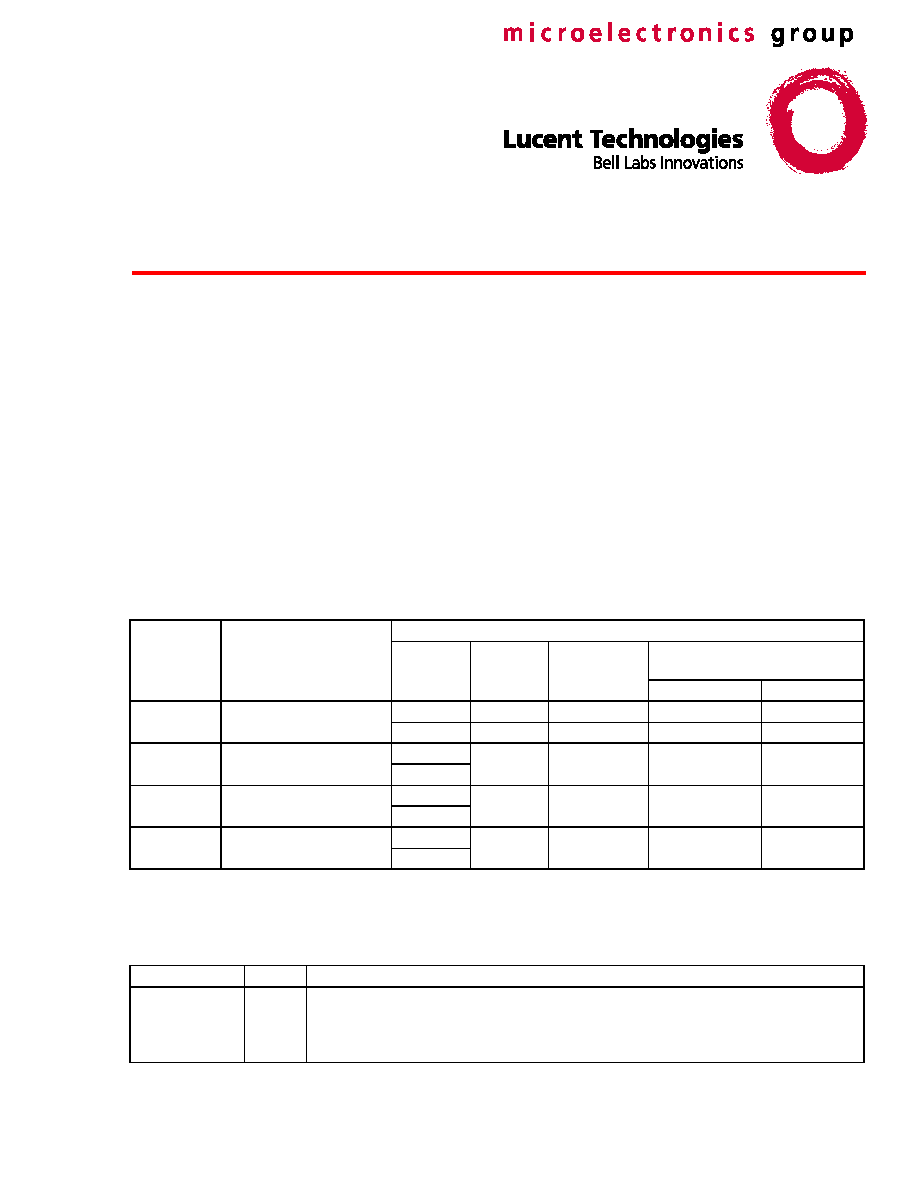
Advisory
May 1999
DRAFT COPY
Clarification to the Serial I/O Control Register
Description for the DSP1620/27/28/29 Devices
Active Clock Frequency
The purpose of this advisory is to clarify the function of the serial I/O control registers in the DSP1620/27/28/29
devices. Specifically, it clarifies the function of the control register field that specifies the active clock frequency.
The device data sheets state that the active clock frequency is a ratio of the input clock frequency on the CKI
pin (DSP1627/28/29 devices) or the output clock frequency on the CKO pin (DSP1620 device). For all four
devices, the actual active clock frequency is a ratio of the internal clock frequency, which can be programmed
as either the input clock frequency on the CKI pin or the output of an internal clock synthesizer (PLL).
Table 1
summarizes information for each of the four devices. It lists the document number for each device data
sheet. For example, the data sheet for the DSP1620, entitled
DSP1620 Digital Signal Processor
, has the docu-
ment number DS97-321WDSP.
Table 1
also lists the name of each serial I/O unit on each device, the corre-
sponding control register, the data sheet page number that describes the register, and the corresponding field
within the register that specifies the active clock frequency. For example, the DSP1620 contains two serial I/O
units named SIO and SSIO. The control register for SIO is sioc described on page 94 of the data sheet.
Bits 8--7 within sioc (CLK1 field) specify the active clock frequency of the SIO.
Table 2
shows a corrected description of the CLK/CLK1/CLK2 field of the serial I/O control register. The
specific correction is shown in bold type--the active clock frequency is a ratio of f
internal clock
, not of CKI or CKO.
Table 1. Data Sheet and Serial I/O Information for the DSP1620/27/28/29 Devices
Device
Data Sheet
Document Number
Serial I/O Units
Name
Control
Register
Data Sheet
Page No.
Active Clock Frequency
Control Field
Bits
Name
DSP1620
DS97-321WDSP
SIO
sioc
94
8--7
CLK1
SSIO
SSIOC
96
8--7
CLK2
DSP1627
DS96-188WDSP
SIO
sioc
45
8--7
CLK
SIO2
DSP1628
DS97-040WDSP
SIO
sioc
55
8--7
CLK
SIO2
DSP1629
DS96-039WDSP
SIO
sioc
46
8--7
CLK
SIO2
Table 2. Corrected Description of CLK/CLK1/CLK2 Field
Field
Value
Description
CLK
CLK1
CLK2
00
01
10
11
Active clock frequency = f
internal clock
˜
2
Active clock frequency = f
internal clock
˜
6
Active clock frequency = f
internal clock
˜
8
Active clock frequency = f
internal clock
˜
10

Lucent Technologies Inc. reserves the right to make changes to the product(s) or information contained herein without notice. No liability is assumed as a result of their use or application. No
rights under any patent accompany the sale of any such product(s) or information.
Copyright © 1999 Lucent Technologies Inc.
All Rights Reserved
May 1999
AY99-001WDSP
(must accompany DS97-321WDSP, DS96-188WDSP, DS97-040WDSP, and DS96-039WDSP)
For additional information, contact your Microelectronics Group Account Manager or the following:
INTERNET:
http://www.lucent.com/micro
E-MAIL:
docmaster@micro.lucent.com
N. AMERICA:
Microelectronics Group, Lucent Technologies Inc., 555 Union Boulevard, Room 30L-15P-BA, Allentown, PA 18103
1-800-372-2447, FAX 610-712-4106 (In CANADA: 1-800-553-2448, FAX 610-712-4106)
ASIA PACIFIC: Microelectronics Group, Lucent Technologies Singapore Pte. Ltd., 77 Science Park Drive, #03-18 Cintech III, Singapore 118256
Tel. (65) 778 8833, FAX (65) 777 7495
CHINA:
Microelectronics Group, Lucent Technologies (China) Co., Ltd., A-F2, 23/F, Zao Fong Universe Building, 1800 Zhong Shan Xi Road, Shanghai
200233 P. R. China Tel. (86) 21 6440 0468, ext. 316, FAX (86) 21 6440 0652
JAPAN:
Microelectronics Group, Lucent Technologies Japan Ltd., 7-18, Higashi-Gotanda 2-chome, Shinagawa-ku, Tokyo 141, Japan
Tel. (81) 3 5421 1600, FAX (81) 3 5421 1700
EUROPE:
Data Requests: MICROELECTRONICS GROUP DATALINE: Tel. (44) 1189 324 299, FAX (44) 1189 328 148
Technical Inquiries: GERMANY: (49) 89 95086 0 (Munich), UNITED KINGDOM: (44) 1344 865 900 (Ascot),
FRANCE: (33) 1 40 83 68 00 (Paris), SWEDEN: (46) 8 594 607 00 (Stockholm), FINLAND: (358) 9 4354 2800 (Helsinki),
ITALY: (39) 02 6608131 (Milan), SPAIN: (34) 1 807 1441 (Madrid)

Preliminary Data Sheet
February 1997
DSP1628 Digital Signal Processor
1 Features
s
Optimized for digital cellular applications with a bit
manipulation unit for higher coding efficiency and
an error correction coprocessor for equalization
and channel coding support.
s
On-chip, programmable, PLL clock synthesizer.
s
19.2 ns and 12.5 ns instruction cycle times at
2.7 V.
s
Mask-programmable memory map option: The
DSP1628x16 features 16 Kwords on-chip dual-
port RAM. The DSP1628x08 features 8 Kwords
on-chip dual-port RAM. Both feature 48 Kwords
on-chip ROM with a secure option.
s
Low power consumption:
-- <1.9 mW/MIPS typical at 2.7 V.
s
Flexible power management modes:
--Standard sleep: 0.2 mW/MIPS at 2.7 V.
--Sleep with slow internal clock: 0.7 mW at 2.7 V.
--Hardware STOP (pin halts DSP): <20
µ
A.
s
Mask-programmable clock options: small signal,
and CMOS.
s
144 PBGA package (13 mm x 13 mm) available.
s
Sequenced accesses to X and Y external
memory.
s
Object code compatible with the DSP1618.
s
Single-cycle squaring.
s
16 x 16-bit multiplication and 36-bit accumulation
in one instruction cycle.
s
Instruction cache for high-speed, program-
efficient, zero-overhead looping.
s
Dual 25 Mbit/s serial I/O ports with multiprocessor
capability--16-bit data channel, 8-bit protocol
channel.
s
8-bit parallel host interface
-- Supports 8- or 16-bit transfers.
--
Motorola
*
or
Intel
compatible.
s
8-bit control I/O interface.
s
256 memory-mapped I/O ports.
s
IEEE
P1149.1 test port (JTAG boundary scan).
s
Full-speed in-circuit emulation hardware develop-
ment system on-chip.
s
Supported by DSP1628 software and hardware
development tools.
2 Description
The DSP1628 digital signal processor offers 80 MIPS
and 52 MIPS operation at 2.7 V. Designed specifically
for applications requiring low power dissipation in dig-
ital cellular systems, the DSP1628 is a signal-coding
device that can be programmed to perform a wide
variety of fixed-point signal processing functions. The
device is based on the DSP1600 core with a bit
manipulation unit for enhanced signal coding effi-
ciency, an external memory sequencer, an error cor-
rection coprocessor (ECCP) for more efficient Viterbi
decoding, and an 8-bit parallel host interface for hard-
ware flexibility. The DSP1628 includes a mix of
peripherals specifically intended to support process-
ing-intensive but cost-sensitive applications in the
area of digital wireless communications.
The DSP1628x16 contains 16 Kwords of internal
dual-port RAM (DPRAM), which allows simultaneous
access to two RAM locations in a single instruction cy-
cle. The DSP1628x08 supports the use of 8 Kwords
of DPRAM. Both devices contain 48 Kwords of inter-
nal ROM (IROM).
The DSP1628 is object code compatible with the
DSP1618, while providing more memory. The
DSP1628 is pin compatible with the DSP1627. Note
that TRST (JTAG test reset), replaces a V
DD
pin.
The DSP1628 supports 2.7 V operation with flexible
power management modes required for portable cel-
lular terminals. Several control mechanisms achieve
low-power operation, including a STOP pin for placing
the DSP into a fully static, halted state and a program-
mable power control register used to power down un-
used on-chip I/O units. These power management
modes allow for trade-offs between power reduction
and wake-up latency requirements. During system
standby, power consumption is reduced to less than
20
µ
A.
The on-chip clock synthesizer can be driven by an
external clock whose frequency is a fraction of the
instruction rate.
The device is packaged in a 144-pin PBGA, a 100-pin
BQFP, or a 100-pin TQFP and is available with
19.2 ns and 12.5 ns instruction cycle times at 2.7 V.
*
Motorola
is a registered trademark of Motorola, Inc.
Intel
is a registered trademark of Intel Corporation.
IEEE
is a registered trademark of The Institute of Electrical
and Electronics Engineers, Inc.

Preliminary Data Sheet
DSP1628 Digital Signal Processor
February 1997
2
Lucent Technologies Inc.
Table of Contents
Contents
Page
1 Features ................................................................... 1
2 Description ............................................................... 1
3 Pin Information ......................................................... 3
4 Hardware Architecture.............................................. 8
4.1 DSP1628 Architectural Overview....................... 8
4.2 DSP1600 Core Architectural Overview ............ 12
4.3 Interrupts and Trap........................................... 13
4.4 Memory Maps and Wait-States........................ 18
4.5 External Memory Interface (EMI) ..................... 21
4.6 Bit Manipulation Unit (BMU)............................. 22
4.7 Serial I/O Units (SIOs)...................................... 22
4.8 Parallel Host Interface (PHIF) .......................... 24
4.9 Bit Input/Output Unit (BIO) ............................... 25
4.10 Timer .............................................................. 26
4.11 Error Correction Coprocessor (ECCP)........... 26
4.12 JTAG Test Port .............................................. 34
4.13 Clock Synthesis.............................................. 36
4.14 Power Management ....................................... 39
5 Software Architecture ............................................. 46
5.1 Instruction Set .................................................. 46
5.2 Register Settings.............................................. 55
5.3 Instruction Set Formats .................................... 66
6 Signal Descriptions................................................. 72
6.1 System Interface .............................................. 72
6.2 External Memory Interface ............................... 74
6.3 Serial Interface #1 ............................................ 75
6.4 Parallel Host Interface or Serial
Interface #2 and Control I/O Interface.............. 76
6.5 Control I/O Interface......................................... 76
6.6 JTAG Test Interface ......................................... 77
7 Mask-Programmable Options................................. 78
7.1 Input Clock Options.......................................... 78
7.2 Memory Map Options....................................... 78
7.3 ROM Security Options ..................................... 78
8 Device Characteristics............................................ 79
8.1 Absolute Maximum Ratings ............................. 79
8.2 Handling Precautions ....................................... 79
8.3 Recommended Operating Conditions .............. 79
8.4 Package Thermal Considerations ....................80
9 Electrical Characteristics and Requirements.......... 81
9.1 Power Dissipation ............................................ 84
Contents
Page
10 Timing Characteristics for 2.7 V Operation........... 86
10.1 DSP Clock Generation ................................... 87
10.2 Reset Circuit................................................... 88
10.3 Reset Synchronization ................................... 89
10.4 JTAG I/O Specifications ................................. 90
10.5 Interrupt .......................................................... 91
10.6 Bit Input/Output (BIO)..................................... 92
10.7 External Memory Interface ............................. 93
10.8 PHIF Specifications ........................................ 97
10.9 Serial I/O Specifications ............................... 103
10.10 Multiprocessor Communication .................. 108
11 Outline Diagrams................................................ 109
11.1 100-Pin BQFP (Bumpered Quad
Flat Pack) .................................................... 109
11.2 100-Pin TQFP (Thin Quad Flat Pack) .......... 110
11.3 144-Pin PBGA (Plastic Ball Grid Array)........ 111
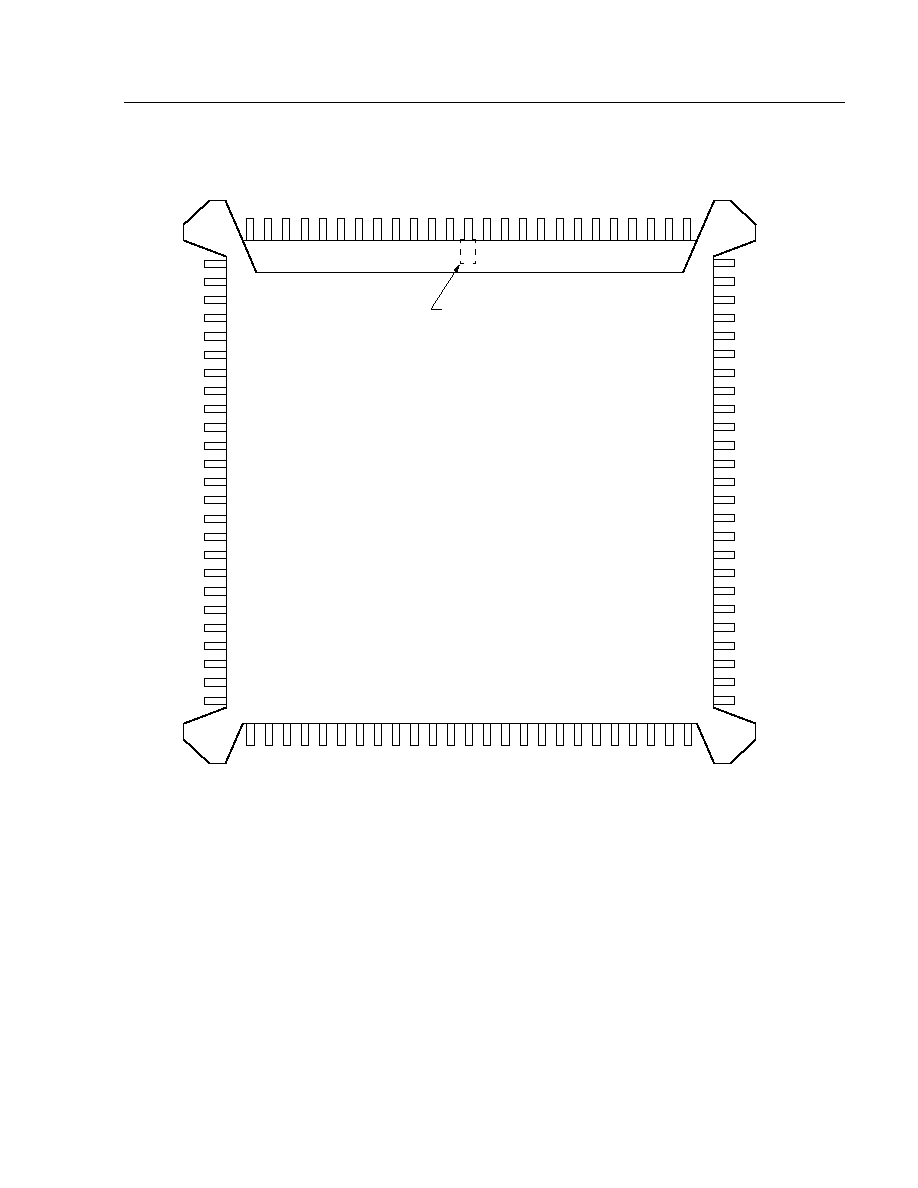
Preliminary Data Sheet
February 1997
DSP1628 Digital Signal Processor
Lucent Technologies Inc.
3
3 Pin Information
* Note the difference from the DSP1627 pinout.
Figure 1. DSP1628 BQFP Pin Diagram
DSP1628
20
9
30
90
80
70
V
SS
SYNC1
DO1
OLD1
OCK1
ICK1
ILD1
V
SS
DI1
V
DD
IBF1
OBE1
DB15
DB14
DB13
DB12
DB11
DB10
DB9
DB8
DB7
DB6
DB5
V
DD
V
SS
DB4
DB2
DB1
DB0
V
SS
IO
DB3
V
SS
V
DD
AB11
AB10
AB9
AB8
AB7
V
SS
ERAMHI
EROM
RWN
EXM
AB14
AB12
ERAMLO
V
DD
SADD1
DOEN1
OCK2/PCSN
DO2/PSTAT
SYNC2/PBSEL
ILD2/PIDS
OLD2/PODS
IBF2/PIBF
OBE2/POBE
DI2/PB1
V
SS
DOEN2/PB2
SADD2/PB3
TRST
*
IOBIT0/PB4
IOBIT1/PB5
IOBIT2/PB6
IOBIT3/PB7
VEC3/IOBIT4
VEC2/IOBIT5
VEC1/IOBIT6
VEC0/IOBIT7
V
SS
ICK2/PB0
V
SSA
CKI2
CKI
V
DDA
TDO
TMS
V
DD
CKO
TRAP
STOP
IACK
V
SS
INT0
INT1
AB0
AB1
AB2
AB3
AB4
AB5
AB6
RSTB
TCK
100
V
DD
60
50
40
PIN #1
IDENTIFIER
ZONE
TDI
AB13
V
DD
AB15
10
11
12
13
8
7
6
5
4
3
2
1
14
15
16
17
18
19
21
22
23
24
25
26
27
28
29
31
32
33
34
35
36
37
38
39
41
42
43
44
45
46
47
48
49
51
52
53
54
55
56
57
58
59
61
62
63
64
65
66
67
68
69
71
72
73
74
75
76
77
78
79
81
82
83
84
85
86
87
88
89
91
92
93
94
95
96
97
98
99
5-4218 (F).c

Preliminary Data Sheet
DSP1628 Digital Signal Processor
February 1997
4
Lucent Technologies Inc.
3 Pin Information
(continued)
* Note the difference from the DSP1627 pinout.
Figure 2. DSP1628 TQFP Pin Diagram
V
DD
DB5
DB6
DB7
DB8
DB9
DB10
V
SS
DB11
DB12
DB13
DB14
DB15
V
DD
OBE1
IBF1
V
SS
DI1
ILD1
ICK1
OCK1
OLD1
DO1
SYNC1
V
SS
100
90
80
V
DD
AB6
AB5
AB4
AB3
AB2
AB0
INT1
INT0
V
SS
IA
CK
ST
OP
TRAP
RSTB
CK
O
V
DD
TCK
TMS
TDO
TDI
V
DD
A
CKI
CKI2
V
SSA
AB1
30
40
50
60
70
V
DD
SADD1
DOEN1
OCK2/PCSN
DO2/PSTAT
SYNC2/PBSEL
ILD2/PIDS
OLD2/PODS
IBF2/PIBF
OBE2/POBE
ICK2/PB0
V
SS
DOEN2/PB2
SADD2/PB3
TRST
*
IOBIT0/PB4
IOBIT1/PB5
IOBIT2/PB6
IOBIT3/PB7
VEC3/IOBIT4
VEC2/IOBIT5
VEC1/IOBIT6
VEC0/IOBIT7
V
SS
DI2/PB1
V
SS
DB4
DB3
DB2
DB1
DB0
IO
ERAMHI
V
DD
ERAMLO
ERAM
RWN
V
SS
EXM
AB15
AB14
V
DD
AB13
AB12
AB11
AB10
AB9
AB8
AB7
V
SS
1
10
20
DSP1628
71
72
73
74
75
61
62
63
64
65
66
67
68
69
76
77
78
79
59
58
57
56
55
54
53
52
51
41
42
43
44
45
46
47
48
49
31
32
33
34
35
36
37
38
39
29
28
27
26
21
22
23
24
25
11
12
13
14
15
16
17
18
19
2
3
4
5
6
7
8
9
81
82
83
84
85
86
87
88
89
91
92
93
94
95
96
97
98
99
5-4219 (F).c

Preliminary Data Sheet
February 1997
DSP1628 Digital Signal Processor
Lucent Technologies Inc.
5
3 Pin Information
(continued)
5-5224 (C)
Note: Solder balls viewed thru package.
Figure 3. 144-Pin Plastic Ball Grid Array (Top View)
M
L
K
J
H
G
F
E
D
C
B
A
1
2
3
4
5
6
7
8
9
10
11
12
V
DDA
V
SSA
V
DD
V
SS
SPARE PACKAGE BALLS
SHOULD BE TIED TO
"SOFT GND" OR "SIG GND"

Preliminary Data Sheet
DSP1628 Digital Signal Processor
February 1997
6
Lucent Technologies Inc.
3 Pin Information
(continued)
Functional descriptions of pins 1--100 are found in Section 6, Signal Descriptions. The functionality of CKI and CKI2
pins are mask-programmable (see Section 7, Mask-Programmable Options). Input levels on all I and I/O type pins
are designed to remain at full CMOS levels when not driven by the DSP.
*
3-states when RSTB = 0, or by JTAG control.
3-states when RSTB = 0 and INT0 = 1. Output = 1 when RSTB = 0 and INT0 = 0, except CKO which is free-running.
Pull-up devices on input.
ß
3-states by JTAG control.
** See Section 7, Mask-Programmable Options.
For SIO multiprocessor applications, add 5 k
external pull-up resistors to SADD1 and/or SADD2 for proper initialization.
Table 1. Pin Descriptions
PBGA Pin
BQFP Pin TQFP Pin
Symbol
Type
Name/Function
B6, A6, B5,
A5, B4, A4,
B3, A3, B2,
A2, A1, B1,
C2, C1, C3,
D1
1, 2, 3, 4,
5, 7, 8, 9,
10, 11, 12,
15, 16, 17,
18, 19
88, 89, 90,
91, 92, 94,
95, 96, 97,
98, 99, 2,
3, 4, 5, 6
DB[15:0]
I/O*
External Memory Data Bus 15--0.
D2
20
7
IO
O
Data Address 0x4000 to 0x40FF I/O Enable.
E1
21
8
ERAMHI
O
Data Address 0x8000 to 0xFFFF External RAM
Enable.
E2
23
10
ERAMLO
O
Data Address 0x4100 to 0x7FFF External RAM
Enable.
F1
24
11
EROM
O
Program Address External ROM Enable.
F2
25
12
RWN
O
Read/Write Not.
G1
27
14
EXM
I
External ROM Enable.
G2, H1, H2,
J1, J2, K1,
K2, L1, L2,
M1, K3, M2,
L3, M3, L4,
M4
28, 29, 31,
32, 33, 34,
35, 36, 37,
40, 41, 42,
43, 44, 45,
46
15, 16, 18,
19, 20, 21,
22, 23, 24,
27, 28, 29,
30, 31, 32,
33
AB[15:0]
O*
External Memory Address Bus 15--0.
L5
47
34
INT1
I
Vectored Interrupt 1.
M5
48
35
INT0
I
Vectored Interrupt 0.
L6
50
37
IACK
O*
Interrupt Acknowledge.
M6
51
38
STOP
I
STOP Input Clock.
L7
52
39
TRAP
I/O*
Nonmaskable Program Trap/Breakpoint Indication.
M7
53
40
RSTB
I
Reset Bar.
L8
54
41
CKO
O
Processor Clock Output.
M8
56
43
TCK
I
JTAG Test Clock.
L9
57
44
TMS
I
JTAG Test Mode Select.
M9
58
45
TDO
O
ß
JTAG Test Data Output.
L10
59
46
TDI
I
JTAG Test Data Input.
Mask-Programmable Input Clock Option
CMOS
Small Signal
L11
61
48
CKI**
I
CKI
VAC
M11
62
49
CKI2**
I
V
SSA
VCM
K10
65
52
VEC0/IOBIT7
I/O*
Vectored Interrupt Indication 0/Status/Control Bit 7.
L12
66
53
VEC1/IOBIT6
I/O*
Vectored Interrupt Indication 1/Status/Control Bit 6.
K11
67
54
VEC2/IOBIT5
I/O*
Vectored Interrupt Indication 2/Status/Control Bit 5.
K12
68
55
VEC3/IOBIT4
I/O*
Vectored Interrupt Indication 3/Status/Control Bit 4.
J11
69
56
IOBIT3/PB7
I/O*
Status/Control Bit 3/PHIF Data Bus Bit 7.
J12
70
57
IOBIT2/PB6
I/O*
Status/Control Bit 2/PHIF Data Bus Bit 6.

Preliminary Data Sheet
February 1997
DSP1628 Digital Signal Processor
Lucent Technologies Inc.
7
3 Pin Information
(continued)
Functional descriptions of pins 1--100 are found in Section 6, Signal Descriptions.
*
3-states when RSTB = 0, or by JTAG control.
3-states when RSTB = 0 and INT0 = 1. Output = 1 when RSTB = 0 and INT0 = 0, except CKO which is free-running.
Pull-up devices on input.
ß
3-states by JTAG control.
** See Section 7, Mask-Programmable Options.
For SIO multiprocessor applications, add 5 k
external pull-up resistors to SADD1 and/or SADD2 for proper initialization.
Table 1. Pin Descriptions
(continued)
PBGA Pin
BQFP Pin TQFP Pin
Symbol
Type
Name/Function
H11
71
58
IOBIT1/PB5
I/O*
Status/Control Bit 1/PHIF Data Bus Bit 5.
H12
72
59
IOBIT0/PB4
I/O*
Status/Control Bit 0/PHIF Data Bus Bit 4.
G11
73
60
TRST
I
JTAG Test Reset.
G12
74
61
SADD2/PB3
I/O*
SIO2 Multiprocessor Address/PHIF Data Bus
Bit 3.
F11
75
62
DOEN2/PB2
I/O*
SIO2 Data Output Enable/PHIF Data Bus Bit 2.
F12
77
64
DI2/PB1
I/O*
SIO2 Data Input/PHIF Data Bus Bit 1.
E11
78
65
ICK2/PB0
I/O*
SIO2 Input Clock/PHIF Data Bus Bit 0.
E12
79
66
OBE2/POBE
O*
SIO2 Output Buffer Empty/PHIF Output Buffer
Empty.
D11
80
67
IBF2/PIBF
O*
SIO2 Input Buffer Full/PHIF Input Buffer Full.
D12
81
68
OLD2/PODS
I/O*
SIO2 Output Load/PHIF Output Data Strobe.
C11
82
69
ILD2/PIDS
I/O*
SIO2 Input Load/PHIF Input Data Strobe.
C12
83
70
SYNC2/PBSEL
I/O*
SIO2 Multiprocessor Synchronization/PHIF
Byte Select.
C10
84
71
DO2/PSTAT
I/O*
SIO2 Data Output/PHIF Status Register Select.
B12
85
72
OCK2/PCSN
I/O*
SIO2 Output Clock/PHIF Chip Select Not.
B11
86
73
DOEN1
I/O*
SIO1 Data Output Enable.
A12
87
74
SADD1
I/O*
SIO1 Multiprocessor Address.
A11
90
77
SYNC1
I/O*
SIO1 Multiprocessor Synchronization.
B10
91
78
DO1
O*
SIO1 Data Output.
A10
92
79
OLD1
I/O*
SIO1 Output Load.
B9
93
80
OCK1
I/O*
SIO1 Output Clock.
A9
94
81
ICK1
I/O*
SIO1 Input Clock.
B8
95
82
ILD1
I/O*
SIO1 Input Load.
A8
96
83
DI1
I
SIO1 Data Input.
B7
98
85
IBF1
O*
SIO1 Input Buffer Full.
A7
99
86
OBE1
O*
SIO1 Output Buffer Empty.
D4, D5, D6, D7, D8,
E4, E5, E6, E7, E8,
E9, F4, F5, F6, F7,
F8, F9, G4, G5, G6,
G7, G8, G9, H4,
H5, H6, H7, H8, H9,
J4, J5, J6, J7, J8, J9
6, 14, 26,
38, 49, 64,
76, 89, 97
93, 1, 13,
25, 36, 51,
63, 76, 84
V
SS
P
Ground.
C4, C5, C6, C7, C8,
D3, D9, D10, E3,
E10, F3, F10, G3,
G10, H3, H10, J3,
J10, K4, K5, K6, K7,
K8, K9,
13, 22, 30,
39, 55, 88,
100
100, 9, 17,
26, 42, 75,
87
V
DD
P
Power Supply.
M10
60
47
V
DDA
P
Analog Power Supply.
M12
63
50
V
SSA
P
Analog Ground.
C9
--
--
--
--
No Die Connect--unused.

Preliminary Data Sheet
DSP1628 Digital Signal Processor
February 1997
8
Lucent Technologies Inc.
4 Hardware Architecture
The DSP1628 device is a 16-bit, fixed-point program-
mable digital signal processor (DSP). The DSP1628
consists of a DSP1600 core together with on-chip mem-
ory and peripherals. Added architectural features give
the DSP1628 high program efficiency for signal coding
applications.
4.1 DSP1628 Architectural Overview
Figure 4 shows a block diagram of the DSP1628. The
following modules make up the DSP1628.
DSP1600 Core
The DSP1600 core is the heart of the DSP1628 chip.
The core contains data and address arithmetic units,
and control for on-chip memory and peripherals. The
core provides support for external memory wait-states
and on-chip dual-port RAM and features vectored inter-
rupts and a trap mechanism.
Dual-Port RAM (DPRAM)
The DSP1628x16 contains 16 banks of zero wait-state
memory and the DSP1628x08 contains 8 banks of zero
wait-state memory. Each bank consists of 1K 16-bit
words and has separate address and data ports to the
instruction/coefficient and data memory spaces. A pro-
gram can reference memory from either space. The
DSP1600 core automatically performs the required mul-
tiplexing. If references to both ports of a single bank are
made simultaneously, the DSP1600 core automatically
inserts a wait-state and performs the data port access
first, followed by the instruction/coefficient port access.
A program can be downloaded from slow, off-chip mem-
ory into DPRAM, and then executed without wait-states.
DPRAM is also useful for improving convolution perfor-
mance in cases where the coefficients are adaptive.
Since DPRAM can be downloaded through the JTAG
port, full-speed remote in-circuit emulation is possible.
DPRAM can also be used for downloading self-test
code via the JTAG port.
Read-Only Memory (ROM)
The DSP1628 contains 48K 16-bit words of zero wait-
state mask-programmable ROM for program and fixed
coefficients.
External Memory Multiplexer (EMUX)
The EMUX is used to connect the DSP1628 to external
memory and I/O devices. It supports read/write opera-
tions from/to instruction/coefficient memory (X memory
space) and data memory (Y memory space). The
DSP1600 core automatically controls the EMUX. In-
structions can transparently reference external memory
from either set of internal buses. A sequencer allows a
single instruction to access both the X and the Y exter-
nal memory spaces.
Clock Synthesis
The DSP powers up with a 1X input clock (CKI/CKI2) as
the source for the processor clock. An on-chip clock
synthesizer (PLL) can also be used to generate the sys-
tem clock for the DSP, which will run at a frequency mul-
tiple of the input clock. The clock synthesizer is
deselected and powered down on reset. For low-power
operation, an internally generated slow clock can be
used to drive the DSP. If both the clock synthesizer and
the internally generated slow clock are selected, the
slow clock will drive the DSP; however, the synthesizer
will continue to run.
The clock synthesizer and other programmable clock
sources are discussed in Section 4.13. The use of these
programmable clock sources for power management is
discussed in Section 4.14.

Preliminary Data Sheet
February 1997
DSP1628 Digital Signal Processor
Lucent Technologies Inc.
9
4 Hardware Architecture
(continued)
Bit Manipulation Unit (BMU)
The BMU extends the DSP1600 core instruction set to
provide more efficient bit operations on accumulators.
The BMU contains logic for barrel shifting, normaliza-
tion, and bit field insertion/extraction. The unit also con-
tains a set of 36-bit alternate accumulators. The data in
the alternate accumulators can be shuffled with the data
in the main accumulators. Flags returned by the BMU
mesh seamlessly with the DSP1600 conditional instruc-
tions.
Error Correction Coprocessor (ECCP)
The ECCP performs full Viterbi decoding with instruc-
tions for MLSE equalization and convolutional decod-
ing. It is designed for 2-tap to 6-tap MLSE equalization
with Euclidean branch metrics and rate 1/1 to 1/6 con-
volutional decoding using constraint lengths from 2 to 7
with Euclidean or Manhattan branch metrics. Two vari-
ants of soft-decoded symbols, as well as hard-decoded
symbols may be programmed. The ECCP operates in
parallel with the DSP1600 core, increasing the through-
put rate. Single instruction Viterbi decoding provides
significant code compression required for single DSP
solutions in modern digital cellular applications. The
ECCP is the source of two interrupts and one flag to the
DSP1600 core.
Bit Input/Output (BIO)
The BIO provides convenient and efficient monitoring
and control of eight individually configurable pins. When
configured as outputs, the pins can be individually set,
cleared, or toggled. When configured as inputs, individ-
ual pins or combinations of pins can be tested for pat-
terns. Flags returned by the BIO mesh seamlessly with
conditional instructions.
Serial Input/Output Units (SIO and SIO2)
SIO and SIO2 offer asynchronous, full-duplex, double-
buffered channels that operate at up to 25 Mbits/s (for
20 ns instruction cycle in a nonmultiprocessor configu-
ration), and easily interface with other Lucent Technol-
ogies fixed-point DSPs in a multiple-processor
environment. Commercially available codecs and time-
division multiplex (TDM) channels can be interfaced to
the serial I/O ports with few, if any, additional compo-
nents. SIO2 is identical to SIO.
An 8-bit serial protocol channel may be transmitted in
addition to the address of the called processor in multi-
processor mode. This feature is useful for transmitting
high-level framing information or for error detection and
correction. SIO2 and BIO are pin-multiplexed with the
PHIF.
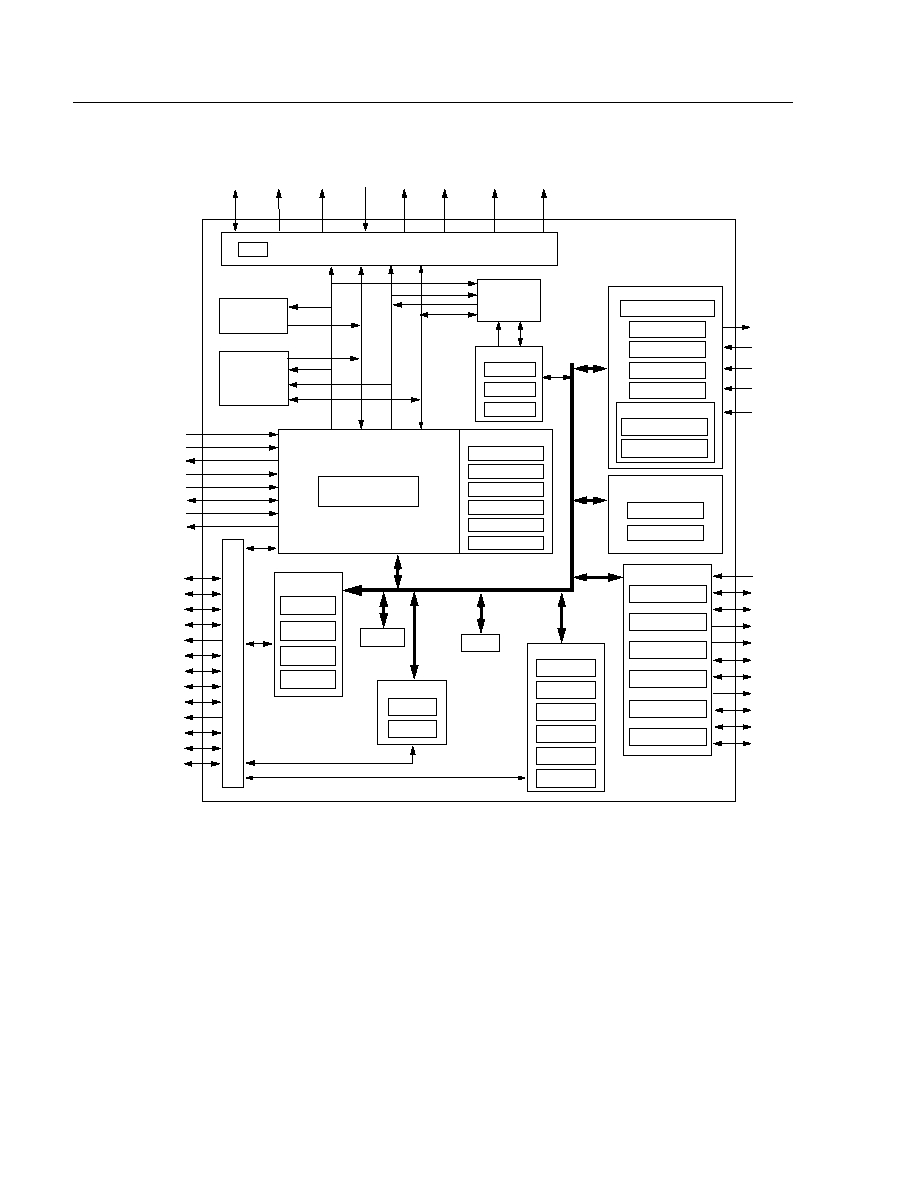
Preliminary Data Sheet
DSP1628 Digital Signal Processor
February 1997
10
Lucent Technologies Inc.
4 Hardware Architecture
(continued)
* These registers are accessible through the pins only.
16K x 16 for the DSP1628x16, 8K x 16 for the DSP1628x08.
Figure 4. DSP1628 Block Diagram
TDO
TCK
TMS
M
U
X
DSP1600 CORE
RWN
EXM
EROM
ERAMHI
AB[15:0]
DB[15:0]
I/O
VEC[3:0] OR IOBIT[7:4]
DO2 OR PSTAT
OLD2 OR PODS
OCK2 OR PCSN
OBE2 OR POBE
SYNC2 OR PBSEL
ICK2 OR PB0
ILD2 OR PIDS
DI2 OR PB1
IBF2 OR PIBF
DOEN2 OR PB2
SADD2 OR PB3
IO BIT[3:0] OR PB[7:4]
CKI
CKI2
CKO
RSTB
STOP
TRAP
INT[1:0]
IACK
DI1
ICK1
ILD1
IBF1
DO1
OCK1
OLD1
OBE1
SYNC1
SADD1
DOEN1
EXTERNAL MEMORY INTERFACE & EMUX
ioc
48K x 16
RAM4
1K x 16
ERAMLO
YAB
YDB
XDB
XAB
BMU
aa0
aa1
ar0
ar1
ar2
ar3
IDB
PHIF
phifc
PSTAT*
pdx0(IN)
pdx0(OUT)
BIO
sbit
cbit
SIO2
sdx2(OUT)
srta2
tdms2
sdx2(IN)
sioc2
saddx2
SIO
sdx(OUT)
srta
tdms
sdx(IN)
sioc
saddx
TIMER
timerc
timer0
HDS
BREAK POINT*
JTAG
BOUNDARY SCAN*
jtag
JCON*
ID*
BYPASS*
TRACE*
powerc
TDI
pllc
TRST
5-4142 (F).f
DUAL-PORT
RAM
15/7K x 16
ROM
ECCP
eir
ear
edr
[16/8:5,3:1]

Preliminary Data Sheet
February 1997
DSP1628 Digital Signal Processor
Lucent Technologies Inc.
11
4 Hardware Architecture
(continued)
Table 2. DSP1628 Block Diagram Legend
Symbol
Name
aa<0--1>
Alternate Accumulators.
ar<0--3>
Auxiliary BMU Registers.
BIO
Bit Input/Output Unit.
BMU
Bit Manipulation Unit.
BREAKPOINT
Four Instruction Breakpoint Registers.
BYPASS
JTAG Bypass Register.
cbit
Control Register for BIO.
Dual-Port RAM
Internal RAM (16 Kwords for DSP1628x16, 8 Kwords for DSP1628x08).
ECCP
Error Correction Coprocessor.
ear
Error Correction Coprocessor Address Register.
edr
Error Correction Coprocessor Data Register.
eir
Error Correction Coprocessor Instruction Register.
EMUX
External Memory Multiplexer.
HDS
Hardware Development System.
ID
JTAG Device Identification Register.
IDB
Internal Data Bus.
ioc
I/O Configuration Register.
JCON
JTAG Configuration Registers.
jtag
16-bit Serial/Parallel Register.
pdx0(in)
Parallel Data Transmit Input Register 0.
pdx0(out)
Parallel Data Transmit Output Register 0.
PHIF
Parallel Host Interface.
phifc
Parallel Host Interface Control Register.
pllc
Phase-Locked Loop Control Register.
powerc
Power Control Register.
PSTAT
Parallel Host Interface Status Register.
saddx
Multiprocessor Protocol Register.
saddx2
Multiprocessor Protocol Register for SIO2.
sbit
Status Register for BIO.
sdx(in)
Serial Data Transmit Input Register.
sdx2(in)
Serial Data Transmit Input Register for SIO2.
sdx(out)
Serial Data Transmit Output Register.
sdx2(out)
Serial Data Transmit Output Register for SIO2.
SIO
Serial Input/Output Unit.
SIO2
Serial Input/Output Unit #2.
sioc
Serial I/O Control Register.
sioc2
Serial I/O Control Register for SIO2.
srta
Serial Receive/Transmit Address Register.
srta2
Serial Receive/Transmit Address Register for SIO2.
tdms
Serial I/O Time-division Multiplex Signal Control Register.
tdms2
Serial I/O Time-division Multiplex Signal Control Register for SIO2.
TIMER
Programmable Timer.
timer0
Timer Running Count Register.
timerc
Timer Control Register.
TRACE
Program Discontinuity Trace Buffer.
XAB
Program Memory Address Bus.
XDB
Program Memory Data Bus.
YAB
Data Memory Address Bus.
YDB
Data Memory Data Bus.

Preliminary Data Sheet
DSP1628 Digital Signal Processor
February 1997
12
Lucent Technologies Inc.
4 Hardware Architecture
(continued)
Parallel Host Interface (PHIF)
The PHIF is a passive, 8-bit parallel port which can in-
terface to an 8-bit bus containing other Lucent Technol-
ogies DSPs (e.g., DSP1620, DSP1627, DSP1628,
DSP1629, DSP1611, DSP1616, DSP1617, DSP1618),
microprocessors, or peripheral I/O devices. The PHIF
port supports either
Motorola or Intel protocols, as well
as 8-bit or 16-bit transfers, configured in software. The
port data rate depends upon the instruction cycle rate.
A 25 ns instruction cycle allows the PHIF to support
data rates up to 11.85 Mbytes/s, assuming the external
host device can transfer 1 byte of data in 25 ns.
The PHIF is accessed in two basic modes, 8-bit or
16-bit mode. In 16-bit mode, the host determines an ac-
cess of the high or low byte. In 8-bit mode, only the low
byte is accessed. Software-programmable features al-
low for a glueless host interface to microprocessors
(see Section 4.8, Parallel Host Interface).
Timer
The timer can be used to provide an interrupt at the ex-
piration of a programmed interval. The interrupt may be
single or repetitive. More than nine orders of magnitude
of interval selection are provided. The timer may be
stopped and restarted at any time.
Hardware Development System (HDS) Module
The on-chip HDS performs instruction breakpointing
and branch tracing at full speed without additional off-
chip hardware. Using the JTAG port, the breakpointing
is set up, and the trace history is read back. The port
works in conjunction with the HDS code in the on-chip
ROM and the hardware and software in a remote com-
puter. The HDS code must be linked to the user's appli-
cation code and reside in the first 4 Kwords of ROM.
The on-chip HDS cannot be used with the secure ROM
masking option (see Section 7.2, ROM Security Op-
tions).
Four hardware breakpoints can be set on instruction ad-
dresses. A counter can be preset with the number of
breakpoints to receive before trapping the core. Break-
points can be set in interrupt service routines. Alternate-
ly, the counter can be preset with the number of cache
instructions to execute before trapping the core.
Every time the program branches instead of executing
the next sequential instruction, the addresses of the in-
structions executed before and after the branch are
caught in circular memory. The memory contains the
last four pairs of program discontinuities for hardware
tracing.
In systems with multiple processors, the processors
may be configured such that any processor reaching a
breakpoint will cause all the other processors to be
trapped (see Section 4.3, Interrupts and Trap).
Pin Multiplexing
In order to allow flexible device interfacing while main-
taining a low package pin count, the DSP1628 multi-
plexes 16 package pins between BIO, PHIF, VEC[3:0],
and SIO2.
Upon reset, the vectored interrupt indication signals,
VEC[3:0], are connected to the package pins while
IOBIT[4:7] are disconnected. Setting bit 12, EBIOH, of
the ioc register connects IOBIT[4:7] to the package pins
and disconnects VEC[3:0].
Upon reset, the parallel host interface (PHIF) is con-
nected to the package pins while the second serial port
(SIO2) and IOBIT[3:0] are disconnected. Setting bit 10,
ESIO2, of the ioc register connects the SIO2 and
IOBIT[3:0] and disconnects the PHIF.
Power Management
Many applications, such as portable cellular terminals,
require programmable sleep modes for power manage-
ment. There are three different control mechanisms for
achieving low-power operation: the powerc control
register, the STOP pin, and the AWAIT bit in the alf reg-
ister. The AWAIT bit in the alf register allows the pro-
cessor to go into a power-saving standby mode until an
interrupt occurs. The powerc register configures vari-
ous power-saving modes by controlling internal clocks
and peripheral I/O units. The STOP pin controls the in-
ternal processor clock. The various power management
options may be chosen based on power consumption
and/or wake-up latency requirements.
4.2 DSP1600 Core Architectural Overview
Figure 5 shows a block diagram of the DSP1600 core.
System Cache and Control Section (SYS)
This section of the core contains a 15-word cache mem-
ory and controls the instruction sequencing. It handles
vectored interrupts and traps, and also provides decod-
ing for registers outside of the DSP1600 core. SYS
stretches the processor cycle if wait-states are required
(wait-states are programmable for external memory ac-
cesses). SYS sequences downloading via JTAG of self-
test programs to on-chip, dual-port RAM.
The cache loop iteration count can be specified at run
time under program control as well as at assembly time.

Preliminary Data Sheet
February 1997
DSP1628 Digital Signal Processor
Lucent Technologies Inc.
13
4 Hardware Architecture
(continued)
Data Arithmetic Unit (DAU)
The data arithmetic unit (DAU) contains a 16 x 16-bit
parallel multiplier that generates a full 32-bit product in
one instruction cycle. The product can be accumulated
with one of two 36-bit accumulators. The accumulator
data can be directly loaded from, or stored to, memory
in two 16-bit words with optional saturation on overflow.
The arithmetic logic unit (ALU) supports a full set of
arithmetic and logical operations on either 16- or 32-bit
data. A standard set of flags can be tested for condition-
al ALU operations, branches, and subroutine calls. This
procedure allows the processor to perform as a power-
ful 16- or 32-bit microprocessor for logical and control
applications. The available instruction set is compatible
with the DSP1618 instruction set. See Section 5.1 for
more information on the instruction set.
The user also has access to two additional DAU regis-
ters. The psw register contains status information from
the DAU (see Table 30, Processor Status Word Regis-
ter). The arithmetic control register, auc, is used to con-
figure some of the features of the DAU (see Table 31)
including single-cycle squaring. The auc register align-
ment field supports an arithmetic shift left by one and
left or right by two. The auc register is cleared by reset.
The counters c0 to c2 are signed, 8 bits wide, and may
be used to count events such as the number of times
the program has executed a sequence of code. They
are controlled by the conditional instructions and pro-
vide a convenient method of program looping.
Y Space Address Arithmetic Unit (YAAU)
The YAAU supports high-speed, register-indirect, com-
pound, and direct addressing of data (Y) memory. Four
general-purpose, 16-bit registers, r0 to r3, are available
in the YAAU. These registers can be used to supply the
read or write addresses for Y space data. The YAAU
also decodes the 16-bit data memory address and out-
puts individual memory enables for the data access.
The YAAU can address the six 1 Kword banks of on-
chip DPRAM or three external data memory segments.
Up to 48 Kwords of off-chip RAM are addressable, with
16K addresses reserved for internal RAM.
Two 16-bit registers, rb and re, allow zero-overhead
modulo addressing of data for efficient filter implemen-
tations. Two 16-bit signed registers, j and k, are used to
hold user-defined postmodification increments. Fixed
increments of +1, ≠1, and +2 are also available. Four
compound-addressing modes are provided to make
read/write operations more efficient.
The YAAU allows direct (or indexed) addressing of data
memory. In direct addressing, the 16-bit base register
(ybase) supplies the 11 most significant bits of the ad-
dress. The direct data instruction supplies the remaining
5 bits to form an address to Y memory space and also
specifies one of 16 registers for the source or destina-
tion.
X Space Address Arithmetic Unit (XAAU)
The XAAU supports high-speed, register-indirect, in-
struction/coefficient memory addressing with postmodi-
fication of the register. The 16-bit pt register is used for
addressing coefficients. The signed register i holds a
user-defined postincrement. A fixed postincrement of
+1 is also available. Register PC is the program
counter. Registers pr and pi hold the return address for
subroutine calls and interrupts, respectively.
The XAAU decodes the 16-bit instruction/coefficient ad-
dress and produces enable signals for the appropriate
X memory segment. The addressable X segments are
48 Kwords of internal ROM, up to 16 Kwords of DPRAM
for the DSP1628x16 or up to 8 Kwords of DPRAM for
the DSP1628x08, and external ROM.
The locations of these memory segments depend upon
the memory map selected (see Table 5). A security
mode can be selected by mask option. This prevents
unauthorized access to the contents of on-chip ROM
(see Section 7, Mask-Programmable Options).
4.3 Interrupts and Trap
The DSP1628 supports prioritized, vectored interrupts
and a trap. The device has eight internal hardware
sources of program interrupt and two external interrupt
pins. Additionally, there is a trap pin and a trap signal
from the hardware development system (HDS). A soft-
ware interrupt is available through the icall instruction.
The icall instruction is reserved for use by the HDS.
Each of these sources of interrupt and trap has a unique
vector address and priority assigned to it. DSP16A in-
terrupt compatibility is not maintained.
The software interrupt and the traps are always enabled
and do not have a corresponding bit in the ins register.
Other vectored interrupts are enabled in the inc register
(see Table 33, Interrupt Control (inc) Register) and
monitored in the ins register (see Table 34, Interrupt
Status (ins) Register). When the DSP1628 goes into an
interrupt or trap service routine, the IACK pin is assert-
ed. In addition, pins VEC[3:0] encode which interrupt/
trap is being serviced. Table 4 details the encoding
used for VEC[3:0].
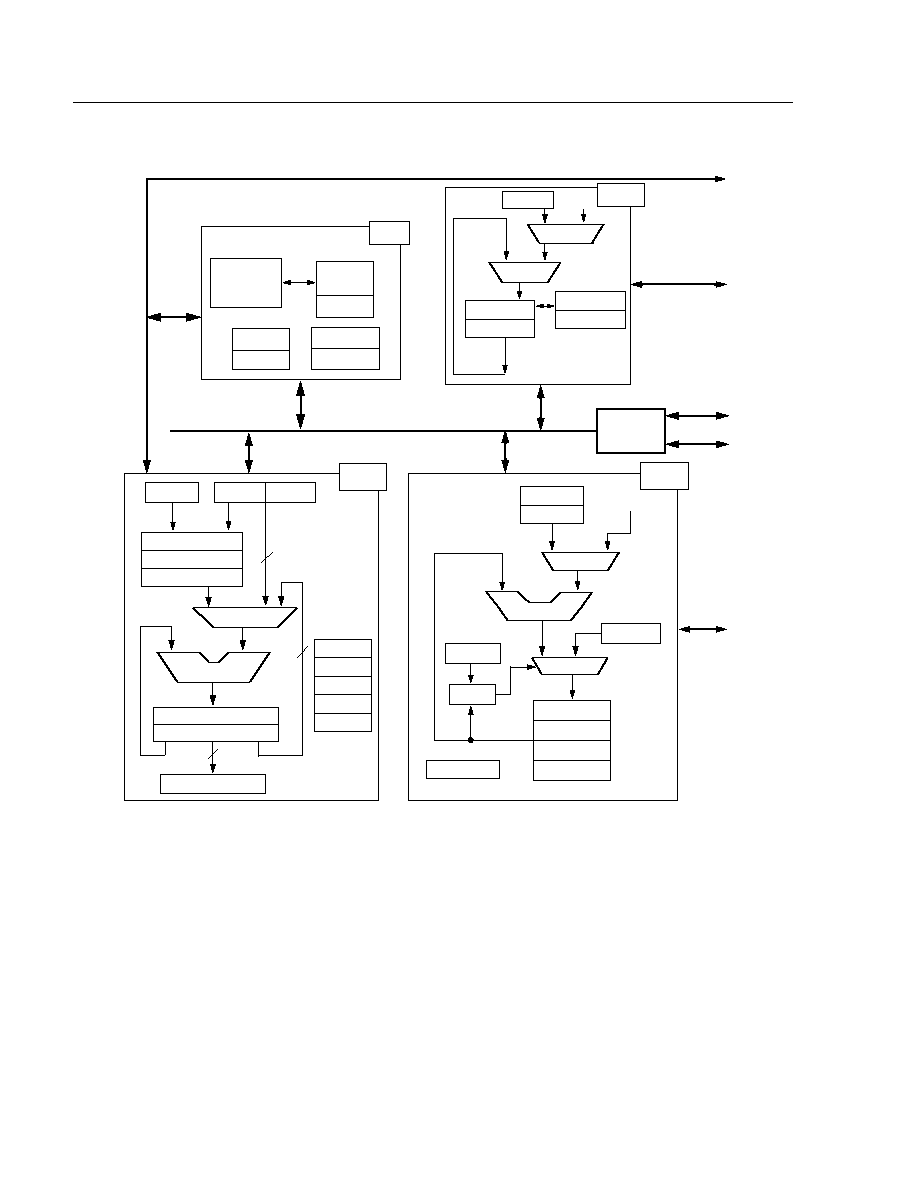
Preliminary Data Sheet
DSP1628 Digital Signal Processor
February 1997
14
Lucent Technologies Inc.
4 Hardware Architecture
(continued)
Figure 5. DSP1600 Core Block Diagram
psw (16)
auc (16)
CONTROL
CACHE
cloop (7)
inc (16)
ins (16)
alf (16)
mwait (16)
SYS
XDB
XAB
IDB
YAB
YDB
r0 (16)
r1 (16)
r2 (16)
r3 (16)
j (16)
k (16)
re (16)
YAAU
rb (16)
ADDER
MUX
CMP
ybase (16)
pc (16)
pt (16)
pi (16)
i (16)
ADDER
XAAU
EXTRACT/SAT
x (16)
yh (16)
yl (16)
16 x 16 MPY
p (32)
SHIFT (≠2, 0, 1, 2)
c0 (8)
c2 (8)
c1 (8)
16
ALU/SHIFT
a0 (36)
a1 (36)
36
32
MUX
DAU
MUX
≠1, 0, 1, 2
BRIDGE
MUX
1
pr (16)
5-1741 (F).b

Preliminary Data Sheet
February 1997
DSP1628 Digital Signal Processor
Lucent Technologies Inc.
15
4 Hardware Architecture
(continued)
* F3 ALU instructions with immediates require specifying the high half of the accumulators as a0h and a1h.
Table 3. DSP1600 Core Block Diagram Legend
Symbol
Name
16 x 16 MPY
16-bit x 16-bit Multiplier.
a0--a1
Accumulators 0 and 1 (16-bit halves specified as a0, a0l, a1, and a1l)*.
alf
AWAIT, LOWPR, Flags.
ALU/SHIFT
Arithmetic Logic Unit/Shifter.
auc
Arithmetic Unit Control.
c0--c2
Counters 0--2.
cloop
Cache Loop Count.
CMP
Comparator.
DAU
Digital Arithmetic Unit.
i
Increment Register for the X Address Space.
IDB
Internal Data Bus.
inc
Interrupt Control.
ins Interrupt
Status.
j
Increment Register for the Y Address Space.
k
Increment Register for the Y Address Space.
MUX
Multiplexer.
mwait
External Memory Wait-states Register.
p
Product Register (16-bit halves specified as p, pl).
PC
Program Counter.
pi
Program Interrupt Return Register.
pr
Program Return Register.
psw
Processor Status Word.
pt
X Address Space Pointer.
r0--r3
Y Address Space Pointers.
rb
Modulo Addressing Register (begin address).
re
Modulo Addressing Register (end address).
SYS
System Cache and Control Section.
x
Multiplier Input Register.
XAAU
X Space Address Arithmetic Unit.
XAB
X Space Address Bus.
XDB
X Space Data Bus.
YAAU
Y Space Address Arithmetic Unit.
YAB
Y Space Address Bus.
YDB
Y Space Data Bus.
ybase
Direct Addressing Base Register.
y
DAU Register (16-bit halves specified as y, yl).

Preliminary Data Sheet
DSP1628 Digital Signal Processor
February 1997
16
Lucent Technologies Inc.
4 Hardware Architecture
(continued)
Interruptibility
Vectored interrupts are serviced only after the execution
of an interruptible instruction. If more than one
vectored interrupt is asserted at the same time, the in-
terrupts are serviced sequentially according to their as-
signed priorities. See Table 4 for the priorities assigned
to the vectored interrupts. Interrupt service routines,
branch and conditional branch instructions, cache
loops, and instructions that only decrement one of the
RAM pointers, r0 to r3 (e.g., *r3
- -
), are not interrupt-
ible.
A trap is similar to an interrupt, but it gains control of the
processor by branching to the trap service routine even
when the current instruction is noninterruptible. It may
not be possible to return to normal instruction execution
from the trap service routine since the machine state
cannot always be saved. In particular, program execu-
tion cannot be continued from a trapped cache loop or
interrupt service routine. While in a trap service routine,
another trap is ignored.
When set to 1, the status bits in the ins register indicate
that an interrupt has occurred. The processor must
reach an interruptible state (completion of an interrupt-
ible instruction) before an enabled vectored interrupt will
be acted on. An interrupt will not be serviced if it is not
enabled. Polled interrupt service can be implemented
by disabling the interrupt in the inc register and then
polling the ins register for the expected event.
Vectored Interrupts
Tables 33 and 34 show the inc and ins registers. A logic
1 written to any bit of inc enables (or unmasks) the as-
sociated interrupt. If the bit is cleared to a logic 0, the in-
terrupt is masked. Note that neither the software
interrupt nor traps can be masked.
The occurrence of an interrupt that is not masked will
cause the program execution to transfer to the memory
location pointed to by that interrupt's vector address,
assuming no other interrupt is being serviced (see
Table 4, Interrupt Vector Table). The occurrence of an
interrupt that is masked causes no automatic processor
action, but will set the corresponding status bit in the ins
register. If a masked interrupt occurs, it is latched in the
ins register, but the interrupt is not taken. When un-
latched, this latched interrupt will initiate automatic pro-
cessor interrupt action. See the
DSP1611/17/18/27
Digital Signal Processor Information Manual for a more
detailed description of the interrupts.
Signaling Interrupt Service Status
Five pins of DSP1628 are devoted to signaling interrupt
service status. The IACK pin goes high while any inter-
rupt or user trap is being serviced, and goes low when
the ireturn instruction from the service routine is issued.
Four pins, VEC[3:0], carry a code indicating which of the
interrupts or trap is being serviced. Table 4 contains the
encodings used by each interrupt.
Traps due to HDS breakpoints have no effect on either
the IACK or VEC[3:0] pins. Instead, they show the inter-
rupt state or interrupt source of the DSP when the trap
occurred.
Clearing Interrupts
The PHIF interrupts (PIBF and POBE) are cleared by
reading or writing the parallel host interface data trans-
mit registers pdx0[in] and pdx0[out], respectively. The
SIO and SIO2 interrupts (IBF, IBF2, OBE, and OBE2)
are cleared one instruction cycle AFTER reading or writ-
ing the serial data registers, (sdx[in], sdx2[in], sdx[out],
or sdx2[out]). To account for this added latency, the
user must ensure that a single instruction (NOP or any
other valid DSP16XX instruction) follows the sdx regis-
ter read or write instruction prior to exiting an interrupt
service routine (via an ireturn or goto pi instruction) or
before checking the ins register for the SIO flag status.
Adding this instruction ensures that interrupts are not
reported incorrectly following an ireturn or that stale
flags are not read from the ins register.The JTAG inter-
rupt (JINT) is cleared by reading the jtag register.
Five of the vectored interrupts are cleared by writing to
the ins register. Writing a 1 to the INT0, INT1, EREADY,
EOVF, or TIME bits in the ins will cause the corre-
sponding interrupt status bit to be cleared to a logic 0.
The status bit for these vectored interrupts is also
cleared when the ireturn instruction is executed, leaving
set any other vectored interrupts that are pending.
Traps
The TRAP pin of the DSP1628 is a bidirectional signal.
At reset, it is configured as an input to the processor.
Asserting the TRAP pin will force a user trap. The trap
mechanism is used for two purposes. It can be used by
an application to rapidly gain control of the processor for
asynchronous time-critical event handling (typically for
catastrophic error recovery). It is also used by the HDS
for breakpointing and gaining control of the processor.
Separate vectors are provided for the user trap (0x46)
and the HDS trap (0x3). Traps are not maskable.

Preliminary Data Sheet
February 1997
DSP1628 Digital Signal Processor
Lucent Technologies Inc.
17
A trap has four cycles of latency. At most, two instruc-
tions will execute from the time the trap is received at
the pin to when it gains control. An instruction that is ex-
ecuting when a trap occurs is allowed to complete be-
fore the trap service routine is entered. (Note that the
instruction could be lengthened by wait-states.) During
normal program execution, the pi register contains ei-
ther the address of the next instruction (two-cycle in-
struction executing) or the address following the next
instruction (one-cycle instruction executing). In an inter-
rupt service routine, pi contains the interrupt return ad-
dress. When a trap occurs during an interrupt service
routine, the value of the pi register may be overwritten.
Specifically, it is not possible to return to an interrupt
service routine from a user trap (0x46) service routine.
Continuing program execution when a trap occurs dur-
ing a cache loop is also not possible.
The HDS trap causes circuitry to force the program
memory map to MAP1 (with on-chip ROM starting at ad-
dress 0x0) when the trap is taken. The previous memo-
ry map is restored when the trap service routine exits by
issuing an ireturn. The map is forced to MAP1 because
the HDS code, if present, resides in the on-chip ROM.
Using the Lucent Technologies development tools, the
TRAP pin may be configured to be an output, or an input
vectoring to address 0x3. In a multiprocessor environ-
ment, the TRAP pins of all the DSPs present can be tied
together. During HDS operations, one DSP is selected
by the host software to be the master. The master pro-
cessor's TRAP pin is configured to be an output.
The TRAP pins of the slave processors are configured
as inputs. When the master processor reaches a break-
point, the master's TRAP pin is asserted. The slave pro-
cessors will respond to their TRAP input by beginning to
execute the HDS code.
AWAIT Interrupt (Standby or Sleep Mode)
Setting the AWAIT bit (bit 15) of the alf register
(alf = 0x8000) causes the processor to go into a power-
saving standby or sleep mode. Only the minimum cir-
cuitry on the chip required to process an incoming inter-
rupt remains active. After the AWAIT bit is set, one
additional instruction will be executed before the stand-
by power-saving mode is entered. A PHIF or SIO word
transfer will complete if already in progress. The AWAIT
bit is reset when the first interrupt occurs. The chip then
wakes up and continues executing.
Two nop instructions should be programmed after the
AWAIT bit is set. The first nop (one cycle) will be exe-
cuted before sleeping; the second will be executed after
the interrupt signal awakens the DSP and before the in-
terrupt service routine is executed.
4 Hardware Architecture
(continued)
* Traps due to HDS breakpoints have no effect on VEC[3:0] pins.
Table 4. Interrupt Vector Table
Source
Vector
Priority
VEC[3:0]
Issued by
No Interrupt
--
--
0x0
--
Software Interrupt
0x2
1
0x1
icall
INT0
0x1
2
0x2
pin
JINT
0x42
3
0x8
jtag in
INT1
0x4
4
0x9
pin
TIME
0x10
7
0xc
timer
IBF2
0x14
8
0xd
SIO2 in
OBE2
0x18
9
0xe
SIO2 out
Reserved
0x1c
10
0x0
--
EREADY
0x20
11
0x1
ECCP ready
EOVF
0x24
12
0x2
ECCP overflow
IBF
0x2c
14
0x3
SIO in
OBE
0x30
15
0x4
SIO out
PIBF
0x34
16
0x5
PHIF in
POBE
0x38
17
0x6
PHIF out
TRAP from HDS
0x3
18
*
breakpoint, jtag, or pin
TRAP from User
0x46
19 = highest
0x7
pin

Preliminary Data Sheet
DSP1628 Digital Signal Processor
February 1997
18
Lucent Technologies Inc.
4 Hardware Architecture
(continued)
The AWAIT bit should be set from within the cache if the
code which is executing resides in external ROM where
more than one wait-state has been programmed. This
ensures that an interrupt will not disturb the device from
completely entering the sleep state.
For additional power savings, set ioc = 0x0180 and tim-
erc = 0x0040 in addition to setting alf = 0x8000. This
will hold the CKO pin low and shut down the timer and
prescaler (see Table 42 and Table 35).
For a description of the control mechanisms for putting
the DSP into low-power modes, see Section 4.13, Pow-
er Management.
4.4 Memory Maps and Wait-States
The DSP1600 core implements a modified Harvard ar-
chitecture that has separate on-chip 16-bit address and
data buses for the instruction/coefficient (X) and data
(Y) memory spaces. Table 5 shows the instruction/coef-
ficient memory space maps for both the DSP1628x16
and DSP1628x08.
The DSP1628 provides a multiplexed external bus
which accesses external RAM (ERAM) and ROM (ER-
OM). Programmable wait-states are provided for exter-
nal memory accesses. The instruction/coefficient
memory map is configurable to provide application flex-
ibility. Table 6 shows the data memory space, which
has one map.
Instruction/Coefficient Memory Map Selection
In determining which memory map to use, the proces-
sor evaluates the state of two parameters. The first is
the LOWPR bit (bit 14) of the alf register. The LOWPR
bit of the alf register is initialized to 0 automatically at re-
set. LOWPR controls the starting address in memory
assigned to 1K banks of dual-port RAM. If LOWPR is
low, internal dual-port RAM begins at address 0xC000.
If LOWPR is high, internal dual-port RAM begins at ad-
dress 0x0. LOWPR also moves IROM from 0x0 in
MAP1 to 0x4000 in MAP3, and EROM from 0x0 in
MAP2 to 0x4000 in MAP4.
The second parameter is the value at reset of the EXM
pin (pin 27 or pin 14, depending upon the package
type). EXM determines whether the internal 48 Kwords
ROM (IROM) will be addressable in the memory map.
The Lucent Technologies development system tools,
together with the on-chip HDS circuitry and the JTAG
port, can independently set the memory map. Specifi-
cally, during an HDS trap, the memory map is forced to
MAP1. The user's map selection is restored when the
trap service routine has completed execution.
MAP1
MAP1 has the IROM starting at 0x0 and 1 Kword banks
of DPRAM starting at 0xC000. MAP1 is used if
DSP1628 has EXM low at reset and the LOWPR pa-
rameter is programmed to zero. It is also used during an
HDS trap.
MAP2
MAP2 differs from MAP1 in that the lowest 48 Kwords
reference external ROM (EROM). MAP2 is used if EXM
is high at reset, the LOWPR parameter is programmed
to zero, and an HDS trap is not in progress.
MAP3
MAP3 has the 1 Kword banks of DPRAM starting at
address 0x0. In MAP3, the 48 Kwords of IROM start at
0x4000. MAP3 is used if EXM is low at reset, the
LOWPR bit is programmed to 1, and an HDS trap is not
in progress. Note that this map is not available if the
secure mask-programmable option has been ordered.
MAP4
MAP4 differs from MAP3 in that addresses above
0x4000 reference external ROM (EROM). This map is
used if the LOWPR bit is programmed to 1, an HDS trap
is not in progress, and, either EXM is high during reset,
or the secure mask-programmable option has been or-
dered.
Whenever the chip is reset using the RSTB pin, the de-
fault memory map will be MAP1 or MAP2, depending
upon the state of the EXM pin at reset. A reset through
the HDS will not reinitialize the alf register, so the previ-
ous memory map is retained.
Boot from External ROM
After RSTB goes from low to high, the DSP1628 comes
out of reset and fetches an instruction from address
zero of the instruction/coefficient space. The physical
location of address zero is determined by the memory
map in effect. If EXM is high at the rising edge of RSTB,
MAP2 is selected. MAP2 has EROM at location zero;
thus, program execution begins from external memory.
If EXM is high and INT1 is low when RSTB rises, the
mwait register defaults to 15 wait-states for all external
memory segments. If INT1 is high, the mwait register
defaults to 0 wait-states.
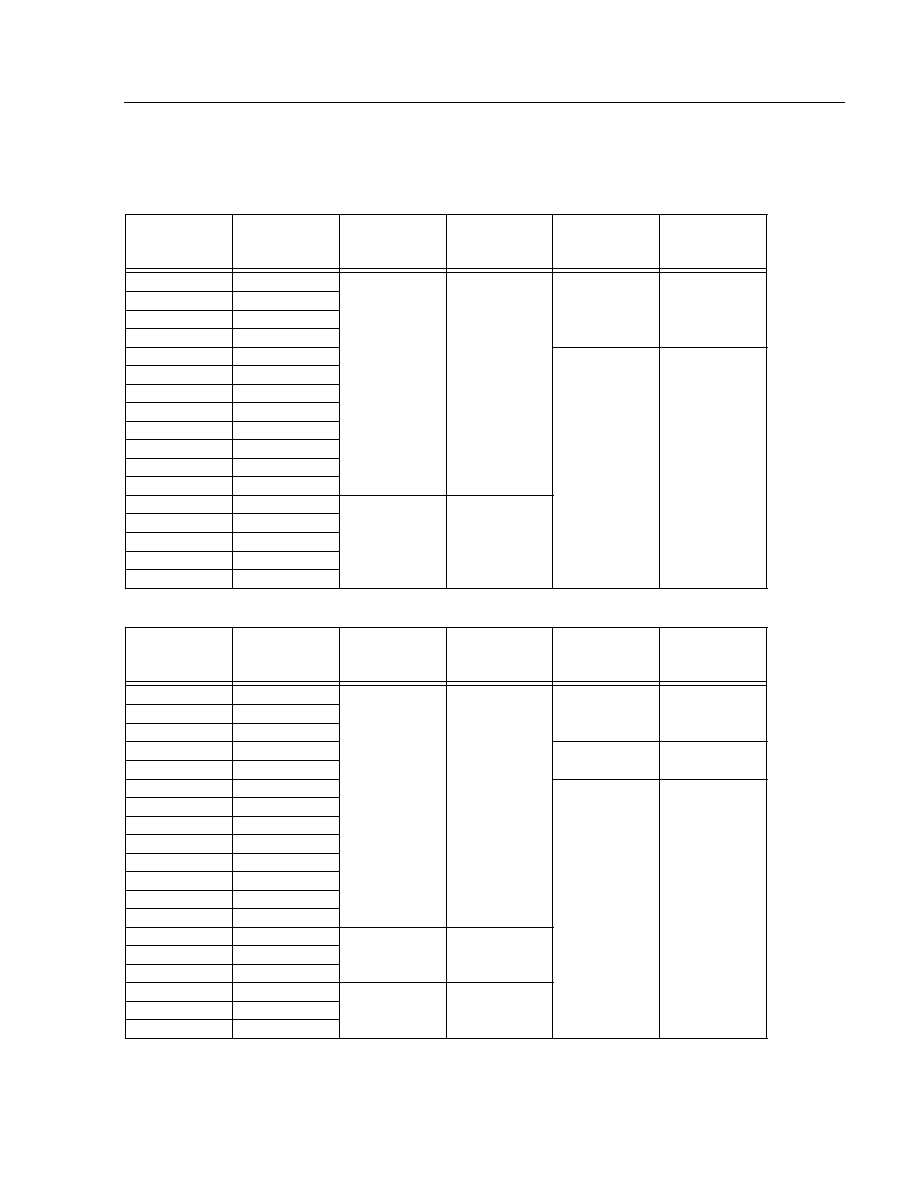
Preliminary Data Sheet
February 1997
DSP1628 Digital Signal Processor
Lucent Technologies Inc.
19
4 Hardware Architecture
(continued)
Table 5. Instruction/Coefficient Memory Maps
* MAP1 is set automatically during an HDS trap. The user-selected map is restored at the end of the HDS trap service routine.
LOWPR is an alf register bit. The Lucent Technologies development system tools can independently set the memory map.
MAP3 is not available if the secure mask-programmable option is selected.
DSP1628x16
X Address
AB[0:15]
MAP 1*
EXM = 0
LOWPR = 0
MAP 2
EXM = 1
LOWPR = 0
MAP 3
EXM = 0
LOWPR = 1
MAP 4
EXM = 1
LOWPR = 1
0
0x0000
IROM
(48K)
EROM
(48K)
DPRAM
(16K)
DPRAM
(16K)
4K
0x1000
8K
0x2000
12K
0x3000
16K
0x4000
IROM
(48K)
EROM
(48K)
20K
0x5000
24K
0x6000
28K
0x7000
32K
0x8000
36K
0x9000
40K
0xA000
44K
0xB000
48K
0xC000
DPRAM
(16K)
DPRAM
(16K)
52K
0xD000
54K
0xD800
56K
0xE000
60K--64K
0xFFFF
DSP1628x08
X Address
AB[0:15]
MAP 1*
EXM = 0
LOWPR = 0
MAP 2
EXM = 1
LOWPR = 0
MAP 3
EXM = 0
LOWPR = 1
MAP 4
EXM = 1
LOWPR = 1
0
0x0000
IROM
(48K)
EROM
(48K)
DPRAM
(8K)
DPRAM
(8K)
4K
0x1000
6K
0x1800
8K
0x2000
Reserved
(8K)
Reserved
(8K)
12K
0x3000
16K
0x4000
IROM
(48K)
EROM
(48K)
20K
0x5000
24K
0x6000
28K
0x7000
32K
0x8000
36K
0x9000
40K
0xA000
44K
0xB000
48K
0xC000
DPRAM
(8K)
DPRAM
(8K)
52K
0xD000
54K
0xD800
56K
0xE000
Reserved
(8K)
Reserved
(8K)
58K
0xE800
60K--64K
0xFFFF

Preliminary Data Sheet
DSP1628 Digital Signal Processor
February 1997
20
Lucent Technologies Inc.
4 Hardware Architecture
(continued)
Table 6. Data Memory Maps
On the data memory side (see Table ), the 1K banks of
dual-port RAM are located starting at address 0. Ad-
dresses from 0x4000 to 0x40FF reference a 256-word
memory-mapped I/O segment (IO). Addresses from
0x4100 to 0x7FFF reference the low external data RAM
segment (ERAMLO). Addresses above 0x8000 refer-
ence high external data RAM (ERAMHI).
Wait-States
The number of wait-states (from 0 to 15) used when ac-
cessing each of the four external memory segments
(ERAMLO, IO, ERAMHI, and EROM) is programmable
in the mwait register (see Table 40). When the program
references memory in one of the four external seg-
ments, the internal multiplexer is automatically switched
to the appropriate set of internal buses, and the associ-
ated external enable of ERAMLO, IO, ERAMHI, or
EROM is issued. The external memory cycle is auto-
matically stretched by the number of wait-states config-
ured in the appropriate field of the mwait register.
1628x16 Data Memory Map (Not to Scale)
Decimal
Address
Address in
r0, r1, r2, r3
Segment
0
0x0000
DPRAM[1:16]
16K
0x4000
IO
16,640
0x4100
ERAMLO
32K
0x8000
ERAMHI
64K ≠ 1
0xFFFF
1628x08 Data Memory Map (Not to Scale)
Decimal
Address
Address in
r0, r1, r2, r3
Segment
0
0x0000
DPRAM[1:8]
8K
0x2000
Reserved
16K
0x4000
IO
16,640
0x4100
ERAMLO
32K
0x8000
ERAMHI
64K ≠ 1
0xFFFF

Preliminary Data Sheet
February 1997
DSP1628 Digital Signal Processor
Lucent Technologies Inc.
21
4 Hardware Architecture
(continued)
4.5 External Memory Interface (EMI)
The external memory interface supports read/write op-
erations from instruction/coefficient memory, data
memory, and memory-mapped I/O devices. The
DSP1628 provides a 16-bit external address bus,
AB[15:0], and a 16-bit external data bus, DB[15:0].
These buses are multiplexed between the internal bus-
es for the instruction/coefficient memory and the data
memory. Four external memory segment enables,
ERAMLO, IO, ERAMHI, and EROM, select the external
memory segment to be addressed.
If a data memory location with an address between
0x4100 and 0x7FFF is addressed, ERAMLO is asserted
low.
If one of the 256 external data memory locations, with
an address greater than or equal to 0x4000, and less
than or equal to 0x40FF, is addressed, IO is asserted
low. IO is intended for memory-mapped I/O.
If a data memory location with an address greater than
or equal to 0x8000 is addressed, ERAMHI is asserted
low. When the external instruction/coefficient memory is
addressed, EROM is asserted low.
The flexibility provided by the programmable options of
the external memory interface (see Table 40, mwait
Register and Table 42, ioc Register) allows the
DSP1628 to interface gluelessly with a variety of com-
mercial memory chips.
Each of the four external memory segments, ERAMLO,
IO, ERAMHI, and EROM, has a number of wait-states
that is programmable (from 0 to 15) by writing to the
mwait register. When the program references memory
in one of the four external segments, the internal multi-
plexer is automatically switched to the appropriate set of
internal buses, and the associated external enable of
ERAMLO, IO, ERAMHI, or EROM is issued. The exter-
nal memory cycle is automatically stretched by the num-
ber of wait-states in the appropriate field of the mwait
register.
When writing to external memory, the RWN pin goes
low for the external cycle. The external data bus,
DB[15:0], is driven by the DSP1628 starting halfway
through the cycle. The data driven on the external data
bus is automatically held after the cycle for one addi-
tional clock period unless an external read cycle imme-
diately follows.
The DSP1628 has one external address bus and one
external data bus for both memory spaces. Since some
instructions provide the capability of simultaneous ac-
cess to both X space and Y space, some provision must
be made to avoid collisions for external accesses. The
DSP1628 has a sequencer that does the external X ac-
cess first, and then the external Y access, transparently
to the programmer. Wait-states are maintained as pro-
grammed in the mwait register. For example, let two in-
structions be executed: the first reads a coefficient from
EROM and writes data to ERAM; the second reads a
coefficient from EROM and reads data from ERAM. The
sequencer carries out the following steps at the external
memory interface: read EROM, write ERAM, read ER-
OM, and read ERAM. Each step is done in sequential
one-instruction cycle steps, assuming zero wait-states
are programmed. Note that the number of instruction
cycles taken by the two instructions is four. Also, in this
case, the write hold time is zero.
The DSP1628 allows writing into external instruction/
coefficient memory. By setting bit 11, WEROM, of the
ioc register (see Table 42), writing to (or reading from)
data memory or memory-mapped I/O asserts the
EROM strobe instead of ERAMLO, IO, or ERAMHI.
Therefore, with WEROM set, EROM appears in both Y
space (replacing ERAM) and X space, in its normal po-
sition.
Bit 14 of the ioc register (see Table 42), EXTROM, may
be used with WEROM to download to a full 64K of ex-
ternal memory. When WEROM and EXTROM are both
asserted, address bit 15 (AB15) is held low, aliasing the
upper 32K of external memory into the lower 32K.
When an access to internal memory is made, the
AB[15:0] bus holds the last valid external memory ad-
dress. Asserting the RSTB pin low 3-states the AB[15:0]
bus. After reset, the AB[15:0] value is undefined.
The leading edge of the memory segment enables can
be delayed by approximately one-half a CKO period by
programming the ioc register (see Table 42). This is
used to avoid a situation in which two devices drive the
data bus simultaneously.
Bits 7, 8, and 13 of the ioc register select the mode of
operation for the CKO pin (see Table 42). Available op-
tions are a free-running unstretched clock, a wait-stated
sequenced clock (runs through two complete cycles
during a sequenced external memory access), and a
wait-stated clock based on the internal instruction cycle.
These clocks drop to the low-speed internal ring oscilla-
tor when SLOWCKI is enabled (see 4.13, Power Man-
agement). The high-to-low transitions of the wait-stated
clock are synchronized to the high-to-low transition of
the free-running clock. Also, the CKO pin provides ei-
ther a continuously high level, a continuously low level,
or changes at the rate of the internal processor clock.
This last option, only available with the small-signal in-
put clock options, enables the DSP1628 CKI input buff-
er to deliver a full-rate clock to other devices while the
DSP1628 itself is in one of the low-power modes.

Preliminary Data Sheet
DSP1628 Digital Signal Processor
February 1997
22
Lucent Technologies Inc.
4 Hardware Architecture
(continued)
4.6 Bit Manipulation Unit (BMU)
The BMU interfaces directly to the main accumulators in
the DAU providing the following features:
s
Barrel shifting--logical and arithmetic, left and right
shift
s
Normalization and extraction of exponent
s
Bit-field extraction and insertion
These features increase the efficiency of the DSP in ap-
plications such as control or data encoding and decod-
ing. For example, data packing and unpacking, in which
short data words are packed into one 16-bit word for
more efficient memory storage, is very easy.
In addition, the BMU provides two auxiliary accumula-
tors, aa0 and aa1. In one instruction cycle, 36-bit data
can be shuffled, or swapped, between one of the main
accumulators and one of the alternate accumulators.
The ar<0--3> registers are 16-bit registers that control
the operations of the BMU. They store a value that de-
termines the amount of shift or the width and offset
fields for bit extraction or insertion. Certain operations in
the BMU set flags in the DAU psw register and the alf
register (see Table 30, Processor Status Word (psw)
Register, and Table 39, alf Register). The ar<0--3>
registers can also be used as general-purpose regis-
ters.
The BMU instructions are detailed in Section 5.1. For a
thorough description of the BMU, see the
DSP1611/17/
18/27 Digital Signal Processor Information Manual.
4.7 Serial I/O Units (SIOs)
The serial I/O ports on the DSP1628 device provide a
serial interface to many codecs and signal processors
with little, if any, external hardware required. Each high-
speed, double-buffered port (sdx and sdx2) supports
back-to-back transmissions of data. SIO and SIO2 are
identical. The output buffer empty (OBE and OBE2) and
input buffer full (IBF and IBF2) flags facilitate the read-
ing and/or writing of each serial I/O port by program-
or interrupt-driven I/O. There are four selectable active
clock speeds.
A bit-reversal mode provides compatibility with either
the most significant bit (MSB) first or least significant bit
(LSB) first serial I/O formats (see Table 26, Serial I/O
Control Registers (sioc and sioc2)). A multiprocessor
I/O configuration is supported. This feature allows up to
eight DSP161X devices to be connected together on an
SIO port without requiring external glue logic.
The serial data may be internally looped back by setting
the SIO loopback control bit, SIOLBC, of the ioc regis-
ter. SIOLBC affects both the SIO and SIO2. The data
output signals are wrapped around internally from the
output to the input (DO1 to DI1 and DO2 to DI2). To ex-
ercise loopback, the SIO clocks (ICK1, ICK2, OCK1,
and OCK2) should either all be in the active mode,
16-bit condition, or each pair should be driven from one
external source in passive mode. Similarly, pins ILD1
(ILD2) and OLD1 (OLD2) must both be in active mode
or tied together and driven from one external frame
clock in passive mode. During loopback, DO1, DO2,
DI1, DI2, ICK1, ICK2, OCK1, OCK2, ILD1, ILD2, OLD1,
OLD2, SADD1, SADD2, SYNC1, SYNC2, DOEN1, and
DOEN2 are 3-stated.
Setting DODLY = 1 (sioc and sioc2) delays DO by one
phase of OCK so that DO changes on the falling edge
of OCK instead of the rising edge (DODLY = 0). This re-
duces the time available for DO to drive DI and to be val-
id for the rising edge of ICK, but increases the hold time
on DO by half a cycle on OCK.
Programmable Modes
Programmable modes of operation for the SIO and
SIO2 are controlled by the serial I/O control registers
(sioc and sioc2). These registers, shown in Table 26,
are used to set the ports into various configurations.
Both input and output operations can be independently
configured as either active or passive. When active, the
DSP1628 generates load and clock signals. When pas-
sive, load and clock signal pins are inputs.
Since input and output can be independently config-
ured, each SIO has four different modes of operation.
Each of the sioc registers is also used to select the fre-
quency of active clocks for that SIO. Finally, these reg-
isters are used to configure the serial I/O data formats.
The data can be 8 or 16 bits long, and can also be input/
output MSB first or LSB first. Input and output data for-
mats can be independently configured.
Multiprocessor Mode
The multiprocessor mode allows up to eight devices
that support multiprocessor mode (codecs or DSP16XX
devices) to be connected together to provide data trans-
mission among any of the multiprocessor devices in the
system. Either of the DSP1628's SIO ports (SIO or
SIO2) may be independently used for the multiproces-
sor mode. The multiprocessor interface is a four-wire in-
terface, consisting of a data channel, an address/
protocol channel, a transmit/receive clock, and a sync
signal (see Figure 6). The DI1 and DO1 pins of all the
DSPs are connected to transmit and receive the data
channel. The SADD1 pins of all the DSPs are connect-
ed to transmit and receive the address/protocol chan-
nel. ICK1 and OCK1 should be tied together and driven
from one source. The SYNC1 pins of all the DSPs are
connected.
In the configuration shown in Figure 6, the master DSP
(DSP0) generates active SYNC1 and OCK1 signals
while the slave DSPs use the SYNC1 and OCK1 signals
in passive mode to synchronize operations. In addition,
all DSPs must have their ILD1 and OLD1 signals in ac-
tive mode.

Preliminary Data Sheet
February 1997
DSP1628 Digital Signal Processor
Lucent Technologies Inc.
23
4 Hardware Architecture
(continued)
While ILD1 and OLD1 are not required externally for
multiprocessor operation, they are used internally in the
DSP's SIO. Setting the LD field of the master's sioc reg-
ister to a logic level 1 will ensure that the active genera-
tion of SYNC1, ILD1, and OLD1 is derived from OCK1
(see Table 26). With this configuration, all DSPs should
use ICK1 (tied to OCK1) in passive mode to avoid con-
flicts on the clock (CK) line (see the
DSP1611/17/18/27
Digital Signal Processor Information Manual for more
information).
Four registers (per SIO) configure the multiprocessor
mode: the time-division multiplexed slot register (tdms
or tdms2), the serial receive and transmit address reg-
ister (srta or srta2), the serial data transmit register
(sdx or sdx2), and the multiprocessor serial address/
protocol register (saddx or saddx2).
Multiprocessor mode requires no external logic and
uses a TDM interface with eight 16-bit time slots per
frame. The transmission in any time slot consists of
16 bits of serial data in the data channel and 16 bits of
address and protocol information in the address/proto-
col channel. The address information consists of the
transmit address field of the srta register of the trans-
mitting device. The address information is transmitted
concurrently with the transmission of the first 8 bits of
data. The protocol information consists of the transmit
protocol field written to the saddx register and is trans-
mitted concurrently with the last 8 bits of data (see
Table 29, Multiprocessor Protocol Register). Data is re-
ceived or recognized by other DSP(s) whose receive
address matches the address in the address/protocol
channel. Each SIO port has a user-programmable re-
ceive address and transmit address associated with it.
The transmit and receive addresses are programmed in
the srta register.
In multiprocessor mode, each device can send data in
a unique time slot designated by the tdms register
transmit slot field (bits 7--0). The tdms register has a
fully decoded transmit slot field in order to allow one
DSP1628 device to transmit in more than one time slot.
This procedure is useful for multiprocessor systems
with less than eight DSP1628 devices when a higher
bandwidth is necessary between certain devices in that
system. The DSP operating during time slot 0 also
drives SYNC1.
In order to prevent multiple bus drivers, only one DSP
can be programmed to transmit in a particular time slot.
In addition, it is important to note that the address/pro-
tocol channel is 3-stated in any time slot that is not being
driven.
Therefore, to prevent spurious inputs, the address/pro-
tocol channel should be pulled up to V
DD
with a 5 k
re-
sistor, or it should be guaranteed that the bus is driven
in every time slot. (If the SYNC1 signal is externally gen-
erated, then this pull-up is required for correct initializa-
tion.)
Each SIO also has a fully decoded transmitting address
specified by the srta register transmit address field (bits
7--0). This is used to transmit information regarding the
destination(s) of the data. The fully decoded receive ad-
dress specified by the srta register receive address field
(bits 15--8) determines which data will be received. The
SIO protocol channel data is controlled via the saddx
register. When the saddx register is written, the lower 8
bits contain the 8-bit protocol field. On a read, the high-
order 8 bits read from saddx are the most recently re-
ceived protocol field sent from the transmitting DSP's
saddx output register. The low-order 8 bits are read as
0s.
An example use of the protocol channel is to use the top
3 bits of the saddx value as an encoded source address
for the DSPs on the multiprocessor bus. This leaves the
remaining 5 bits available to convey additional control
information, such as whether the associated field is an
opcode or data, or whether it is the last word in a trans-
fer, etc. These bits can also be used to transfer parity in-
formation about the data. Alternatively, the entire field
can be used for data transmission, boosting the band-
width of the port by 50%.
Using SIO2
The SIO2 functions the same as the SIO. Please refer
to Pin Multiplexing in Section 4.1 for a description of pin
multiplexing of BIO, PHIF, VEC[3:0], and SIO2.

Preliminary Data Sheet
DSP1628 Digital Signal Processor
February 1997
24
Lucent Technologies Inc.
4 Hardware Architecture
(continued)
Figure 6. Multiprocessor Communication and Connections
DSP 0
DO
ICK
SADD
SYNC
DSP 1
DSP 7
DATA CHANNEL
CLOCK
ADDRESS/PROTOCOL CHANNEL
SYNC SIGNAL
DI
OCK
DO
ICK
SADD
SYNC
DI
OCK
DO
ICK
SADD
SYNC
DI
OCK
5 k
V
DD
5-4181 (F).a
4.8 Parallel Host Interface (PHIF)
The DSP1628 has an 8-bit parallel host interface for
rapid transfer of data with external devices. This parallel
port is passive (data strobes provided by an external
device) and supports either
Motorola or Intel micro-
controller protocols. The PHIF also provides for 8-bit or
16-bit data transfers. As a flexible host interface, it re-
quires little or no glue logic to interface to other devices
(e.g., microcontrollers, microprocessors, or another
DSP).
The data path of the PHIF consists of a 16-bit input buff-
er, pdx0(in), and a 16-bit output buffer, pdx0(out). Two
output pins, parallel input buffer full (PIBF) and parallel
output buffer empty (POBE), indicate the state of the
buffers. In addition, there are two registers used to con-
trol and monitor the PHIF's operation: the parallel host
interface control register (phifc, see Table 32), and the
PHIF status register (PSTAT, see Table 8). The PSTAT
register, which reflects the state of the PIBF and POBE
flags, can only be read by an external device when the
PSTAT input pin is asserted. The phifc register defines
the programmable options for this port.
The function of the pins, PIDS and PODS, is program-
mable to support both the
Intel and Motorola protocols.
The pin, PCSN, is an input that, when low, enables
PIDS and PODS (or PRWN and PDS, depending on the
protocol used). While PCSN is high, the DSP1628 ig-
nores any activity on PIDS and/or PODS. If a DSP1628
is intended to be continuously accessed through the
PHIF port, PCSN should be grounded. If PCSN is low
and their respective bits in the inc register are set, the
assertion of PIDS and PODS by an external device
causes the DSP1628 device to recognize an interrupt.
Programmability
The parallel host interface can be programmed for 8-bit
or 16-bit data transfers using bit 0, PMODE, of the phifc
register. Setting PMODE selects 16-bit transfer mode.
An input pin controlled by the host, PBSEL, determines
an access of either the high or low bytes. The assertion
level of the PBSEL input pin is configurable in software
using bit 3 of the phifc register, PBSELF. Table 7 sum-
marizes the port's functionality as controlled by the
PSTAT and PBSEL pins and the PBSELF and PMODE
fields.
For 16-bit transfers, if PBSELF is zero, the PIBF and
POBE flags are set after the high byte is transferred. If
PBSELF is one, the flags are set after the low byte is
transferred. In 8-bit mode, only the low byte is access-
ed, and every completion of an input or output access
sets PIBF or POBE.
Bit 1 of the phifc register, PSTROBE, configures the
port to operate either with an
Intel protocol where only
the chip select (PCSN) and either of the data strobes
(PIDS or PODS) are needed to make an access, or with
a
Motorola protocol where the chip select (PCSN), a
data strobe (PDS), and a read/write strobe (PRWN) are
needed. PIDS and PODS are negative assertion data
strobes while the assertion level of PDS is programma-
ble through bit 2, PSTRB, of the phifc register.

Preliminary Data Sheet
February 1997
DSP1628 Digital Signal Processor
Lucent Technologies Inc.
25
4 Hardware Architecture
(continued)
Finally, the assertion level of the output pins, PIBF and POBE, is controlled through bit 4, PFLAG. When PFLAG is
set low, PIBF and POBE output pins have positive assertion levels. By setting bit 5, PFLAGSEL, the logical OR of
PIBF and POBE flags (positive assertion) is seen at the output pin PIBF. By setting bit 7 in phifc, PSOBEF, the
polarity of the POBE flag in the status register, PSTAT, can be changed. PSOBEF has no effect on the POBE pin.
Pin Multiplexing
Please refer to Pin Multiplexing in Section 4.1 for a description of BIO, PHIF, VEC[3:0], and SIO2 pins.
Table 7. PHIF Function (8-bit and 16-bit Modes)
PMODE Field
PSTAT Pin
PBSEL Pin
PBSELF Field = 0
PBSELF Field = 1
0 (8-bit)
0
0
pdx0 low byte
reserved
0
0
1
reserved
pdx0 low byte
0
1
0
PSTAT
reserved
0
1
1
reserved
PSTAT
1 (16-bit)
0
0
pdx0 low byte
pdx0 high byte
1
0
1
pdx0 high byte
pdx0 low byte
1
1
0
PSTAT
reserved
1
1
1
reserved
PSTAT
Table 8. pstat Register as Seen on PB[7:0]
Bit
7
6
5
4
3
2
1
0
Field
RESERVED
PIBF
POBE
4.9 Bit Input/Output Unit (BIO)
The BIO controls the directions of eight bidirectional
control I/O pins, IOBIT[7:0]. If a pin is configured as an
output, it can be individually set, cleared, or toggled. If a
pin is configured as an input, it can be read and/or test-
ed.
The lower half of the sbit register (see Table 37) con-
tains current values (VALUE[7:0]) of the eight bidirec-
tional pins IOBIT[7:0]. The upper half of the sbit register
(DIREC[7:0]) controls the direction of each of the pins.
A logic 1 configures the corresponding pin as an output;
a logic 0 configures it as an input. The upper half of the
sbit register is cleared upon reset.
The cbit register (see Table 38) contains two 8-bit
fields, MODE/MASK[7:0] and DATA/PAT[7:0]. The val-
ues of DATA/PAT[7:0] are cleared upon reset. The
meaning of a bit in either field depends on whether it has
been configured as an input or an output in sbit. If a pin
has been configured to be an output, the meanings are
MODE and DATA. For an input, the meanings are
MASK and PAT(tern). Table 9 shows the functionality of
the MODE/MASK and DATA/PAT bits based on the di-
rection selected for the associated IOBIT pin.
Those bits that have been configured as inputs can be
individually tested for 1 or 0. For those inputs that are
being tested, there are four flags produced: allt (all true),
allf (all false), somet (some true), and somef (some
false). These flags can be used for conditional branch or
special instructions. The state of these flags can be
saved and restored by reading and writing bits 0 to 3 of
the alf register (see Table 39).
* 0
n
7.
If a BIO pin is switched from being configured as an out-
put to being configured as an input and then back to be-
ing configured as an output, the pin retains the previous
output value.
Pin Multiplexing
Please refer to Pin Multiplexing in Section 4.1 for a
description of BIO, PHIF, VEC[3:0], and SIO2 pins.
Table 9. BIO Operations
DIREC[n]*
MODE/
MASK[n]
DATA/
PAT[n]
Action
1 (Output)
0
0
Clear
1 (Output)
0
1
Set
1 (Output)
1
0
No Change
1 (Output)
1
1
Toggle
0 (Input)
0
0
No Test
0 (Input)
0
1
No Test
0 (Input)
1
0
Test for Zero
0 (Input)
1
1
Test for One

Preliminary Data Sheet
DSP1628 Digital Signal Processor
February 1997
26
Lucent Technologies Inc.
4 Hardware Architecture
(continued)
4.10 Timer
The interrupt timer is composed of the timerc (control)
register, the timer0 register, the prescaler, and the
counter itself. The timer control register (see Table 35,
timerc Register) sets up the operational state of the tim-
er and prescaler. The timer0 register is used to hold the
counter reload value (or period register) and to set the
initial value of the counter. The prescaler slows the
clock to the timer by a number of binary divisors to allow
for a wide range of interrupt delay periods.
The counter is a 16-bit down counter that can be loaded
with an arbitrary number from software. It counts down
to 0 at the clock rate provided by the prescaler. Upon
reaching 0 count, a vectored interrupt to program ad-
dress 0x08 is issued to the DSP1628, providing the in-
terrupt is enabled (bit 8 of inc and ins registers). The
counter will then either wait in an inactive state for an-
other command from software, or will automatically re-
peat the last interrupting period, depending upon the
state of the RELOAD bit in the timerc register.
When RELOAD is 0, the counter counts down from its
initial value to 0, interrupts the DSP1628, and then
stops, remaining inactive until another value is written to
the timer0 register. Writing to the timer0 register caus-
es both the counter and the period register to be written
with the specified 16-bit number. When RELOAD is 1,
the counter counts down from its initial value to 0, inter-
rupts the DSP1628, automatically reloads the specified
initial value from the period register into the counter,
and repeats indefinitely. This provides for either a single
timed interrupt event or a regular interrupt clock of arbi-
trary period.
The timer can be stopped and started by software, and
can be reloaded with a new period at any time. Its count
value, at the time of the read, can also be read by soft-
ware. Due to pipeline stages, stopping and starting the
timer may result in one inaccurate count or prescaled
period. When the DSP1628 is reset, the bottom 6 bits of
the timerc register and the timer0 register and counter
are initialized to 0. This sets the prescaler to CKO/2
*
,
turns off the reload feature, disables timer counting, and
initializes the timer to its inactive state. The act of reset-
ting the chip does not cause a timer interrupt. Note that
the period register is not initialized on reset.
The T0EN bit of the timerc register enables the clock to
the timer. When T0EN is a 1, the timer counts down to-
wards 0. When T0EN is a 0, the timer holds its current
count.
The PRESCALE field of the timerc register selects one
of 16 possible clock rates for the timer input clock (see
Table 35, timerc Register).
Setting the DISABLE bit of the timerc register to a logic
* Frequency of CKO/2 is equivalent to either CKI/2 for the PLL by-
passed or related to CKI by the PLL multiplying factors. See
Section 4.13, Clock Synthesis.
1 shuts down the timer and the prescaler for power sav-
ings. Setting the TIMERDIS, bit 4, in the powerc regis-
ter has the same effect of shutting down the timer. The
DISABLE bit and the TIMERDIS bit are cleared by writ-
ing a 0 to their respective registers to restore the normal
operating mode.
4.11 Error Correction Coprocessor
The error correction coprocessor (ECCP) performs full
Viterbi decoding with single instructions for a wide
range of maximum likelihood sequence estimation
(MLSE) equalization and convolutional decoding. The
ECCP operates in parallel with the DSP core, increas-
ing the throughput rate, and single-instruction Viterbi
decoding provides significant code compression re-
quired for a single DSP solution for modern digital cellu-
lar applications.
System Description
The ECCP is a loosely coupled, programmable, internal
coprocessor that operates in parallel with the DSP1600
core. A complete Viterbi decoding for MLSE equaliza-
tion or convolutional decoding is performed with a single
DSP instruction.
The core communicates with the ECCP module via
three interface registers. An address register, ear, is
used to indirectly access the ECCP internal memory-
mapped registers. A data register, edr, works in concert
with the address register to indirectly read from or write
to an ECCP internal memory-mapped register ad-
dressed by the contents of the address register. After
each edr access, the contents of the address register is
postincremented by one. Upon writing an ECCP op
code to instruction register, eir, either MLSE equaliza-
tion, convolutional decoding, a simple traceback opera-
tion, or ECCP reset is invoked.
The mode of operation of the ECCP is set up by writing
appropriate fields of a memory-mapped control register.
In MLSE equalization, the control register may be con-
figured for 2-tap to 6-tap equalization. In convolutional
decoding, the control register may be configured for
constraint lengths 2 through 7 and code rates 1/1
through 1/6. One of two variants of the soft-decoded
output may be programmed, or a hard-decoded output
may be chosen.
Usually, convolutional decoding is performed after
MLSE equalization. For receiver configuration with
MLSE equalization followed by convolutional decoding,
a Manhattan branch metric computation for convolu-
tional decoding may be selected by setting a branch
metric select bit in the control register.
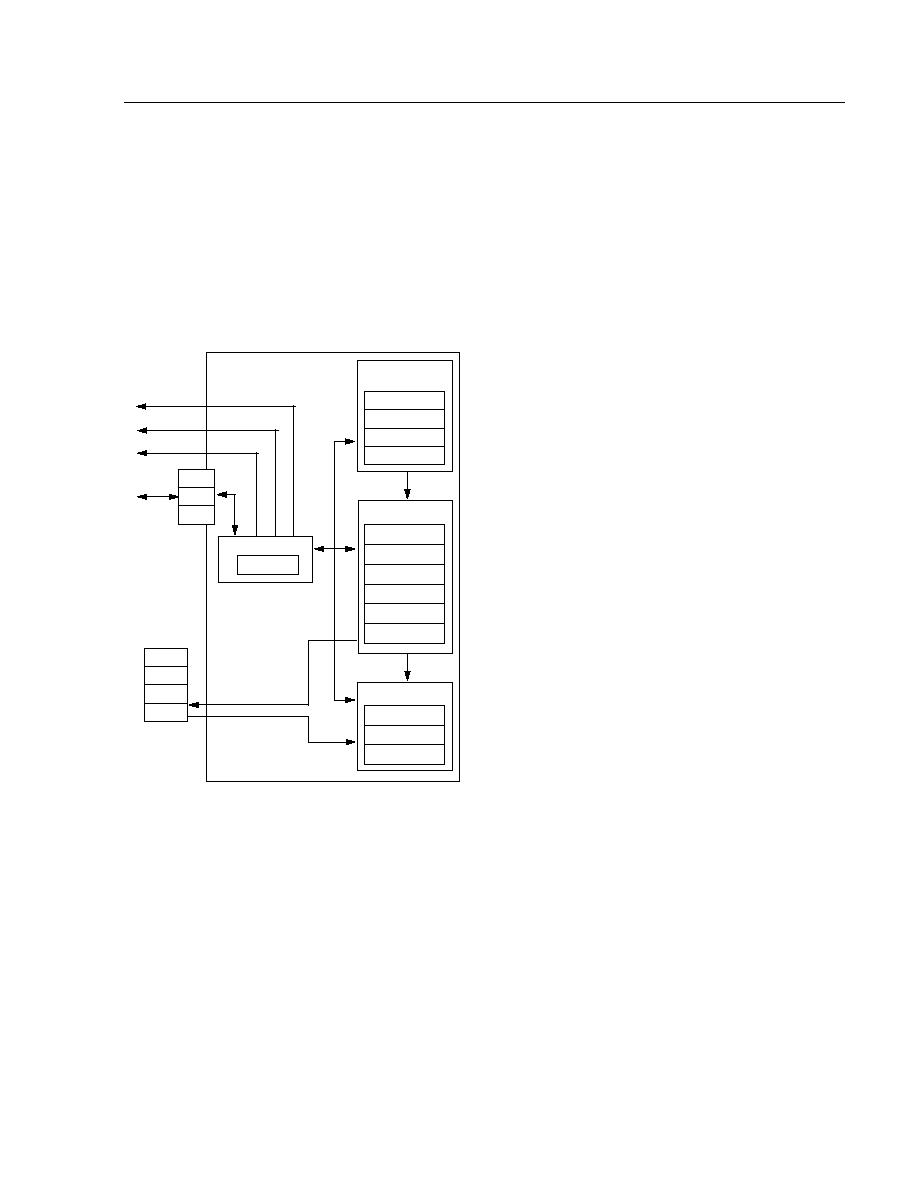
Preliminary Data Sheet
February 1997
DSP1628 Digital Signal Processor
Lucent Technologies Inc.
27
4 Hardware Architecture
(continued)
In wideband low data rate applications, additive white
Gaussian noise (AWGN) is the principle channel impair-
ment, and Euclidean branch metric computation for
convolutional decoding is selected by resetting the
branch metric select bit to zero.
A traceback-length register is provided for programming
the traceback decode length.
A block diagram of the coprocessor and its interface to
the DSP1600 core is shown in the following figure:
Figure 7. Error Correction Coprocessor Block
Diagram/Programming Model
The ECCP internal registers are accessed indirectly
through the address and data registers, ear and edr.
The control register, ECON, and the traceback length
register, TBLR, are used to program the operating
mode of the ECCP. The symbol registers (S0H0--
S5H5, ZIG10, ZQG32), the generating polynomial reg-
isters (ZIG10, ZQG32, G54), and the channel impulse
registers (S0H0--S5H5) are used as input to the ECCP
for MLSE or convolutional decoding. Following a Viterbi
decoding operation, the decoded symbol is read out of
the decoded symbol register, DSR. All internal states of
these memory-mapped registers are accessible and
controllable by the DSP program. During periods of si-
multaneous DSP-ECCP activity, however, ECCP inter-
nal edr registers as well as the shared bank of RAM,
RAM4, are not accessible to the user's DSP code.
Branch Metric Unit: The branch metric unit of the
ECCP performs full-precision real and complex arith-
metic for computing 16-bit incremental branch metrics
required for MLSE equalization and convolutional de-
coding.
MLSE Branch Metric Unit: To generate the estimated
received complex signal at instance n, E(n, k) = EI(n, k)
+ j EQ(n, k), at the receiver, all possible states, k = 0 to
2C ≠ 1 ≠ 1, taking part in the Viterbi state transition are
convolved with the estimated channel impulse re-
sponse, H(n) = [h(n), h(n ≠ 1), h(n ≠ 2), . . . , h(n ≠ C +
1)] T, where the constraint length C = {2 to 6}. Each in-
phase and quadrature-phase part of the channel tap,
h(n) = hI(n) + j hQ(n), is quantized to an 8-bit 2's com-
plement number.
The channel estimates are normalized prior to loading
into the ECCP such that the worst-case summation of
the hI(n) or hQ(n) are confined within a 10-bit 2's com-
plement number. The in-phase and quadrature-phase
parts of the received complex signal Z(n) = ZI(n) + j
ZQ(n) are also confined within a10-bit 2's complement
number. The Euclidean branch metric associated with
each of the 2C state transitions is calculated as:
BM(n, k) = XI(n, k)2 + XQ(n, k)2
where
XI(n, k) = abs{ZI(n) ≠ EI(n, k)}
and
XQ(n, k) = abs{ZQ(n) ≠ EQ(n, k)}
The absolute values of the difference signal are saturat-
ed at level 0xFF. The sixteen most significant bits of this
17-bit incremental branch metric are retained for the
add-compare-select operation of the Viterbi algorithm.
The in-phase and quadrature-phase parts of the re-
ceived complex signal are stored in ZIG10 and ZQG32
registers, respectively. The complex estimated channel
taps H5 through H0 are stored in S5H5 through S0H0
registers, such that the in-phase part of the channel oc-
cupies the upper byte and the quadrature-phase part of
the channel occupies the lower byte.
Convolutional Branch Metric Unit: Two types of distance
computation are implemented for convolutional decod-
ing. Convolutional decoding over a Gaussian channel is
supported with Euclidean distance measure for rate 1/1
and 1/2 convolutional encoding. Convolutional decod-
ing preceded by the MLSE equalization or other linear/
nonlinear equalization is supported with Manhattan dis-
tance measure for rate 1/1 through 1/6 convolutional
encoding.
EOVF
BRANCH METRIC
UNIT
SiHi, i = 0, . . . ,5
ZIG10
ZQG32
G54
UPDATE UNIT
NS[63:0]
PS[63:0]
SYC
MDX
MACH
MACL
TRACEBACK UNIT
ear
edr
eir
RAM4
TBLR
DSR
TBSR
EREADY
EBUSY
IDB
ECCP
CONTROL UNIT
ECON
5-4500 (F)

Preliminary Data Sheet
DSP1628 Digital Signal Processor
February 1997
28
Lucent Technologies Inc.
4 Hardware Architecture
(continued)
Generating polynomials, G(0), . . . , G(5), up to six-delays corresponding to a constraint length of seven, may take
part in computing the estimated received signals, E(0, k), . . . , E(5, k), within the ECCP associated with all possible
state transitions, k = 0, 1, 2C ≠ 1.
Six 8-bit soft symbols, S(0), . . . , S(5), are loaded into the ECCP. The incremental branch metrics associated with
all 2C state transitions are calculated as indicated in Table 10:
The received 8-bit signals S(5) through S(0) are stored in the S5H5 through S0H0 registers. The generating poly-
nomials G(1) and G(0) are stored in the upper and lower bytes of the ZIG10 register, respectively. The generating
polynomials G(3) and G(2) are stored in the upper and lower bytes of the ZQG32 register, respectively. The gener-
ating polynomials G(5) and G(4) are stored in the upper and lower bytes of the G54 register, respectively.
Update Unit: The add-compare-select operation of the Viterbi algorithm is performed in this unit. At every time in-
stant, there are 2C state transitions of which 2C ≠ 1 state transitions survive. The update unit selects and updates
2C ≠ 1 surviving sequences in the traceback RAM that consists of the 4th bank of the internal RAM, RAM4. The
accumulated cost of the path p at the Jth instant, ACC(J, p), is the sum of the incremental branch metrics belonging
to the path p up to the time instant J:
ACC(J, p) =
BM(j, p), j = 1, . . . , J
The update unit computes and stores full precision 24-bit resolution path metrics of the bit sequence. To assist the
detection of a near overflow in the accumulated path cost, an internal vectored interrupt, EOVF, is provided.
Traceback Unit: The traceback unit selects a path with the smallest path metric among 2C ≠ 1 survivor paths at
every instant. The last signal of the path corresponding to the maximum likelihood sequence is delivered to the
decoder output. The depth of this last signal is programmable at the symbol rate. The traceback decoding starts
from the minimum cost index associated with the state with the minimum cost, min {Acc(j, p1), . . . , Acc(j, p2C ≠ 1)}.
If the end state is known, the traceback decoding may be forced in the direction of the right path by writing the de-
sired end state into the minimum cost index register, MIDX.
Interrupts and Flags: The ECCP interrupts the DSP1600 core when the ECCP has completed an instruction,
EREADY, or when an overflow in the accumulated cost is imminent, EOVF. Also, an EBUSY flag is provided to the
core to indicate when the ECCP is in operation.
Traceback RAM: The fourth 1 Kword bank of dual-port RAM is shared between the DSP1600 core and the ECCP.
RAM4, located in the Y memory space in the address range 0x0C00 to 0x0FFF, is used by the ECCP for storing
traceback information. When the ECCP is active, i.e., the EBUSY flag is asserted, the DSP core cannot access this
traceback RAM.
Table 10. Incremental Branch Metrics
Distance Measure
Code Rate
16-bit Incremental Branch Metric
Euclidean
1/1
(S(0) ≠ E(0))
2
Euclidean
1/2
[
(S(i) ≠ E(i))
2
] >> 1, i = 0, 1
Manhattan
1/1
[S(i) ≠ E(i)] << 8, i = 0
Manhattan
1/2
[(S(i) ≠ E(i))] << 7, i = 0, 1
Manhattan
1/3 or 1/4
[(S(i) ≠ E(i))] << 6, i = 0, 1, 2, or 3
Manhattan
1/5 or 1/6
[(S(i) ≠ E(i))] << 5, i = 0, 1, . . . , 4 or 5
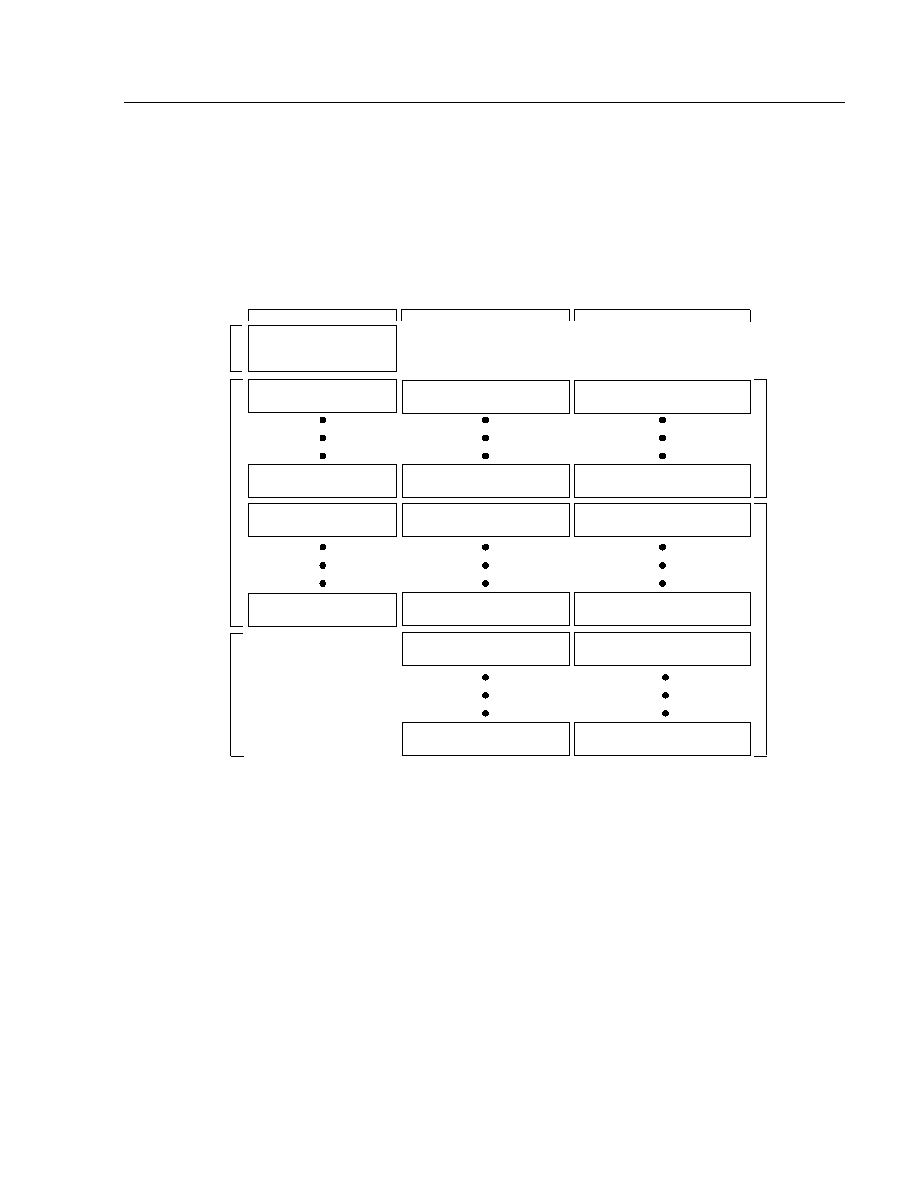
Preliminary Data Sheet
February 1997
DSP1628 Digital Signal Processor
Lucent Technologies Inc.
29
4 Hardware Architecture
(continued)
DSP Decoding Operation Sequence
The DSP operation sequence for invoking the ECCP for an MLSE equalization or convolutional decoding operation
is explained with the operation flow diagram in Figure 7.
Figure 8. DSP Core Operation Sequence
EBUSY = FALSE
ECCP OFF
(LOAD ECCP)
EBUSY = TRUE
ECCP ON
(EXEC ECCP)
EBUSY = FALSE
ECCP OFF
(UNLOAD ECCP)
PROGRAM ECCP
{ECON = VALUE, TBLR = TL
H, G = CHANNEL, GEN. POLY.}
LOAD SYMBOL 1
INTO ZI:ZQ/S[5:0]
LOAD SYMBOL TL
INTO ZI:ZQ/S[5:0]
LOAD SYMBOL TL + 1
INTO ZI:ZQ/S[5:0]
LOAD SYMBOL N
INTO ZI:ZQ/S[5:0]
UPDATE MLSE/CONV INSTR 1
UPDATE MLSE/CONV INSTR TL
UPDATE MLSE/CONV INSTR TL + 1
UPDATE MLSE/CONV INSTR N
TRACEBACK INSTR 1
TRACEBACK INSTR TL
INVALID DECODED SYMBOL 1
INVALID DECODED SYMBOL TL
VALID DECODED SYMBOL 1
VALID DECODED SYMBOL N + TL
VALID DECODED SYMBOL N + TL + 1
VALID DECODED SYMBOL N
PROGRAM
ECCP
LOAD N SET
OF RECEIVED
SYMBOLS
AND
EXECUTE N
UPDATE
INSTRUCTIONS
EXECUTE
TL TRACEBACK
INSTRUCTIONS
DISCARD TL
INVALID
DECODED
SYMBOLS
ACCEPT N
VALID
DECODED
SYMBOLS
5-4501(F).a
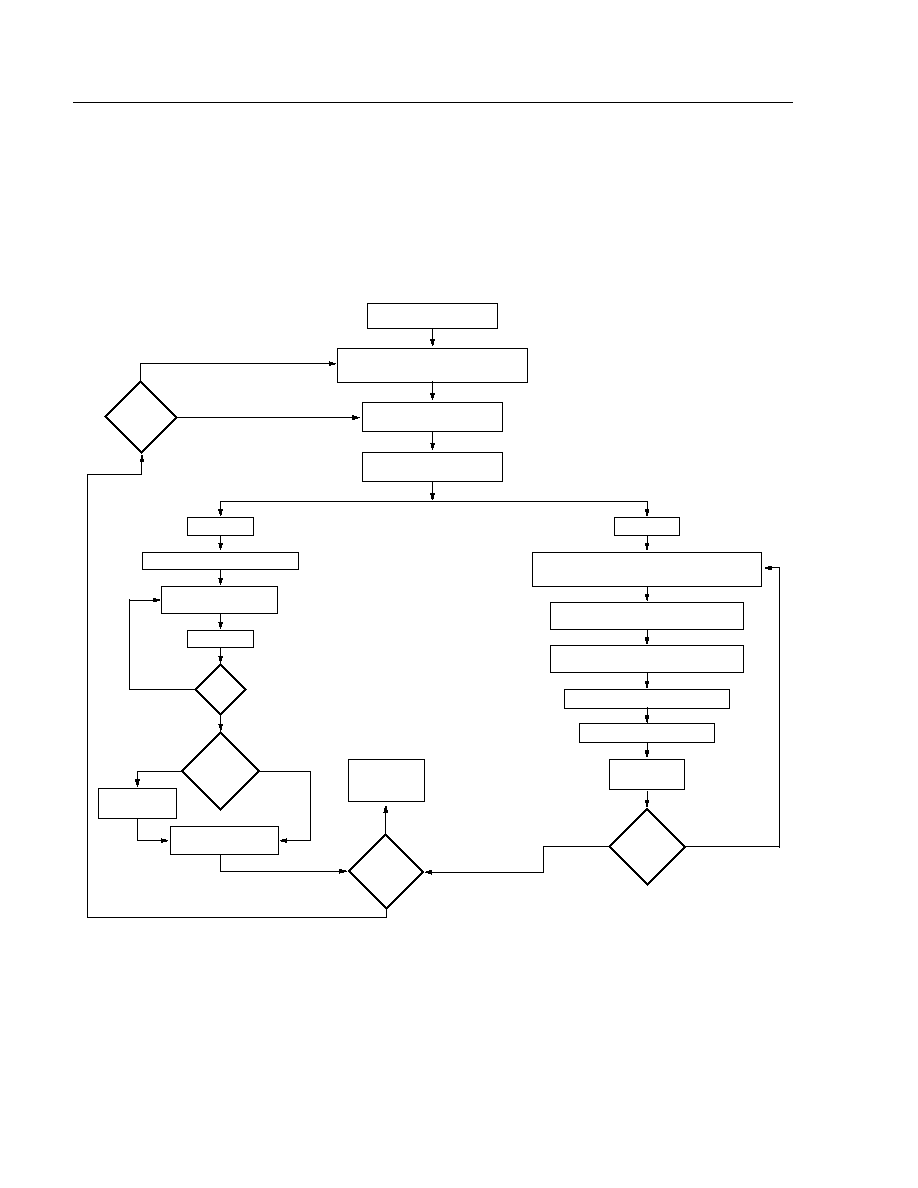
Preliminary Data Sheet
DSP1628 Digital Signal Processor
February 1997
30
Lucent Technologies Inc.
4 Hardware Architecture
(continued)
Operation of the ECCP
To operate the ECCP, the user first programs its mode of operation by setting the control register, ECON, the tra-
ceback length register, TBLR, and appropriately initializing the present state accumulated costs. The complete Vit-
erbi decoding operation is achieved by recursively loading the received symbols into the ECCP, executing the ECCP
with an UpdateMLSE, an UpdateConv, or a TraceBack instruction, and unloading the decoded symbol from the
ECCP. The operation of the ECCP is captured in the signal flow diagram in Figure 8.
Figure 9. ECCP Operation Sequence
DSP PROGRAMS ECCP
DSP LOADS CHANNEL/GENERATING
POLYNOMIALS INTO THE ECCP
DSP LOADS RECEIVED
SYMBOLS INTO THE ECCP
DSP EXECUTES
UPDATE INSTRUCTION
NEW
ADAPTED
CHANNEL
TL = TBLR
FETCH MINIMUM COST INDEX
CALCULATE
REVERSED PATH
TL = TL ≠ 1
IS
TL = 0?
IS
TRACEBACK
INSTR.
?
?
DECREMENT
TBLR BY ONE
OUTPUT
DECODED SYMBOL
VITERBI
DECODING
COMPLETE
ALL
SYMBOLS
DECODED
?
NO
YES
YES
NO
NO
NO
YES
SET K = 0
CALCULATE BRANCH METRIC
CALCULATE ACCUMULATED COST
FOR STATE TRANSITIONS TO K
FOR BOTH STATE TRANSITIONS TO K
SELECT MINIMUM ACCUMULATED
COST AS SURVIVOR PATH
UPDATE MINIMUM COST INDEX
STORE SURVIVOR PATH
INCREMENT
K BY ONE
IS
K < 2
(C ≠ 1)
≠ 1
?
YES
NO
YES
5-4502(F)

Preliminary Data Sheet
February 1997
DSP1628 Digital Signal Processor
Lucent Technologies Inc.
31
4 Hardware Architecture
(continued)
Software Architecture
The ECCP registers are grouped into two categories:
the R-field registers and the internal memory-mapped
registers.
R-Field Registers: Three registers (ear, edr, and eir)
are defined in the core instruction set as programmable
registers for executing the ECCP and establishing the
data interface between the ECCP and the core. Re-
served bits are always zero when read and should be
written with zeros to make the program compatible with
future chip revisions.
Address Register (ear): The address register holds
the address of the ECCP internal memory-mapped reg-
isters. Each time the core accesses an internal ECCP
register through edr, the content of the address register
is postincremented by one. During a DSP compound
addressing instruction, the same edr register is access-
ed for both the read and the write operation.
Data Register (edr): The contents of the ECCP internal
memory-mapped registers are indirectly accessed by
the DSP through this register. A write to the data regis-
ter is directed to the ECCP internal register addressed
by the contents of the address register. A read from the
data register fetches the contents of the ECCP internal
register addressed by the address register. Every ac-
cess to the edr autoincrements the address register,
ear.
Instruction Register (eir): Four instructions are de-
fined for the ECCP operation. These instructions will be
executed upon writing appropriate values in the eir reg-
ister. Table 11 indicates the instruction encoding and
their mnemonics.
The UpdateMLSE instruction and the UpdateConv in-
struction each perform an appropriate branch metric
calculation, a complete Viterbi add-compare-select op-
eration, and a concurrent traceback decoding opera-
tion. The TraceBack instruction performs the traceback
decoding alone.
The ResetECCP instruction performs a proper reset op-
eration to initialize various registers as described in Ta-
ble 12.
During periods of ECCP activity, write operations to the
eir and edr registers as well as the read operation of the
edr register by the DSP code will be blocked. The
ECCP address register, ear, however, can be read or
written during ECCP operation to set up the ECCP ad-
dress for the next edr access after the completion of the
ECCP instruction. Note that the eir register can be read
during ECCP activity.
Table 11. ECCP Instruction Encoding
eir Value in hex
Instruction
0000
UpdateMLSE
0001
UpdateConv
0002
TraceBack
0003
Reserved
0004
ResetECCP
0005--FFFF
Reserved
Table 12. Reset State of ECCP Registers
Register
Reset State
eir
0x4
--
0xf (on pin reset)
ear
0x0
SYC
0x0
ECON
0x0
MIDX
0x0
MACH
0xff
MACL
0xffff

Preliminary Data Sheet
DSP1628 Digital Signal Processor
February 1997
32
Lucent Technologies Inc.
4 Hardware Architecture
(continued)
ECCP Internal Memory-Mapped Registers: Internal memory-mapped registers are defined in the ECCP address space
for control and status purposes and to hold data. A summary of the contents of these registers is given in Table 13.
Table 13. Memory-Mapped Registers
Address
Register
Register Bit Field
0x0000--0x007F
Next State Register
NS[0:63]--24-bit words split across two ad-
dress locations
Bit 31:16 is addressed by even address.
Bit 31:24 zero.
Bit 23:16 most significant byte of path cost.
0x0080--0x01FF
Reserved
Bit 15: 0 is addressed by odd address.
Bit 15:0 lower 2 bytes of path cost.
0x0200--0x027F
Present State Register
PS[0:63]--24-bit words split across two ad-
dress locations
Bit 31:16 is addressed by even address.
Bit 31:24 zero.
Bit 23:16 most significant byte of path cost.
0x0280--0x03FF
Reserved
Bit 15:0 is addressed by odd address.
Bit 15:0 lower 2 bytes of path cost.
0x400
Current Symbol Pointer
SYC
Bit 5:0 is used.
Bit 15:6 reserved.
0x401
Control Register
ECON
Bit 0 is soft decision select.
Bit 1 is Manhattan/Euclidean branch metric select.
Bit 2 is soft/hard decision select.
Bit 3 is reserved.
Bit 7:4 is reserved.
Bit 10:8 is code rate select.
Bit 11 is reserved.
Bit 14:12 is constraint length select.
Bit 15 is reserved.
0x402
Traceback Length Register
TBLR
Bit 5:0 is used.
Bit 15:6 is reserved.
0x403
Received Symbol/Channel Tap Register
S5H5
Convolutional decoding case:
Bit 7:0 is reserved.
Bit 15:8 is S5.
MLSE equalization case:
Bit 7:0 is HQ5.
Bit 15:8 is HI5.
0x404
Received Symbol/Channel Tap Register
S4H4
Convolutional decoding case:
Bit 7:0 is reserved.
Bit 15:8 is S4.
MLSE equalization case:
Bit 7:0 is HQ4.
Bit 15:8 is HI4.
0x405
Received Symbol/Channel Tap Register
S3H3
Convolutional decoding case:
Bit 7:0 is reserved.
Bit 15:8 is S3.
MLSE equalization case:
Bit 7:0 is HQ3.
Bit 15:8 is HI3.
0x406
Received Symbol/Channel Tap Register
S2H2
Convolutional decoding case:
Bit 7:0 is reserved.
Bit 15:8 is S2.
MLSE equalization case:
Bit 7:0 is HQ2.
Bit 15:8 is HI2.

Preliminary Data Sheet
February 1997
DSP1628 Digital Signal Processor
Lucent Technologies Inc.
33
4 Hardware Architecture
(continued)
Table 13. Memory-Mapped Registers (continued)
Address
Register
Register Bit Field
0x407
Received Symbol/Channel Tap Register
S1H1
Convolutional decoding case:
Bit 7:0 is reserved.
Bit 15:8 is S1.
MLSE equalization case:
Bit 7:0 is HQ1.
Bit 15:8 is HI1.
0x408
Received Symbol/Channel Tap Register
S0H0
Convolutional decoding case:
Bit 7:0 is reserved.
Bit 15:8 is S0.
MLSE equalization case:
Bit 7:0 is HQ0.
Bit 15:8 is HI0.
0x409
Decoded Symbol Register
DSR
Bit 7:0 is zero.
Bit 15:8 is decoded symbol.
0x40a
Received Real Signal/Generating Polynomial
ZIG10
Convolutional case:
Bit 7:0 is G0.
Bit 15:8 is G1.
MLSE case:
Bit 9:0 is in-phase part of received signal.
Bit 15:10 is reserved.
0x40b
Received Imaginary Signal/Generating Polynomial
ZQG32
Convolutional case:
Bit 7:0 is G2.
Bit 15:8 is G3.
MLSE case:
Bit 9:0 is quadrature-phase part of received signal.
Bit 15:10 is reserved.
0x40c
Generating Polynomial
G54
Convolutional case:
Bit 7:0 is G4.
Bit 15:8 is G5.
MLSE case:
Bit 15:0 is reserved.
0x40d
Minimum Cost Index Register
MIDX
Bit 7:0 is used.
Bit 15:8 is reserved.
0x40e--f
Minimum Accumulated Cost Register
MACH
MACL
0x040E
Bit 15:8 is zero.
Bit 7:0 is upper byte of the minimum accumulated cost 0x040F.
Bit 15:0 is the lower 2 bytes of the minimum accumulated cost.
0x410
Traceback Shift Register
TBSR
Traceback shift register (TBSR)
Bit 7:0 TBSR.
Bit 15:8 is reserved.
0x411--0x7FF
Reserved Registers
Reserved.
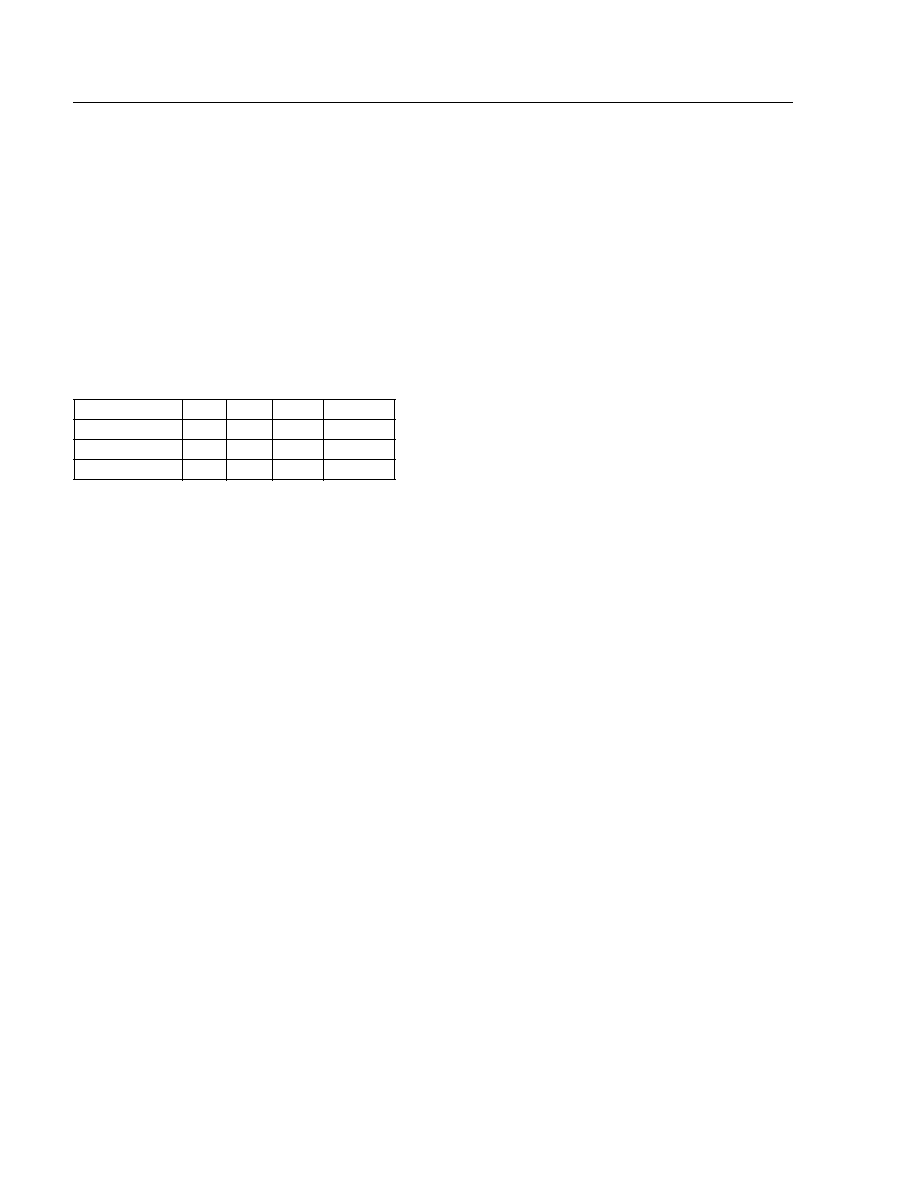
Preliminary Data Sheet
DSP1628 Digital Signal Processor
February 1997
34
Lucent Technologies Inc.
4 Hardware Architecture
(continued)
4.12 JTAG Test Port
The DSP1628 uses a JTAG/
IEEE 1149.1 standard five-
wire test port (TDI, TDO, TCK, TMS, TRST) for self-test
and hardware emulation. An instruction register, a
boundary-scan register, a bypass register, and a device
identification register have been implemented. The de-
vice identification register coding for the DSP1628 is
shown in Table 41. The instruction register (IR) is 4 bits
long. The instruction for accessing the device ID is 0xE
(1110). The behavior of the instruction register is sum-
marized in Table 14. Cell 0 is the LSB (closest to TDO).
The first line shows the cells in the IR that capture from
a parallel input in the capture-IR controller state. The
second line shows the cells that always load a logic 1 in
the capture-IR controller state. The third line shows the
cells that always load a logic 0 in the capture-IR control-
ler state. Cell 3 (MSB of IR) is tied to status signal PINT,
and cell 2 is tied to status signal JINT. The state of these
signals can therefore be captured during capture-IR and
shifted out during SHIFT-IR controller states.
Boundary-Scan Register
All of the chip's inputs and outputs are incorporated in a
JTAG scan path shown in Table 15. The types of
boundary-scan cells are as follows:
s
I = input cell
s
O = 3-state output cell
s
B = bidirectional (I/O) cell
s
OE = 3-state control cell
s
DC = bidirectional control cell
Table 14. JTAG Instruction Register
IR Cell #:
3
2
1
0
parallel input?
Y
Y
N
N
always logic 1?
N
N
N
Y
always logic 0?
N
N
Y
N

Preliminary Data Sheet
February 1997
DSP1628 Digital Signal Processor
Lucent Technologies Inc.
35
4 Hardware Architecture
(continued)
Table 15. JTAG Boundary-Scan Register
* Please refer to Pin Multiplexing in Section 4.1 for a description of pin multiplexing of BIO, PHIF, VEC[3:0], and SIO2.
Note that shifting a zero into this cell in the mode to scan a zero into the chip will disable the processor clocks just as the STOP pin will.
When the JTAG SAMPLE instruction is used, this cell will have a logic one regardless of the state of the pin.
Note: The direction of shifting is from TDI to cell 104 to cell 103 . . . to cell 0 of TDO.
Cell
Type
Signal Name/Function
Cell
Type
Signal Name/Function
0
OE
Controls cells 1, 27--31
69
B
OCK2/PCSN*
1
O
CKO
70
DC
Controls cell 71
2
I
RSTB
71
B
DO2/PSTAT*
3
DC
Controls cell 4
72
DC
Controls cell 73
4
B
TRAP 73
B
SYNC2/PBSEL*
5
I
STOP
74
DC
Controls cell 75
6
O
IACK 75
B
ILD2/PIDS*
7
I
INT0
76
DC
Controls cell 77
8
OE
Controls cells 6, 10--25, 49, 50, 78, 79
77
B
OLD2/PODS*
9
I
INT1
78
O
IBF2/PIBF*
10--25
O
AB[0:15]
79
O
OBE2/POBE*
26
I
EXM
80
DC
Controls cell 81
27
O
RWN 81
B
ICK2/PB0*
28--31
O
EROM, ERAMLO, ERAMHI, IO
82
DC
Controls cell 83
32--36
B
DB[0:4] 83
B
DI2/PB1*
37
DC
Controls cells 32--36, 38--48
84
DC
Controls cell 85
38--48
B
DB[5:15] 85
B
DOEN2/PB2*
49
O
OBE1
86
DC
Controls cell 87
50
O
IBF1 87
B
SADD2/PB3*
51
I
DI1
88
DC
Controls cell 89
52
DC
Controls cell 53
89
B
IOBIT0/PB4*
53
B
ILD1
90
DC
Controls cell 91
54
DC
Controls cell 55
91
B
IOBIT1/PB5*
55
B
ICK1
92
DC
Controls cell 93
56
DC
Controls cell 57
93
B
IOBIT2/PB6*
57
B
OCK1
94
DC
Controls cell 95
58
DC
Controls cell 59
95
B
IOBIT3/PB7*
59
B
OLD1
96
DC
Controls cell 97
60
OE
Controls cell 61
97
B
VEC3/IOBIT4*
61
O
DO1
98
DC
Controls cell 99
62
DC
Controls cell 63
99
B
VEC2/IOBIT5*
63
B
SYNC1
100
DC
Controls cell 101
64
DC
Controls cell 65
101
B
VEC1/IOBIT6*
65
B
SADD1
102
DC
Controls cell 103
66
DC
Controls cell 67
103
B
VEC0/IOBIT7*
67
B
DOEN1 104
I
CKI
68
DC
Controls cell 69
--
--
--
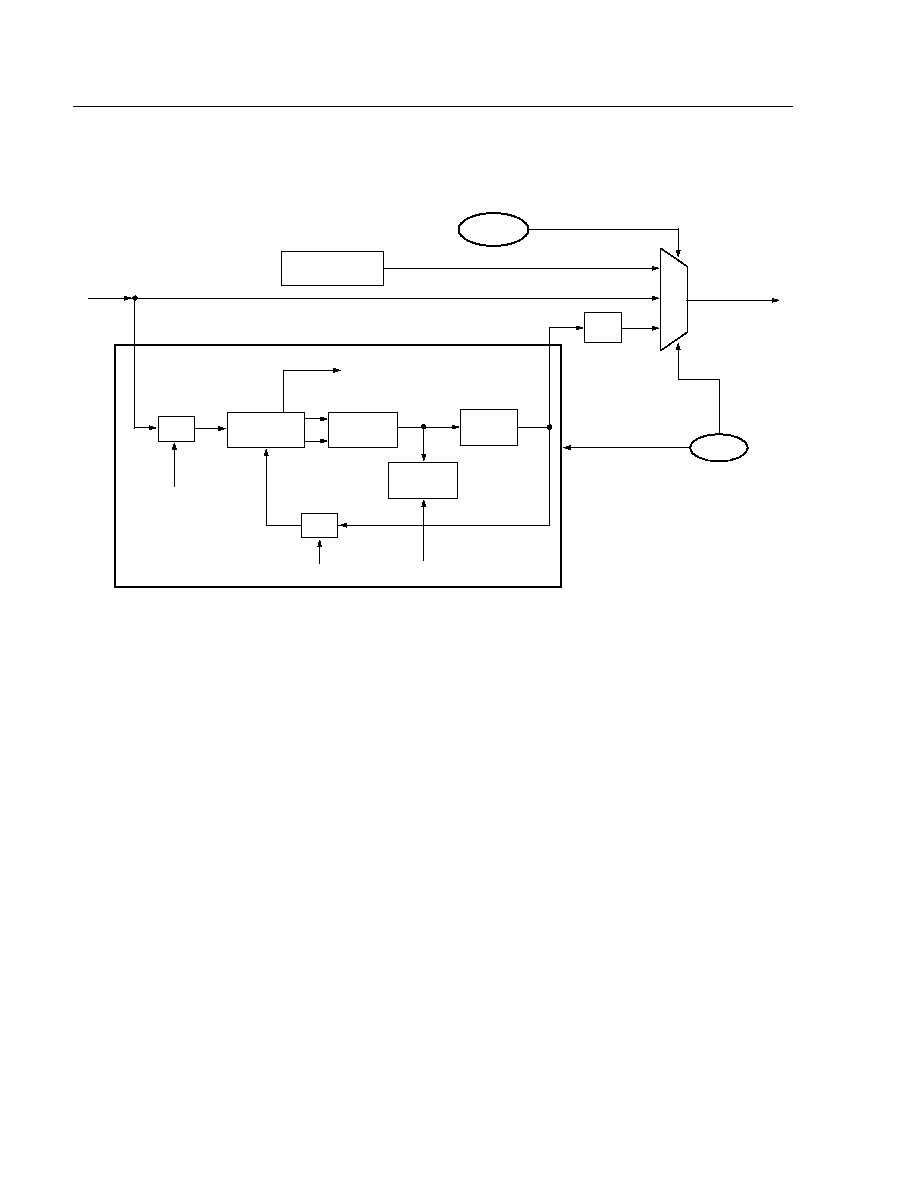
Preliminary Data Sheet
DSP1628 Digital Signal Processor
February 1997
36
Lucent Technologies Inc.
4 Hardware Architecture
(continued)
4.13 Clock Synthesis
Figure 10. Clock Source Block Diagram
powerc
RING
OSCILLATOR
M
U
X
˜
2
˜
N
PHASE
DETECTOR
CHARGE
PUMP
VCO
VCO CLOCK
f
VCO
LOOP
FILTER
˜
M
LF[3:0]
Mbits[4:0]
Nbits[2:0]
PLL/SYNTHESIZER
CKI INPUT CLOCK
LOCK
(FLAG TO INDICATE LOCK
CONDITION OF PLL)
f
CKI
f
SLOW CLOCK
SLOWCKI
pllc
PLLEN
INTERNAL
PROCESSOR
CLOCK
f
INTERNAL CLOCK
PLLSEL
f
CKI
5-4520 (F)
The DSP1628 provides an on-chip, programmable
clock synthesizer. Figure 10 is the clock source dia-
gram. The 1X CKI input clock, the output of the synthe-
sizer, or a slow internal ring oscillator can be used as
the source for the internal DSP clock. The clock synthe-
sizer is based on a phase-locked loop (PLL), and the
terms clock synthesizer and PLL are used interchange-
ably.
On powerup, CKI is used as the clock source for the
DSP. This clock is used to generate the internal proces-
sor clocks and CKO, where f
CKI
= f
CKO
. Setting the ap-
propriate bits in the pllc control register (described in
Table 36) will enable the clock synthesizer to become
the clock source. The powerc register, which is dis-
cussed in Section 4.14, can override the selection to
stop clocks or force the use of the slow clock for low-
power operation.
PLL Control Signals
The input to the PLL comes from one of the three mask-
programmable clock options: CMOS, or small-signal.
The PLL cannot operate without an external input clock.
To use the PLL, the PLL must first be allowed to stabi-
lize and lock to the programmed frequency. After the
PLL has locked, the LOCK flag is set and the lock detect
circuitry is disabled. The synthesizer can then be used
as the clock source. Setting the PLLSEL bit in the pllc
register will switch sources from f
CKI
to f
VCO
/2 without
glitching. It is important to note that the setting of the
pllc register must be maintained. Otherwise, the PLL
will seek the new set point. Every time the pllc register
is written, the LOCK flag is reset.

Preliminary Data Sheet
February 1997
DSP1628 Digital Signal Processor
Lucent Technologies Inc.
37
4 Hardware Architecture
(continued)
The frequency of the PLL output clock, f
VCO
, is deter-
mined by the values loaded into the 3-bit N divider and
the 5-bit M divider. When the PLL is selected and
locked, the frequency of the internal processor clock is
related to the frequency of CKI by the following equa-
tions:
f
VCO
= f
CKI
* M/N
f
INTERNAL CLOCK
= f
CKO
= f
VCO
˜
2
The frequency of the VCO, f
VCO
, must fall within the
range listed in Table 63. Also note that f
VCO
must be at
least twice f
CKI
.
The coding of the Mbits and Nbits is described as fol-
lows:
Mbits = M
-
2
if (N = 1)
Nbits = 0x7
else
Nbits = N
-
2
where N ranges from 1 to 8 and M ranges from 2 to 20.
The loop filter bits LF[3:0] should be programmed ac-
cording to Table 64.
Two other bits in the pllc register control the PLL. Clear-
ing the PLLEN bit powers down the PLL; setting this bit
powers up the PLL. Clearing the PLLSEL bit deselects
the PLL so that the DSP is clocked by a 1X version of
the CKI input; setting the PLLSEL bit selects the PLL-
generated clock for the source of the DSP internal pro-
cessor clock. The pllc register is cleared on reset and
powerup. Therefore, the DSP comes out of reset with
the PLL deselected and powered down. M and N should
be changed only while the PLL is deselected. The val-
ues of M and N should not be changed when powering
down or deselecting the PLL.
As previously mentioned, the PLL also provides a user
flag, LOCK, to indicate when the loop has locked. When
this flag is not asserted, the PLL output is unstable. The
DSP should not be switched to the PLL-based clock
without first checking that the lock flag is set. The lock
flag is cleared by writing to the pllc register. When the
PLL is deselected, it is necessary to wait for the PLL to
relock before the DSP can be switched to the PLL-
based clock. Before the input clock is stopped, the PLL
should be powered down. Otherwise, the LOCK flag will
not be reset and there may be no way to determine if the
PLL is stable, once the input clock is applied again.
The lock-in time depends on the frequency of operation
and the values programmed for M and N (see Table 64).

Preliminary Data Sheet
DSP1628 Digital Signal Processor
February 1997
38
Lucent Technologies Inc.
4 Hardware Architecture
(continued)
PLL Programming Examples
The following section of code illustrates how the PLL would be initialized on powerup, assuming the following oper-
ating conditions:
CKI input frequency = 10 MHz
Internal clock and CKO frequency = 50 MHz
VCO frequency = 100 MHz
Input divide down count N = 2 (Set Nbits[2:0] = 000 to get N = 2, as described in Table 36.)
Feedback down count M = 20 (Set Mbits[4:0] = 10010 to get M = 18 + 2 = 20, as described in Table 36.)
The device would come out of reset with the PLL disabled and deselected.
pllinit: pllc = 0x2912
/* Running CKI input clock at 10 MHz, set up counters in PLL */
pllc = 0xA912 /* Power on PLL, but PLL remains deselected */
call pllwait
/* Loop to check for LOCK flag assertion */
pllc = 0xE912 /* Select high-speed, PLL clock */
goto start
/* User's code, now running at 50 MHz */
pllwait: if lock return
goto pllwait
Programming examples which illustrate how to use the PLL with the various power management modes are listed
in Section 4.14.
Latency
The switch between the CKI-based clock and the PLL-based clock is synchronous. This method results in the actual
switch taking place several cycles after the PLLSEL bit is changed. During this time, actual code can be executed,
but it will be at the previous clock rate. Table 16 shows the latency times for switching between CKI-based and PLL-
based clocks. In the example given, the delay to switch to the PLL source is 1--4 CKO cycles and to switch back is
11--31 CKO cycles.
Frequency Accuracy and Jitter
When using the PLL to multiply the input clock frequency up to the instruction clock rate, it is important to realize
that although the average frequency of the internal clock and CKO will have about the same relative accuracy as
the input clock, noise sources within the DSP will produce jitter on the PLL clock such that each individual clock
period will have some error associated with it. The PLL is guaranteed only to have sufficiently low jitter to operate
the DSP, and thus, this clock should not be used as an input to jitter-sensitive devices in the system.
V
DDA
and V
SSA
Connections
The PLL has its own power and ground pins, V
DDA
and V
SSA
. Additional filtering should be provided for V
DDA
in the
form of a ferrite bead connected from V
DDA
to V
DD
and two decoupling capacitors (4.7
µ
F tantalum in parallel with
a 0.01
µ
F ceramic) from V
DDA
to V
SS
. V
SSA
can be connected directly to the main ground plane. This recommen-
dation is subject to change and may need to be modified for specific applications depending on the characteristics
of the supply noise.
Note: For devices with the CMOS clock input option, the CKI2 pin should be connected to V
SSA
.
Table 16. Latency Times for Switching Between CKI and PLL-Based Clocks
Minimum
Latency (cycles)
Maximum
Latency (cycles)
Switch to PLL-based clock
1
N + 2
Switch from PLL-based clock
M/N + 1
M + M/N + 1

Preliminary Data Sheet
February 1997
DSP1628 Digital Signal Processor
Lucent Technologies Inc.
39
4 Hardware Architecture
(continued)
4.14 Power Management
There are three different control mechanisms for putting
the DSP1628 into low-power modes: the powerc con-
trol register, the STOP pin, and the AWAIT bit in the alf
register. The PLL can also be disabled with the PLLEN
bit of the pllc register for more power saving.
Powerc Control Register Bits
The powerc register has 10 bits that power down vari-
ous portions of the chip and select the clock source:
XTLOFF: Assertion of the XTLOFF bit powers down the
small-signal input circuit, disabling the internal proces-
sor clock. Since the small-signal input circuit takes
many cycles to stabilize, care must be taken with the
turn-on sequence, as described later.
SLOWCKI: Assertion of the SLOWCKI bit selects the
ring oscillator as the clock source for the internal pro-
cessor clock instead of CKI or the PLL. When CKI or the
PLL is selected, the ring oscillator is powered down.
Switching of the clocks is synchronized so that no par-
tial or short clock pulses occur. Two nops should follow
the instruction that sets or clears SLOWCKI.
NOCK: Assertion of the NOCK bit synchronously turns
off the internal processor clock, regardless of whether
its source is provided by CKI, the PLL, or the ring oscil-
lator. The NOCK bit can be cleared by resetting the chip
with the RSTB pin, or asserting the INT0 or INT1 pins.
Two nops should follow the instruction that sets NOCK.
The PLL remains running, if enabled, while NOCK is
set.
INT0EN: This bit allows the INT0 pin to asynchronously
clear the NOCK bit, thereby allowing the device to con-
tinue program execution from where it left off without
any loss of state. No chip reset is required. It is recom-
mended that, when INT0EN is to be used, the INT0
interrupt be disabled in the inc register so that an unin-
tended interrupt does not occur. After the program re-
sumes, the INT0 interrupt in the ins register should be
cleared.
INT1EN: This bit enables the INT1 pin to be used as the
NOCK clear, exactly like INT0EN previously described.
The following control bits power down the peripheral
I/O units of the DSP. These bits can be used to further
reduce the power consumption during standard sleep
mode.
SIO1DIS: This is a powerdown signal to the SIO1 I/O
unit. It disables the clock input to the unit, thus elimi-
nating any sleep power associated with the SIO1.
Since the gating of the clocks may result in incomplete
transactions, it is recommended that this option be
used in applications where the SIO1 is not used or
when reset may be used to reenable the SIO1 unit.
Otherwise, the first transaction after reenabling the unit
may be corrupted.
SIO2DIS: This bit powers down the SIO2 in the same
way SIO1DIS powers down the SIO1.
PHIFDIS: This is a powerdown signal to the parallel
host interface. It disables the clock input to the unit,
thus eliminating any sleep power associated with the
PHIF. Since the gating of the clocks may result in in-
complete transactions, it is recommended that this op-
tion be used in applications where the PHIF is not
used, or when reset may be used to reenable the
PHIF. Otherwise, the first transaction after reenabling
the unit may be corrupted.
TIMERDIS: This is a timer disable signal which dis-
ables the clock input to the timer unit. Its function is
identical to the DISABLE field of the timerc control
register. Writing a 0 to the TIMERDIS field will continue
the timer operation.
Figure 11 shows a functional view of the effect of the
bits of the powerc register on the clock circuitry. It
shows only the high-level operation of each bit. Not
shown are the bits that power down the peripheral
units.
STOP Pin
Assertion (active-low) of the STOP pin has the same
effect as setting the NOCK bit in the powerc register.
The internal processor clock is synchronously disabled
until the STOP pin is returned high. Once the STOP
pin is returned high, program execution will continue
from where it left off without any loss of state. No chip
reset is required. The PLL remains running, if enabled,
during STOP assertion.
The pllc Register Bits
The PLLEN bit of the pllc register can be used to pow-
er down the clock synthesizer circuitry. Before shutting
down the clock synthesizer circuitry, the system clock
should be switched to either CKI using the PLLSEL bit
of pllc, or to the ring oscillator using the SLOWCKI bit
of powerc.
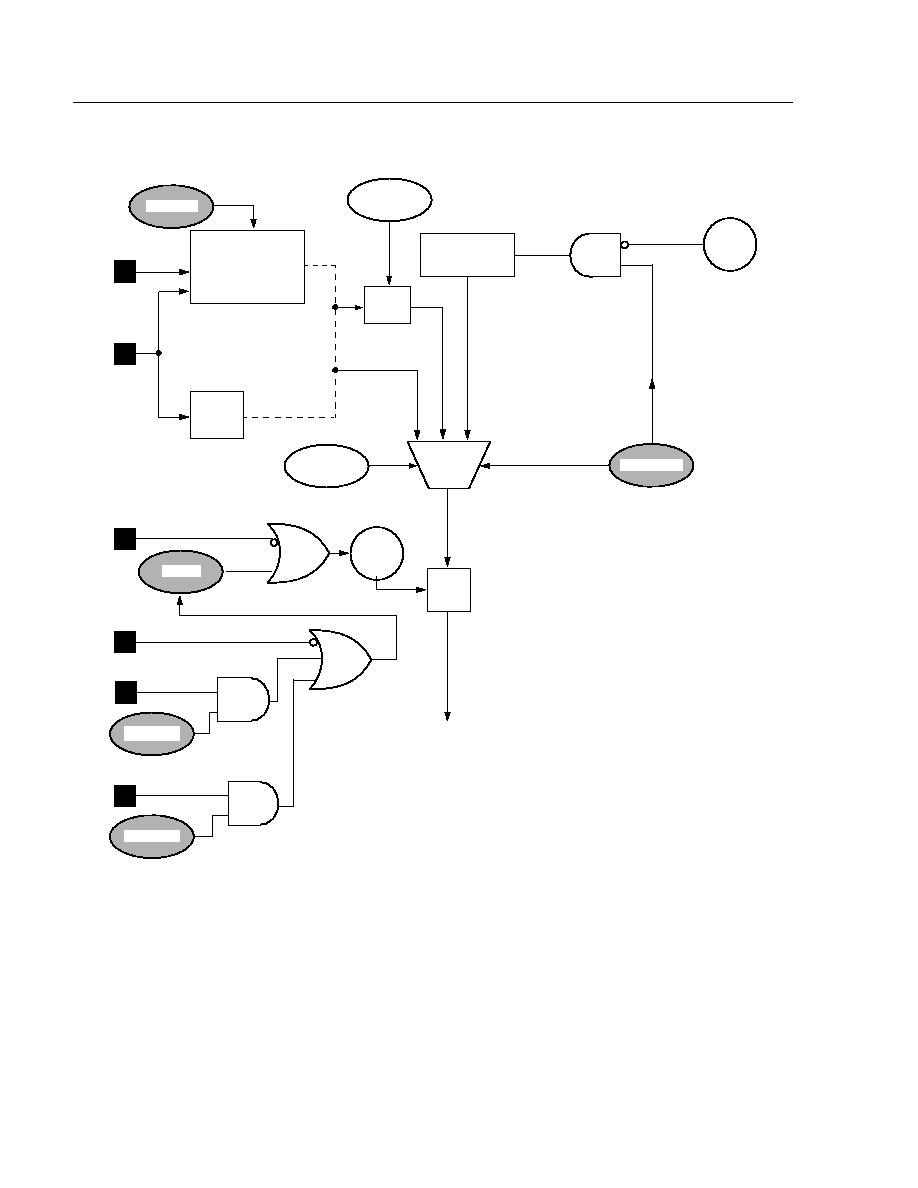
Preliminary Data Sheet
DSP1628 Digital Signal Processor
February 1997
40
Lucent Technologies Inc.
4 Hardware Architecture
(continued)
Notes:
The functions in the shaded ovals are bits in the powerc control register. The functions in the nonshaded ovals are bits in the pllc control
register.
Deep sleep is the state arrived at either by a hardware or software stop of the internal processor clock.
The switching of the multiplexers and the synchronous gate is designed so that no partial clocks or glitching will occur.
When the deep sleep state is entered with the ring oscillator selected, the internal processor clock is turned off before the ring oscillator is
powered down.
PLL select is the PLLSEL bit of pllc; PLL powerdown is the PLLEN bit of pllc.
Figure 11. Power Management Using the powerc and the pllc Registers
CKI2
SMALL SIGNAL
CLOCK
RING
OSCILLATOR
STOP
XTLOFF
MASK-PROGRAMMABLE
OPTION
OFF
CKI
RSTB
CMOS
INPUT
CLOCK
SYNC.
GATE
SLOWCKI
SYNC.
MUX
INTERNAL
PROCESSOR
CLOCK
CLEAR NOCK
DISABLE
INT0
INT0EN
ON
INT1
INT1EN
DEEP
SLEEP
HW STOP
SW STOP
NOCK
PLLEN
PLLSEL
PLL
f
VCO/2
f
SLOW CLOCK
f
INTERNAL CLOCK
f
CKI
DEEP
SLEEP
5-4124 (F).c

Preliminary Data Sheet
February 1997
DSP1628 Digital Signal Processor
Lucent Technologies Inc.
41
4 Hardware Architecture
(continued)
Await Bit of the alf Register
Setting the AWAIT bit of the alf register causes the processor to go into the standard sleep state or power-saving
standby mode. Operation of the AWAIT bit is the same as in the DSP1610, DSP1611, DSP1616, DSP1617, and
DSP1618. In this mode, the minimum circuitry required to process an incoming interrupt remains active, and the PLL
remains active if enabled. An interrupt will return the processor to the previous state, and program execution will
continue. The action resulting from setting the AWAIT bit and the action resulting from setting bits in the powerc
register are mostly independent. As long as the processor is receiving a clock, whether slow or fast, the DSP may
be put into standard sleep mode with the AWAIT bit. Once the AWAIT bit is set, the STOP pin can be used to stop
and later restart the processor clock, returning to the standard sleep state. If the processor clock is not running, how-
ever, the AWAIT bit cannot be set.
Power Management Sequencing
There are important considerations for sequencing the power management modes. The small-signal clock input
circuit has a start-up delay which must be taken into account, and the PLL requires a delay to reach lock-in. Also,
the chip may or may not need to be reset following a return from a low-power state.
Devices with a small-signal input clocking option may use the XTLOFF bit in the powerc register to power down the
on-chip oscillator or small-signal circuitry, thereby reducing the power dissipation. When reenabling the oscillator or
the small-signal circuitry, it is important to bear in mind that a start-up interval exists during which time the clocks
are not stable. Two scenarios exist here:
1. Immediate Turn-Off, Turn-On with RSTB: This scenario applies to situations where the target device is not re-
quired to execute any code while the small-signal input circuit is powered down and where restart from a reset
state can be tolerated. In this case, the processor clock derived from either the oscillator or the small-signal input
is running when XTLOFF is asserted. This effectively stops the internal processor clock. When the system choos-
es to reenable the oscillator or small-signal input, a reset of the device will be required. The reset pulse must be
of sufficient duration for the small-signal start-up interval to be satisfied (required for the small-signal input circuit
to reach its dc operating point). A minimum reset pulse of 20
µ
s will be adequate. The falling edge of the reset
signal, RSTB, will asynchronously clear the XTLOFF field, thus reenabling the power to the small-signal circuitry.
The target DSP will then start execution from a reset state, following the rising edge of RSTB.
2. Running from Slow Clock While XTLOFF Active: The second scenario applies to situations where the device
needs to continue execution of its target code. In this case, the device switches to the slow ring oscillator clock
first, by enabling the SLOWCKI field. Then, if the small-signal input is being used, power down this circuitry by
writing a 1 to the XTLOFF field. Two nops are needed in between the two write operations to the powerc register.
The target device will then continue execution of its code at slow speed, while the small-signal input clock is
turned off. Switching from the slow clock back to the high-speed clock is then accomplished in three user steps.
First, XTLOFF is cleared. Then, a user-programmed routine sets the internal timer to a delay to wait for the small-
signal input oscillations to become stable. When the timer counts down to zero, the high-speed clock is selected
by clearing the SLOWCKI field, either in the timer's interrupt service routine or following a timer polling loop. If
PLL operation is desired, then an additional routine is necessary to enable the PLL and wait for it to lock.

Preliminary Data Sheet
DSP1628 Digital Signal Processor
February 1997
42
Lucent Technologies Inc.
4 Hardware Architecture
(continued)
Power Management Examples Without the PLL
The following examples show the more significant options for reducing the power dissipation. These are valid only
if the pllc register is set to disable and deselect the PLL (PLLEN = 0, PLLSEL = 0).
Standard Sleep Mode. This is the standard sleep mode. While the processor is clocked with a high-speed clock,
CKI, the alf register's AWAIT bit is set. Peripheral units may be turned off to further reduce the sleep power.
powerc = 0X00F0
/* Turn off peripherals, core running with CKI */
sleep:a0 = 0x8000
/* Set alf register in cache loop if running from */
do 1 {
/* external memory with >1 wait state */
alf = a0
/* Stop internal processor clock, interrupt circuits */
nop
/* active */
}
nop
/* Needed for bedtime execution. Only sleep power */
nop
/* consumed here until.... interrupt wakes up the device */
cont: . . .
/* User code executes here */
powerc = 0x0
/* Turn peripheral units back on */
Sleep with Slow Internal Clock. In this case, the ring oscillator is selected to clock the processor before the device
is put to sleep. This will reduce the power dissipation while waiting for an interrupt to continue program execution.
powerc = 0x40F0
/* Turn off peripherals and select slow clock */
2*nop
/* Wait for it to take effect */
sleep:a0 = 0x8000
/* Set alf register in cache loop if running from */
do 1 {
/* external memory with >1 wait state */
alf = a0
/* Stop internal processor clock, interrupt circuits */
nop
/* active */
}
nop
/* Needed for bedtime execution. Reduced sleep power */
nop
/* consumed here.... Interrupt wakes up the device */
cont: . . .
/* User code executes here */
powerc = 0x00F0
/* Select high-speed clock */
2*nop
/* Wait for it to take effect */
powerc = 0x0000
/* Turn peripheral units back on */
Note that, in this case, the wake-up latency is determined by the period of the ring oscillator clock.
Sleep with Slow Internal Clock and Small-Signal Disabled. If the target device contains the small-signal clock
option, the clock input circuitry can be powered down to further reduce power. In this case, the slow clock must be
selected first.
powerc = 0x40F0
/* Turn off peripherals and select slow clock */
2*nop
/* Wait for it to take effect */
powerc = 0xC0F0
/* Turn off the small-signal input buffer */
sleep:a0 = 0x8000
/* Set alf register in cache loop if running from */
do 1 {
/* external memory with >1 wait state */
alf = a0
/* Stop internal processor clock, interrupt circuits */
nop
/* active */
}
nop
/* Needed for bedtime execution. Reduced sleep power */
nop
/* consumed here.... Interrupt wakes up the device */
powerc = 0x40F0
/* Clear XTLOFF, reenable small-signal */
call xtlwait
/* Wait until small-signal is stable */
cont: powerc = 0x00F0
/* Select high-speed clock */
2*nop
/* Wait for it to take effect */
powerc = 0x0000
/* Turn peripheral units back on */
Note that, in this case, the wake-up latency is dominated by the small-signal start-up period.

Preliminary Data Sheet
February 1997
DSP1628 Digital Signal Processor
Lucent Technologies Inc.
43
4 Hardware Architecture
(continued)
Software Stop. In this case, all internal clocking is disabled. INT0, INT1, or RSTB may be used to reenable the
clocks. The power management must be done in correct sequence.
powerc = 0x4000
/* SLOWCKI asserted */
2*nop
/* Wait for it to take effect */
powerc = 0xD000
/* XTLOFF asserted if applicable and INT0EN asserted */
inc = NOINT0
/* Disable the INT0 interrupt */
sopor:powerc = 0xF000
/* NOCK asserted, all clocks stop */
/* Minimum switching power consumed here */
3*nop
/* Some nops will be needed */
/* INT0 pin clears the NOCK field, clocking resumes */
cont: powerc = 0x4000
/* INT0EN cleared and XTLOFF cleared, if applicable*/
call waitxtl
/* Wait for the small-signal to */
/* stabilize, if applicable*/
powerc = 0x0
/* Clear SLOWCKI field, back to high speed */
2*nop
/* Wait for it to take effect */
ins = 0x0010
/* Clear the INT0 status bit */
In this case also, the wake-up latency is dominated by the small-signal start-up period.
The previous examples do not provide an exhaustive list of options available to the user. Many different clocking
possibilities exist for which the target device may be programmed, depending on:
s
The clock source to the processor.
s
Whether the user chooses to power down the peripheral units.
s
The operational state of the small-signal clock input, powered or unpowered.
s
Whether the internal processor clock is disabled through hardware or software.
s
The combination of power management modes the user chooses.
s
Whether or not the PLL is enabled.
An example subroutine for xtlwait follows:
xtlwait:
timer0 = 0x2710
/* Load a count of 10,000 into the timer
*/
timerc = 0x0010
/* Start the timer with a PRESCALE of two */
inc = 0x0000
/* Disable the interrupts
*/
loop1:
a0 = ins
/* Poll the ins register
*/
a0 = a0 & 0x0100
/* Check bit 8 (TIME) of the ins register */
if eq goto loop1
/* Loop if the bit is not set
*/
ins = 0x0100
/* Clear the TIME interrupt bit
*/
return
/* Return to the main program
*/

Preliminary Data Sheet
DSP1628 Digital Signal Processor
February 1997
44
Lucent Technologies Inc.
4 Hardware Architecture
(continued)
Power Management Examples with the PLL
The following examples show the more significant options for reducing power dissipation if operation with the PLL
clock synthesizer is desired.
Standard Sleep Mode, PLL Running. This mode would be entered in the same manner as without the PLL. While
the input to the clock synthesizer, CKI, remains running, the alf register's AWAIT bit is set. The PLL will continue to
run and dissipate power. Peripheral units may be turned off to further reduce the sleep power.
powerc = 0x00F0
/* Turn off peripherals, core running with PLL */
sleep:a0 = 0x8000
/* Set alf register in cache loop if running from */
do 1 {
/* external memory with >1 wait state */
alf = a0
/* Stop internal processor clock, interrupt circuits */
nop
/* active */
}
nop
/* Needed for bedtime execution. Only sleep power plus PLL */
nop
/* power consumed here.... Interrupt wakes up the device */
cont: . . .
/* User code executes here */
powerc = 0x0
/* Turn peripheral units back on */
Sleep with Slow Internal Clock, PLL Running. In this case, the ring oscillator is selected to clock the processor
before the device is put to sleep. This will reduce power dissipation while waiting for an interrupt to continue program
execution.
powerc = 0x40F0
/* Turn off peripherals and select slow clock */
2*nop
/* Wait for slow clock to take effect */
sleep:a0 = 0x8000
/* Set alf register in cache loop if running from */
do 1 {
/* external memory with >1 wait state */
alf = a0
/* Stop internal processor clock, interrupt circuits */
nop
/* active */
}
nop
/* Needed for bedtime execution. Reduced sleep power, PLL */
nop
/* power, and ring oscillator power consumed here... */
/* Interrupt wakes up the device */
cont: . . .
/* User code executes here */
powerc = 0x00F0
/* Select high-speed PLL based clock */
2*nop
/* Wait for it to take effect */
powerc = 0x0000
/* Turn peripheral units back on */

Preliminary Data Sheet
February 1997
DSP1628 Digital Signal Processor
Lucent Technologies Inc.
45
4 Hardware Architecture
(continued)
Sleep with Slow Internal Clock and Small-Signal Disabled, PLL Disabled. If the target device contains the small-
signal clock option, the clock input circuitry can be powered down to further reduce power. In this case, the slow
clock must be selected first, and then the PLL must be disabled, since the PLL cannot run without the clock input
circuitry being active.
powerc = 0x40F0
/* Turn off peripherals and select slow clock */
2*nop
/* Wait for slow clock to take effect */
pllc = 0x29F2
/* Disable PLL (assume N = 1,M = 20, LF = 1001) */
powerc = 0xC0F0
/* Disable small-signal input buffer */
sleep:a0 = 0x8000
/* Set alf register in cache loop if running from */
do 1 {
/* external memory with >1 wait state */
alf = a0
/* Stop internal processor clock, interrupt circuits */
nop
/* active */
}
nop
/* Needed for bedtime execution. Reduced sleep power
nop
/* consumed here.... Interrupt wakes up device */
powerc = 0x40F0
/* Clear XTLOFF, leave PLL disabled */
call xtlwait
/* Wait until small-signal is stable */
pllc = 0xE9F2
/* Enable PLL, continue to run off slow clock */
call pllwait
/* Loop to check for LOCK flag assertion */
cont: powerc = 0x00F0
/* Select high-speed PLL based clock */
2*nop
/* Wait for it to take effect */
powerc = 0x0000
/* Turn peripherals back on */
Software Stop, PLL Disabled. In this case, all internal clocking is disabled. INT0, INT1, or RSTB may be used to
reenable the clocks. The power management must be done in the correct sequence, with the PLL being disabled
before shutting down the clock input buffer.
powerc = 0x4000
/* SLOWCKI asserted */
2*nop
/* Wait for slow clock to take effect */
pllc = 0x29F2
/* Disable PLL (assume N = 1, M = 20, LF = 1001) */
powerc = 0xD000
/* XTLOFF asserted, if applicable and INT0EN
/* asserted */
sopor:powerc = 0xF000
/* NOCK asserted, all clocks stop */
/* Minimum switching power consumed here */
3*nop
/* Some nops will be needed */
/* INT0 pin clears NOCK field, clocking resumes */
cont: powerc = 0x4000
/* INTOEN cleared and XTLOFF cleared, if applicable */
call xtlwait
/* Wait until small-signal is stable */
/* if applicable */
pllc = 0xE9F2
/* Enable PLL, continue to run off slow clock */
call pllwait
/* Loop to check for LOCK flag assertion */
powerc = 0x0
/* Select high-speed PLL based clock */
2*nop
/* Wait for it to take effect */
ins = 0x0010
/* Clear the INT0 status bit */

Preliminary Data Sheet
DSP1628 Digital Signal Processor
February 1997
46
Lucent Technologies Inc.
5 Software Architecture
5.1 Instruction Set
The DSP1628 processor has seven types of instruc-
tions: multiply/ALU, special function, control, F3 ALU,
BMU, cache, and data move. The multiply/ALU instruc-
tions are the primary instructions used to implement sig-
nal processing algorithms. Statements from this group
can be combined to generate multiply/accumulate, log-
ical, and other ALU functions and to transfer data be-
tween memory and registers in the data arithmetic unit.
The special function instructions can be conditionally
executed based on flags from the previous ALU or BMU
operation, the condition of one of the counters, or the
value of a pseudorandom bit in the DSP1628 device.
Special function instructions perform shift, round, and
complement functions. The F3 ALU instructions enrich
the operations available on accumulators. The BMU in-
structions provide high-performance bit manipulation.
The control instructions implement the goto and call
commands. Control instructions can also be executed
conditionally. Cache instructions are used to implement
low-overhead loops, conserve program memory, and
decrease the execution time of certain multiply/ALU in-
structions. Data move instructions are used to transfer
data between memory and registers or between accu-
mulators and registers. See the
DSP1611/17/18/27
Digital Signal Processor Information Manual for a de-
tailed description of the instruction set.
The following operators are used in describing the in-
struction set:
*
16 x 16-bit ≠> 32-bit multiplication or register-in-
direct addressing when used as a prefix to an ad-
dress register or denotes direct addressing when
used as a prefix to an immediate
+
36-bit addition
≠
36-bit subtraction
>>
Arithmetic right shift
>>>
Logical right shift
<<
Arithmetic left shift
<<<
Logical left shift
|
36-bit bitwise OR
&
36-bit bitwise AND
^
36-bit bitwise EXCLUSIVE OR
:
Compound address swapping, accumulator
shuffling
~
One's complement
These are 36-bit operations. One operand is 36-bit data in an accu-
mulator; the other operand may be 16, 32, or 36 bits.
Object Code Compatibility
The DSP1628 is object code compatible with the
DSP1618 with the following exceptions:
s
ECCP user flag, EBUSY, which indicates error
correction coprocessor activity, has changed its
condition field.
The EBUSY flag is used in conjunction with the
if CON F2 or if CON goto/call/return instructions
to monitor the ECCP operation. The object code
corresponding to
ifc EBUSY
, for example, must be
modified to reflect the change in condition codes.
Alternately, the source code can be assembled using
DSP1628 development tools.
s
The SIO and SIO2 interrupts (IBF, IBF2, OBE, and
OBE2) are cleared one instruction cycle AFTER
reading or writing the serial data registers, (sdx[in],
sdx2[in], sdx[out], or sdx2[out]). To account for this
added latency, the user must ensure that a single
instruction (NOP or any other valid DSP16XX
instruction) follows the sdx register read or write
instruction prior to exiting an interrupt service routine
(via an ireturn or goto pi instruction) or before check-
ing the ins register for the SIO flag status. Adding
this instruction ensures that interrupts are not
reported incorrectly following an ireturn or that stale
flags are not read from the ins register. Refer to
TECHNICAL ADVISORY #23.
Multiply/ALU Instructions
Note that the function statements and transfer state-
ments in Table 17 are chosen independently. Any func-
tion statement (F1) can be combined with any transfer
statement to form a valid multiply/ALU instruction. If ei-
ther statement is not required, a single statement from
either column also constitutes a valid instruction. The
number of cycles to execute the instruction is a function
of the transfer column. (An instruction with no transfer
statement executes in one instruction cycle.) Whenever
PC, pt, or rM is used in the instruction and points to ex-
ternal memory, the programmed number of wait-states
must be added to the instruction cycle count. All multi-
ply/ALU instructions require one word of program mem-
ory. The no-operation (nop) instruction is a special case
encoding of a multiply/ALU instruction and executes in
one cycle. The assembly-language representation of a
nop is either nop or a single semicolon.
Condition
CON
DSP1618
DSP1628
11100
ebusy
lock
11101
reserved
ebusy

Preliminary Data Sheet
February 1997
DSP1628 Digital Signal Processor
Lucent Technologies Inc.
47
5 Software Architecture
(continued)
A single-cycle squaring function is provided in DSP1628. By setting the X = Y = bit in the auc register, any instruction
that loads the high half of the y register also loads the x register with the same value. A subsequent instruction to
multiply the x register and y register results in the square of the value being placed in the p register. The instruction
a0 = p p = x*y y = *r0++ with the X = Y = bit set to one will read the value pointed to by r0, load it to both x and
y, multiply the previously fetched value of x and y, and transfer the previous product to a0. A table of values pointed
to by r0 can thus be squared in a pipeline with one instruction cycle per each value. Multiply/ALU instructions that
use x = X transfer statements (such as a0 = p p = x*y y = *r0++ x = *pt++) are not recommended for squaring
because pt will be incremented even though x is not loaded from the value pointed to by pt. Also, the same conflict
wait occurrences from reading the same bank of internal memory or reading from external memory apply, since the
X space fetch occurs (even though its value is not used).
The l in [ ] is an optional argument that specifies the low 16 bits of aT or y.
Add cycles for:
1. When an external memory access is made in X or Y space and wait-states are programmed, add the number of wait-states.
2. If an X space access and a Y space access are made to the same bank of DPRAM in one instruction, add one cycle.
Note: For transfer statements when loading the upper half of an accumulator, the lower half is cleared if the corresponding CLR bit in the auc
register is zero. auc is cleared by reset.
Table 17. Multiply/ALU Instructions
Function Statement
Transfer Statement
Cycles (Out/In Cache)
p = x * y
y = Y
x = X
2/1
aD = p
p = x * y
y = aT
x = X
2/1
aD = aS + p
p = x * y
y[l] = Y
1/1
aD = aS ≠ p
p = x * y
aT[l] = Y
1/1
aD = p
x = Y
1/1
aD = aS + p
Y
1/1
aD = aS ≠ p
Y = y[l]
2/2
aD = y
Y = aT[l]
2/2
aD = aS + y
Z:y
x = X
2/2
aD = aS ≠ y
Z:y[l]
2/2
aD = aS & y
Z:aT[l]
2/2
aD = aS | y
aD = aS ^ y
aS ≠ y
aS & y
Table 18. Replacement Table for Multiply/ALU Instructions
Replace
Value
Meaning
aD, aS, aT
a0, a1
One of two DAU accumulators.
X
*pt++, *pt++i
X memory space location pointed to by pt. pt is postmodified by +1
and i, respectively.
Y
*rM, *rM++, *rM--, rM++j
RAM location pointed to by rM (M = 0, 1, 2, 3). rM is postmodified by
0, +1, ≠1, or j, respectively.
Z
*rMzp, *rMpz, *rMm2, *rMjk
Read/Write compound addressing. rM (M = 0, 1, 2, 3) is used twice.
First, postmodified by 0, +1, ≠1, or j, respectively; and, second, post-
modified by +1, 0, +2, or k, respectively.

Preliminary Data Sheet
DSP1628 Digital Signal Processor
February 1997
48
Lucent Technologies Inc.
5 Software Architecture
(continued)
Special Function Instructions
All forms of the special function require one word of program memory and execute in one instruction cycle. (If PC
points to external memory, add programmed wait-states.)
aD = aS
--
Load destination accumulator from source accumulator
aD = ≠aS
--
2's complement
aD = ~aS
--
1's complement
aD = rnd(aS)
--
Round upper 20 bits of accumulator
aDh = aSh + 1 --
Increment upper half of accumulator (lower half cleared)
aD = aS + 1
--
Increment accumulator
aD = y
--
Load accumulator with 32-bit y register value with sign extend
aD = p
--
Load accumulator with 32-bit p register value with sign extend
The above special functions can be conditionally executed, as in:
if CON instruction
and with an event counter
ifc CON instruction
which means:
if CON is true then
c1 = c1 + 1
instruction
c2 = c1
else
c1 = c1 + 1
The above special function statements can be executed unconditionally by writing them directly, e.g., a0 = a1.
This function is not available for the DSP16A.
aD = aS >> 1
aD = aS >> 4
aD = aS >> 8
aD = aS >> 16
}
Arithmetic right shift (sign preserved) of 36-bit accumulators
aD = aS << 1
aD = aS << 4
aD = aS << 8
aD = aS << 16
}
Arithmetic left shift (sign not preserved) of the lower 32 bits of accumulators
(upper 4 bits are sign-bit-extended from bit 31 at the completion of the shift)
Table 19. Replacement Table for Special Function Instructions
Replace
Value
Meaning
aD
aS
a0, a1
One of two DAU accumulators.
CON
mi, pl, eq, ne, gt, le, lvs, lvc, mvs, mvc, c0ge, c0lt,
c1ge, c1lt, heads, tails, true, false, allt, allf,
somet, somef, oddp, evenp, mns1, nmns1,
npint, njint, lock, ebusy
See Table 21 for definitions of mnemonics.

Preliminary Data Sheet
February 1997
DSP1628 Digital Signal Processor
Lucent Technologies Inc.
49
5 Software Architecture
(continued)
Control Instructions
All control instructions executed unconditionally execute in two cycles, except icall which takes three cycles. Control
instructions executed conditionally execute in three instruction cycles. (If PC, pt, or pr point to external memory, add
programmed wait-states.) Control instructions executed unconditionally require one word of program memory, while
control instructions executed conditionally require two words. Control instructions cannot be executed from the
cache.
goto JA
goto pt
call JA
call pt
icall
return
(goto pr)
ireturn
(goto pi)
The goto JA and call JA instructions should not be placed in the last or next-to-last instruction before the boundary of a 4 Kwords page. If the
goto or call is placed there, the program counter will have incremented to the next page and the jump will be to the next page, rather than to
the desired current page.
The icall instruction is reserved for development system use.
The above control instructions, with the exception of ireturn and icall, can be conditionally executed. For example:
if le goto 0x0345
Table 20. Replacement Table for Control Instructions
Replace
Value
Meaning
CON
mi, pl, eq, ne, gt, le, nlvs, lvc, mvs, mvc, c0ge, c0lt,
c1ge, c1lt, heads, tails, true, false, allt, allf, somet,
somef, oddp, evenp, mns1, nmns1, npint, njint, lock,
ebusy
See Table 21 for definitions of mnemonics.
JA
12-bit value
Least significant 12 bits of absolute address
within the same 4 Kwords memory section.

Preliminary Data Sheet
DSP1628 Digital Signal Processor
February 1997
50
Lucent Technologies Inc.
5 Software Architecture
(continued)
Conditional Mnemonics (Flags)
Table 21 lists mnemonics used in conditional execution of special function and control instructions.
*
Result is not representable in the 36-bit accumulators (36-bit overflow).
Bits 35--31 are not the same (32-bit overflow).
Notes:
Testing the state of the counters (c0 or c1) automatically increments the counter by one.
The heads or tails condition is determined by a randomly set or cleared bit, respectively. The bit is randomly set with a probability of 0.5. A random
rounding function can be implemented with either heads or tails. The random bit is generated by a ten-stage pseudorandom sequence generator
(PSG) that is updated after either a heads or tails test. The pseudorandom sequence may be reset by writing any value to the pi register, except
during an interrupt service routine (ISR). While in an ISR, writing to the pi register updates the register and does not reset the PSG. If not in an
ISR, writing to the pi register resets the PSG. (The pi register is updated, but will be written with the contents of the PC on the next instruction.)
Interrupts must be disabled when writing to the pi register. If an interrupt is taken after the pi write, but before pi is updated with the PC
value, the ireturn instruction will not return to the correct location. If the RAND bit in the auc register is set, however, writing the pi register never
resets the PSG.
Table 21. DSP1628 Conditional Mnemonics
Test
Meaning
Test
Meaning
pl
Result is nonnegative (sign bit is bit 35).
0
mi
Result is negative. < 0
eq
Result is equal to 0. = 0
ne
Result is not equal to 0.
0
gt
Result is greater than 0. > 0
le
Result is less than or equal to 0.
0
lvs
Logical overflow set.
*
lvc
Logical overflow clear.
mvs
Mathematical overflow set.
mvc
Mathematical overflow clear.
c0ge
Counter 0 greater than or equal to 0.
c0lt
Counter 0 less than 0.
c1ge
Counter 1 greater than or equal to 0.
c1lt
Counter 1 less than 0.
heads
Pseudorandom sequence bit set.
tails
Pseudorandom sequence bit clear.
true
The condition is always satisfied in an if in-
struction.
false
The condition is never satisfied in an if in-
struction.
allt
All True, all BIO input bits tested compared
successfully.
allf
All False, no BIO input bits tested compared
successfully.
somet
Some True, some BIO input bits tested com-
pared successfully.
somef
Some False, some BIO input bits tested did
not compare successfully.
oddp
Odd Parity, from BMU operation.
evenp
Even Parity, from BMU operation.
mns1
Minus 1, result of BMU operation.
nmns1
Not Minus 1, result of BMU operation.
npint
Not PINT, used by hardware development
system.
njint
Not JINT, used by hardware development
system.
lock
The PLL has achieved lock and is stable.
ebusy
ECCP Busy, indicates error correction copro-
cessor activity.

Preliminary Data Sheet
February 1997
DSP1628 Digital Signal Processor
Lucent Technologies Inc.
51
5 Software Architecture
(continued)
F3 ALU Instructions
These instructions are implemented in the DSP1600 core. They allow accumulator two-operand operations with ei-
ther another accumulator, the p register, or a 16-bit immediate operand (IM16). The result is placed in a destination
accumulator that can be independently specified. All operations are done with the full 36 bits. For the accumulator
with accumulator operations, both inputs are 36 bits. For the accumulator with p register operations, the p register
is sign-extended into bits 35--32 before the operation. For the accumulator high with immediate operations, the im-
mediate is sign-extended into bits 35--32 and the lower bits 15--0 are filled with zeros, except for the AND opera-
tion, for which they are filled with ones. These conventions allow the user to do operations with 32-bit immediates
by programming two consecutive 16-bit immediate operations. The F3 ALU instructions are shown in Table 22.
Table 22. F3 ALU Instructions
Note: The F3 ALU instructions that do not have a destination accumulator are used to set flags for conditional
operations, i.e., bit test operations.
If PC points to external memory, add programmed wait-states.
The h and l are required notation in these instructions.
F4 BMU Instructions
The bit manipulation unit in the DSP1628 provides a set of efficient bit manipulation operations on accumulators. It
contains four auxiliary registers, ar<0--3> (arM, M = 0, 1, 2, 3), two alternate accumulators (aa0--aa1), which can
be shuffled with the working set, and four flags (oddp, evenp, mns1, and nmns1). The flags are testable by condi-
tional instructions and can be read and written via bits 4--7 of the alf register. The BMU also sets the LMI, LEQ,
LLV, and LMV flags in the psw register:
LMI = 1 if negative (i.e., bit 35 = 1)
LEQ = 1 if zero (i.e., bits 35--0 are 0)
LLV = 1 if (a) 36-bit overflow, or if (b) illegal shift on field width/offset condition
LMV = 1 if bits 31--35 are not the same (32-bit overflow)
The BMU instructions and cycle times follow. (If PC points to external memory, add programmed wait-states.) All
BMU instructions require 1 word of program memory unless otherwise noted. Please refer to the
DSP1611/17/18/
27 Digital Signal Processor Information Manual for further discussion of the BMU instructions.
F3 ALU Instructions
Cacheable (one-cycle)
Not Cacheable (two-cycle)
aD = aS + aT
aD = aS ≠ aT
aD = aS & aT
aD = aS | aT
aD = aS ^ aT
aS ≠ aT
aS & aT
aD = aS + p
aD = aS ≠ p
aD = aS & p
aD = aS | p
aD = aS ^ p
aS ≠ p
aS & p
aD = aSh + IM16
aD = aSh ≠ IM16
aD = aSh & IM16
aD = aSh | IM16
aD = aSh ^ IM16
aSh ≠ IM16
aSh & IM16
aD = aSl + IM16
aD = aSl ≠ IM16
aD = aSl & IM16
aD = aSl | IM16
aD = aSl ^ IM16
aSl ≠ IM16
aSl & IM16

Preliminary Data Sheet
DSP1628 Digital Signal Processor
February 1997
52
Lucent Technologies Inc.
5 Software Architecture
(continued)
s
Barrel Shifter
aD = aS >> IM16
Arithmetic right shift by immediate (36-bit, sign filled in); 2-cycle, 2-word.
aD = aS >> arM
Arithmetic right shift by arM (36-bit, sign filled in); 1-cycle.
aD = aS >> aS
Arithmetic right shift by aS (36-bit, sign filled in); 2-cycle.
aD = aS >>> IM16
Logical right shift by immediate (32-bit shift, 0s filled in); 2-cycle, 2-word.
aD = aS >>> arM
Logical right shift by arM (32-bit shift, 0s filled in); 1-cycle.
aD = aS >>> aS
Logical right shift by aS (32-bit shift, 0s filled in); 2-cycle.
aD = aS << IM16
Arithmetic left shift
by immediate (36-bit shift, 0s filled in); 2-cycle, 2-word.
aD = aS << arM
Arithmetic left shift
by arM (36-bit shift, 0s filled in); 1-cycle.
aD = aS << aS
Arithmetic left shift
by aS (36-bit shift, 0s filled in); 2-cycle.
aD = aS <<< IM16
Logical left shift by immediate (36-bit shift, 0s filled in); 2-cycle, 2-word.
aD = aS <<< arM
Logical left shift by arM (36-bit shift, 0s filled in); 1-cycle.
aD = aS <<< aS
Logical left shift by aS (36-bit shift, 0s filled in); 2-cycle.
Not the same as the special function arithmetic left shift. Here, the guard bits in the destination accumulator are shifted into, not sign-extended.
s
Normalization and Exponent Computation
aD = exp(aS)
Detect the number of redundant sign bits in accumulator; 1-cycle.
aD = norm(aS, arM)
Normalize aS with respect to bit 31, with exponent in arM; 1-cycle.
s
Bit Field Extraction and Insertion
aD = extracts(aS, IM16) Extraction with sign extension, field specified as immediate; 2-cycle, 2-word.
aD = extracts(aS, arM) Extraction with sign extension, field specified in arM; 1-cycle.
aD = extractz(aS, IM16) Extraction with zero extension, field specified as immediate; 2-cycle, 2-word.
aD = extractz(aS, arM) Extraction with zero extension, field specified in arM; 1-cycle.
aD = insert(aS, IM16)
Bit field insertion, field specified as immediate; 2-cycle, 2-word.
aD = insert(aS, arM)
Bit field insertion, field specified in arM; 2-cycle.
Note: The bit field to be inserted or extracted is specified as follows. The width (in bits) of the field is the upper
byte of the operand (immediate or arM), and the offset from the LSB is in the lower byte.
s
Alternate Accumulator Set
aD = aS:aa0
Shuffle accumulators with alternate accumulator 0 (aa0); 1-cycle.
aD = aS:aa1
Shuffle accumulators with alternate accumulator 1 (aa1); 1-cycle.
Note: The alternate accumulator gets what was in aS. aD gets what was in the alternate accumulator.
Table 23. Replacement Table for F3 ALU Instructions and F4 BMU Instructions
Replace Value
Meaning
aD, aT, aS
a0 or a1
One of the two accumulators.
IM16
immediate
16-bit data, sign-, zero-, or one-extended as appropriate.
arM
ar<0--3>
One of the auxiliary BMU registers.
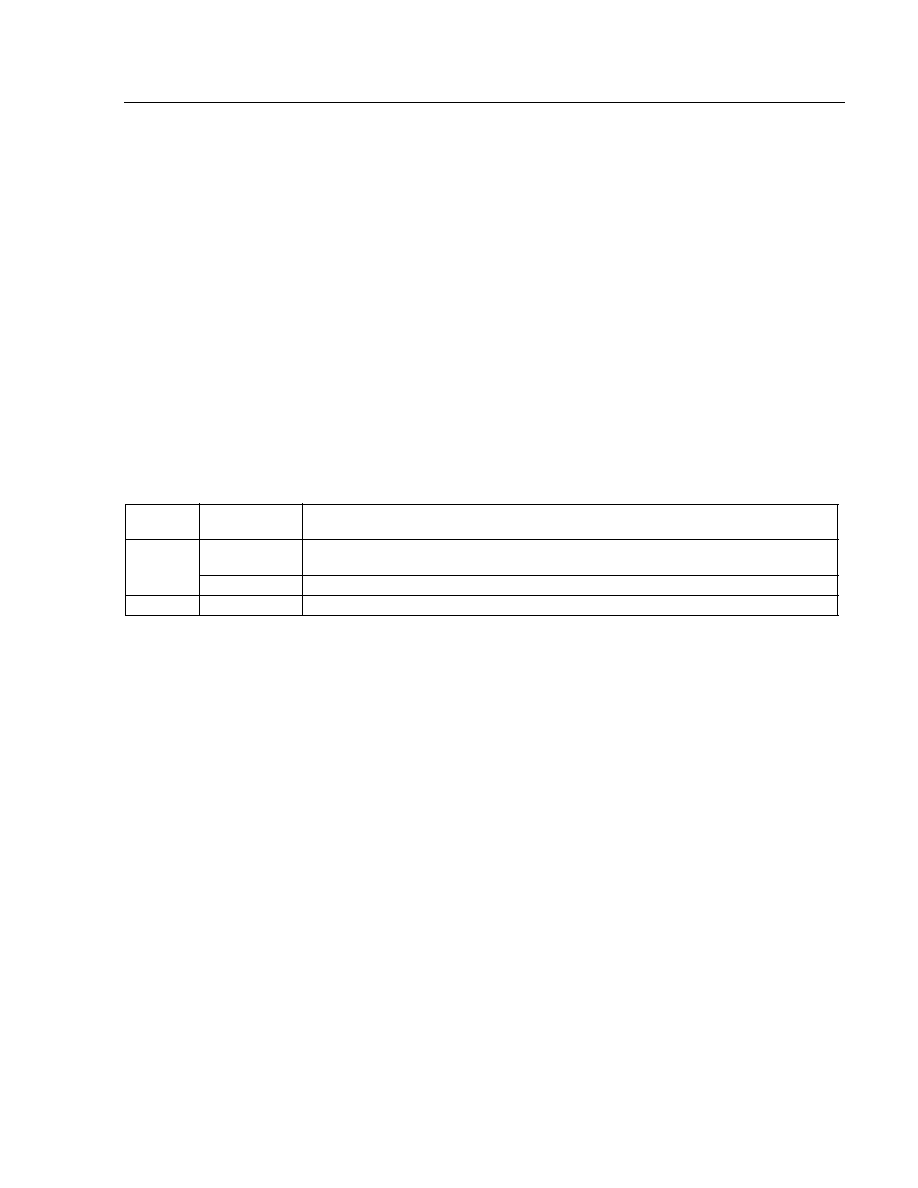
Preliminary Data Sheet
February 1997
DSP1628 Digital Signal Processor
Lucent Technologies Inc.
53
5 Software Architecture
(continued)
Cache Instructions
Cache instructions require one word of program memory. The do instruction executes in one instruction cycle, and
the redo instruction executes in two instruction cycles. (If PC points to external memory, add programmed wait-
states.) Control instructions and long immediate values cannot be stored inside the cache. The instruction formats
are as follows:
do K {
instr1
instr2
.
.
.
instrN
}
redo K
The assembly-language statement, do cloop (or redo cloop), is used to specify that the number of iterations is to be taken from the cloop
register. K is encoded as 0 in the instruction encoding to select cloop.
When the cache is used to execute a block of instructions, the cycle timings of the instructions are as follows:
1. In the first pass, the instructions are fetched from program memory and the cycle times are the normal out-of-
cache values, except for the last instruction in the block of N instructions. This instruction executes in two cycles.
2. During pass two through pass K ≠ 1, each instruction is fetched from cache and the in-cache timings apply.
3. During the last (Kth) pass, the block of instructions is fetched from cache and the in-cache timings apply, except
that the timing of the last instruction is the same as if it were out-of-cache.
4. If any of the instructions access external memory, programmed wait-states must be added to the cycle counts.
The redo instruction treats the instructions currently in the cache memory as another loop to be executed K times.
Using the redo instruction, instructions are reexecuted from the cache without reloading the cache.
The number of iterations, K, for a do or redo can be set at run time by first moving the number of iterations into the
cloop register (7 bits unsigned), and then issuing the do cloop or redo cloop. At the completion of the loop, the
value of cloop is decremented to 0; hence, cloop needs to be written before each do cloop or redo cloop.
Table 24. Replacement Table for Cache Instructions
Replace
Instruction
Encoding
Meaning
K
cloop
Number of times the instructions are to be executed taken from bits 0--6 of the cloop
register.
1 to 127
Number of times the instructions to be executed is encoded in the instruction.
N
1 to 15
1 to 15 instructions can be included.

Preliminary Data Sheet
DSP1628 Digital Signal Processor
February 1997
54
Lucent Technologies Inc.
5 Software Architecture
(continued)
Data Move Instructions
Data move instructions normally execute in two instruction cycles. (If PC or rM point to external memory, any pro-
grammed wait-states must be added. In addition, if PC and rM point to the same bank of DPRAM, then one cycle
must be added.) Immediate data move instructions require two words of program memory; all other data move in-
structions require only one word. The only exception to these statements is a special case immediate load (short
immediate) instruction. If a YAAU register is loaded with a 9-bit short immediate value, the instruction requires only
one word of memory and executes in one instruction cycle. All data move instructions, except those doing long im-
mediate loads, can be executed from within the cache. The data move instructions are as follows:
R = IM16
aT[l] = R
SR = IM9
Y = R
R = Y
Z : R
R = aS[l]
DR = *(OFFSET)
*(OFFSET) = DR
Notes:
sioc, sioc2, tdms, tdms2, srta, and srta2 registers are not readable.
When signed registers less than 16 bits wide (c0, c1, c2) are read, their contents are sign-extended to 16 bits. When unsigned registers less
than 16 bits wide are read, their contents are zero-extended to 16 bits.
Loading an accumulator with a data move instruction does not affect the flags.
Table 25. Replacement Table for Data Move Instructions
Replace
Value
Meaning
R
Any of the registers in Table 55
--
DR
r<0--3>, a0[l], a1[l], y[l], p, pl, x,
pt, pr, psw
Subset of registers accessible with direct addressing.
aS, aT
a0, a1
High half of accumulator.
Y
*rM, *rM++, *rM--, *rM++j
Same as in multiply/ALU instructions.
Z
*rMzp, *rMpz, *rMm2, *rMjk
Same as in multiply/ALU instructions.
IM16
16-bit value
Long immediate data.
IM9
9-bit value
Short immediate data for YAAU registers.
OFFSET
5-bit value from instruction
11-bit value in base register
Value in bits [15:5] of ybase register form the 11 most significant
bits of the base address. The 5-bit offset is concatenated to this
to form a 16-bit address.
SR
r<0--3>, rb, re, j, k
Subset of registers for short immediate.

Preliminary Data Sheet
February 1997
DSP1628 Digital Signal Processor
Lucent Technologies Inc.
55
5 Software Architecture
(continued)
5.2 Register Settings
Tables 26 through 42 describe the programmable registers of the DSP1628 device. Table 44 describes the register
settings after reset.
Note that the following abbreviations are used in the tables:
x = don't care
R = read only
W = read/write
The reserved (rsrvd) bits in the tables should always be written with zeros to make the program compatible with
future chip versions.
Table 26. Serial I/O Control Registers
See tdms register, SYNC field.
The bit definitions of the sioc2 register are identical to the sioc register bit definitions.
sioc
Bit
10
9
8
7
6
5
4
3
2
1
0
Field
DODLY
LD
CLK
MSB
OLD
ILD
OCK
ICK
OLEN
ILEN
Field
Value
Description
DODLY
0
1
DO changes on the rising edge of OCK.
DO changes on the falling edge of OCK. This delay in driving DO increases the hold
time on DO by half a cycle of OCK.
LD
0
1
In active mode, ILD1 and/or OLD1 = ICK1/16, active SYNC1 = ICK1/[128/256
].
In active mode, ILD1 and/or OLD1 = OCK1/16, active SYNC1 = OCK1/[128/256
].
CLK
00
01
10
11
Active clock = CKI/2 (1X).
Active clock = CKI/6 (1X).
Active clock = CKI/8 (1X).
Active clock = CKI/10 (1X).
MSB
0
1
LSB first.
MSB first.
OLD
0
1
OLD1 is an input (passive mode).
OLD1 is an output (active mode).
ILD
0
1
ILD1 is an input (passive mode).
ILD1 is an output (active mode).
OCK
0
1
OCK1 is an input (passive mode).
OCK1 is an output (active mode).
ICK
0
1
ICK1 is an input (passive mode).
ICK1 is an output (active mode).
OLEN
0
1
16-bit output.
8-bit output.
ILEN
0
1
16-bit input.
8-bit input.
sioc2
Bit
10
9
8
7
6
5
4
3
2
1
0
Field
DODLY2
LD2
CLK2
MSB2
OLD2
ILD2
OCK2
ICK2
OLEN2
ILEN2

Preliminary Data Sheet
DSP1628 Digital Signal Processor
February 1997
56
Lucent Technologies Inc.
5 Software Architecture
(continued)
Table 27. Time-Division Multiplex Slot Registers
See sioc register, LD field.
Select this mode when in multiprocessor mode.
ß The tdms2 register bit definitions are identical to the tdms register bit definitions.
tdms
Bit
9
8
7
6
5
4
3
2
1
0
Field
SYNCSP
MODE
TRANSMIT SLOT
SYNC
Field
Value
Description
SYNCSP
0
1
SYNC1 = ICK1/128 if LD = 0
.
SYNC1 = OCK1/128 if LD = 1
.
SYNC1 = ICK1/256 if LD = 0
.
SYNC1 = OCK1/256 if LD = 1
.
MODE
0
Multiprocessor mode off; DOEN1 is an input (passive
mode).
1
Multiprocessor mode on; DOEN1 is an output (active
mode).
TRANSMIT SLOT
1xxxxxx
Transmit slot 7.
x1xxxxx
Transmit slot 6.
xx1xxxx
Transmit slot 5.
xxx1xxx
Transmit slot 4.
xxxx1xx
Transmit slot 3.
xxxxx1x
Transmit slot 2.
xxxxxx1
Transmit slot 1.
SYNC
1
Transmit slot 0, SYNC1 is an output (active mode).
0
SYNC1 is an input (passive mode).
tdms2
ß
Bit
9
8
7
6
5
4
3
2
1
0
Field
SYNCSP2
MODE2
TRANSMIT SLOT2
SYNC2

Preliminary Data Sheet
February 1997
DSP1628 Digital Signal Processor
Lucent Technologies Inc.
57
5 Software Architecture
(continued)
Table 28. Serial Receive/Transmit Address Registers
The srta2 field definitions are identical to the srta register field definitions.
Table 29. Multiprocessor Protocol Registers
The saddx2 field definitions are identical to the saddx register field definitions.
srta
Bit
15
14
13
12
11
10
9
8
7
6
5
4
3
2
1
0
Field
RECEIVE ADDRESS
TRANSMIT ADDRESS
Field
Value
Description
RECEIVE ADDRESS
1xxxxxxx
Receive address 7.
x1xxxxxx
Receive address 6.
xx1xxxxx
Receive address 5.
xxx1xxxx
Receive address 4.
xxxx1xxx
Receive address 3.
xxxxx1xx
Receive address 2.
xxxxxx1x
Receive address 1.
xxxxxxx1
Receive address 0.
TRANSMIT ADDRESS
1xxxxxxx
Transmit address 7.
x1xxxxxx
Transmit address 6.
xx1xxxxx
Transmit address 5.
xxx1xxxx
Transmit address 4.
xxxx1xxx
Transmit address 3.
xxxxx1xx
Transmit address 2.
xxxxxx1x
Transmit address 1.
xxxxxxx1
Transmit address 0.
srta2
Bit
15
14
13
12
11
10
9
8
7
6
5
4
3
2
1
0
Field
RECEIVE ADDRESS2
TRANSMIT ADDRESS2
saddx
Bit Field
15--8
7--0
Write
X
Write Protocol Field [7:0]
Read
Read Protocol Field [7:0]
0
saddx2
Bit Field
15--8
7--0
Write
X
Write Protocol2 Field [7:0]
Read
Read Protocol2 Field [7:0]
0

Preliminary Data Sheet
DSP1628 Digital Signal Processor
February 1997
58
Lucent Technologies Inc.
5 Software Architecture
(continued)
* The DAU flags can be set by either BMU or DAU operations.
The auc is 9 bits [8:0]. The upper 7 bits [15:9] are always zero when read and should always be written with zeros to make the program
compatible with future chip versions. The auc register is cleared at reset.
Table 30. Processor Status Word (psw) Register
Bit
15
14
13
12
11
10
9
8
7
6
5
4
3
2
1
0
Field
DAU FLAGS
X
X
a1[V]
a1[35:32]
a0[V]
a0[35:32]
Field
Value
Description
DAU FLAGS*
Wxxx
LMI--logical minus when set (bit 35 = 1).
xWxx
LEQ--logical equal when set (bit [35:0] = 0).
xxWx
LLV--logical overflow when set.
xxxW
LMV--mathematical overflow when set.
a1[V]
W
Accumulator 1 (a1) overflow when set.
a1[35:32]
Wxxx
Accumulator 1 (a1) bit 35.
xWxx
Accumulator 1 (a1) bit 34.
xxWx
Accumulator 1 (a1) bit 33.
xxxW
Accumulator 1 (a1) bit 32.
a0[V]
W
Accumulator 0 (a0) overflow when set.
a0[35:32]
Wxxx
Accumulator 0 (a0) bit 35.
xWxx
Accumulator 0 (a0) bit 34.
xxWx
Accumulator 0 (a0) bit 33.
xxxW
Accumulator 0 (a0) bit 32.
Table 31. Arithmetic Unit Control (auc) Register
Bit
8
7
6
5
4
3
2
1
0
Field
RAND
X=Y=
CLR
SAT
ALIGN
Field
Value
Description
RAND
0
1
Pseudorandom sequence generator (PSG) reset by writing the
pi register only outside an interrupt service routine.
PSG never reset by writing the pi register.
X=Y=
0
1
Normal operation.
All instructions which load the high half of the y register also
load the x register, allowing single-cycle squaring with p = x * y.
CLR
1xx
Clearing yl is disabled (enabled when 0).
x1x
Clearing a1l is disabled (enabled when 0).
xx1
Clearing a0l is disabled (enabled when 0).
SAT
1x
a1 saturation on overflow is disabled (enabled when 0).
x1
a0 saturation on overflow is disabled (enabled when 0).
ALIGN
00
a0, a1
p.
01
a0, a1
p/4.
10
a0, a1
p x 4 (and zeros written to the two LSBs).
11
a0, a1
p x 2 (and zero written to the LSB).

Preliminary Data Sheet
February 1997
DSP1628 Digital Signal Processor
Lucent Technologies Inc.
59
5 Software Architecture
(continued)
* JINT is a JTAG interrupt and is controlled by the HDS. It may be made unmaskable by the Lucent Technologies development system tools.
Encoding: A 0 disables an interrupt; a 1 enables an interrupt.
Encoding: A 0 indicates no interrupt. A 1 indicates an interrupt has been recognized and is pending or being ser-
viced. If a 1 is written to bits 4, 5, 8, 12, or 13 of ins, the corresponding interrupt is cleared.
Table 32. Parallel Host Interface Control (phifc) Register
Bit
15--7
6
5
4
3
2
1
0
Field
Reserved
PSOBEF
PFLAGSEL
PFLAG
PBSELF
PSTRB
PSTROBE
PMODE
Field
Value
Description
PMODE
0
1
8-bit data transfers.
16-bit data transfers.
PSTROBE
0
1
Intel protocol: PIDS and PODS data strobes.
Motorola protocol: PRWN and PDS data strobes.
PSTRB
0
1
When PSTROBE = 1, PODS pin (PDS) active-low.
When PSTROBE = 1, PODS pin (PDS) active-high.
PBSELF
0
1
In either mode, PBSEL pin = 0 -> pdx0 low byte. See Table 7.
If PMODE = 0, PBSEL pin = 1 -> pdx0 low byte.
If PMODE = 1, PBSEL pin = 0 -> pdx0 high byte.
PFLAG
0
1
PIBF and POBE pins active-high.
PIBF and POBE pins active-low.
PFLAGSEL
0
1
Normal.
PIBF flag ORed with POBE flag and output on PIBF pin; POBE pin un-
changed (output buffer empty).
PSOBEF
0
1
Normal.
POBE flag as read through PSTAT register is active-low.
Table 33. Interrupt Control (inc) Register
Bit
15
14
13
12
11
10
9
8
7--6
5--4
3
2
1
0
Field
JINT*
rsrvd
EREADY
EOVF
rsrvd
OBE2
IBF2
TIME
rsrvd
INT[1:0]
PIBF
POBE
OBE
IBF
Table 34. Interrupt Status (ins) Register
Bit
15
14
13
12
11
10
9
8
7--6
5--4
3
2
1
0
Field
JINT
rsrvd
EREADY
EOVF
rsrvd
OBE2
IBF2
TIME
rsrvd
INT[1:0]
PIBF
POBE
OBE
IBF
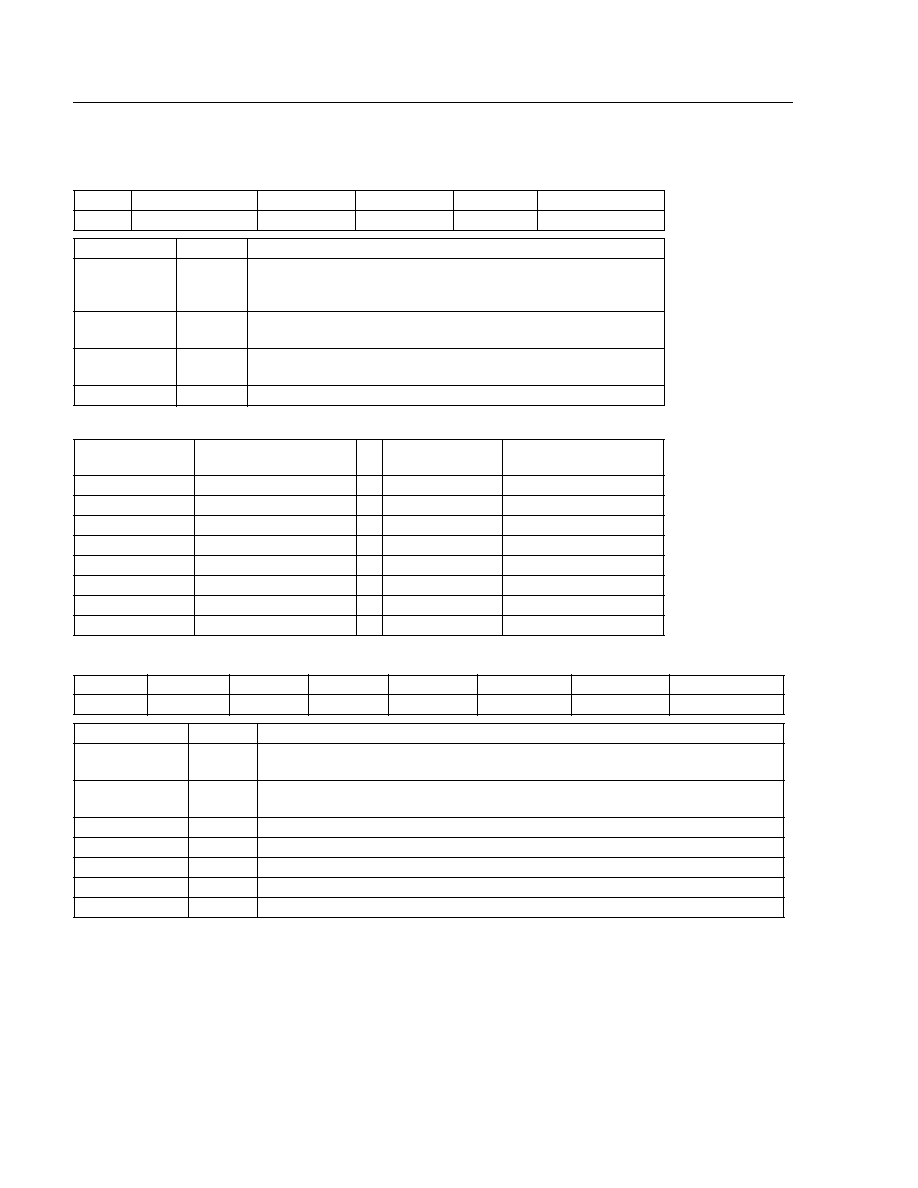
Preliminary Data Sheet
DSP1628 Digital Signal Processor
February 1997
60
Lucent Technologies Inc.
5 Software Architecture
(continued)
Table 35. timerc Register
Bit
15--7
6
5
4
3--0
Field
Reserved
DISABLE
RELOAD
T0EN
PRESCALE
Field
Value
Description
DISABLE
0
1
Timer enabled.
Timer and prescaler disabled. The period register and timer0 are
not reset.
RELOAD
0
1
Timer stops after counting down to 0.
Timer automatically reloads and repeats indefinitely.
T0EN
0
1
Timer holds current count.
Timer counts down to 0.
PRESCALE
--
See table below.
PRESCALE Field
PRESCALE
Frequency of
Timer Interrupts
PRESCALE
Frequency of
Timer Interrupts
0000
CKO/2
1000
CKO/512
0001
CKO/4
1001
CKO/1024
0010
CKO/8
1010
CKO/2048
0011
CKO/16
1011
CKO/4096
0100
CKO/32
1100
CKO/8192
0101
CKO/64
1101
CKO/16384
0110
CKO/128
1110
CKO/32768
0111
CKO/256
1111
CKO/65536
Table 36. Phase-Locked Loop Control (pllc) Register
Bit
15
14
13
12
11--8
7--5
4--0
Field
PLLEN
PLLSEL
ICP
Reserved
LF[3:0]
Nbits[2:0]
Mbits[4:0]
Field
Value
Description
PLLEN
0
1
PLL powered down.
PLL powered up.
PLLSEL
0
1
DSP internal clock taken directly from CKI.
DSP internal clock taken from PLL.
ICP
--
Charge pump current selection (see Table 64 for proper value).
Reserved
0
--
LF[3:0]
--
Loop filter setting (see Table 64 for proper value).
Nbits[2:0]
--
Encodes N, 1
N
8, where N = Nbits[2:0] + 2, unless Nbits[2:0] = 111, then N = 1.
Mbits[4:0]
--
Encodes M, 2
M
20, where M = Mbits[4:0] + 2, f
INTERNAL CLOCK
= f
CKI
x (M/(2N)).
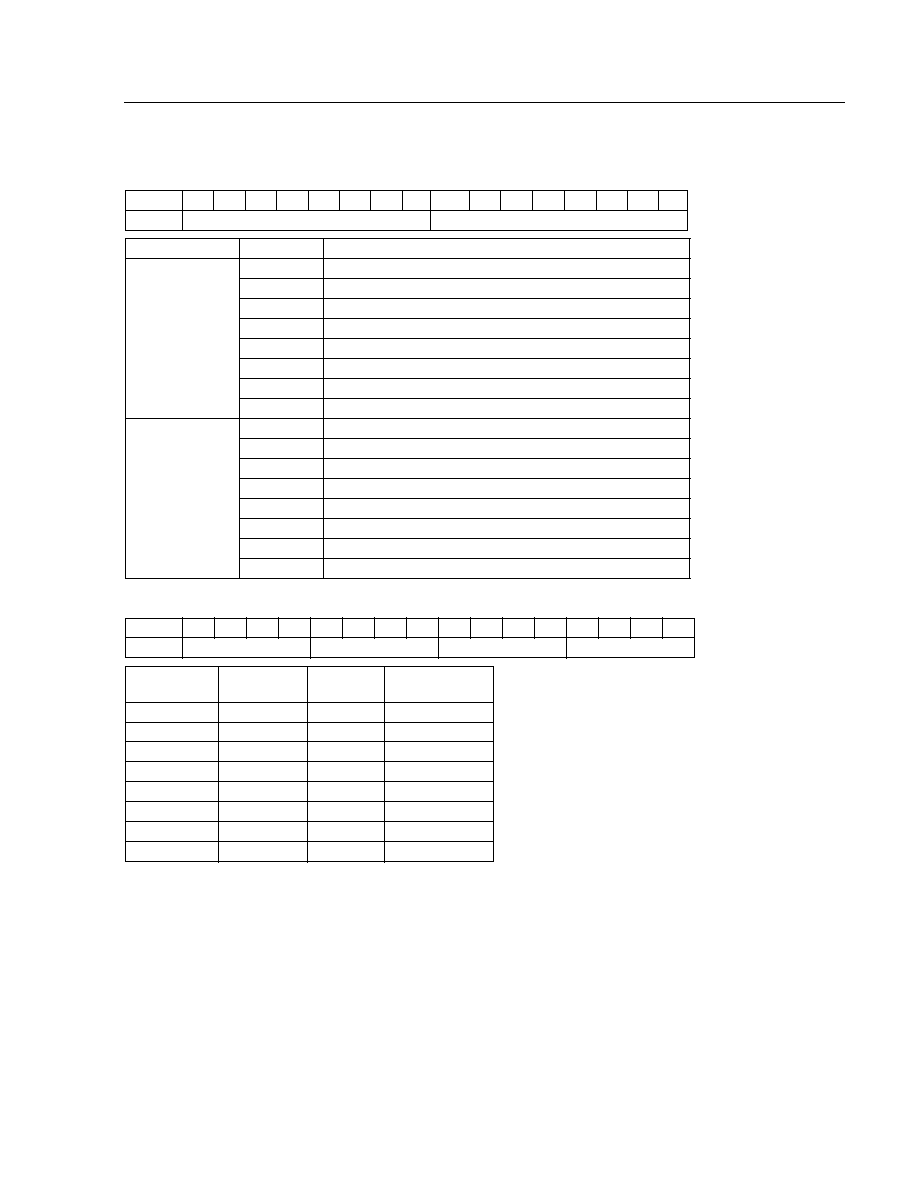
Preliminary Data Sheet
February 1997
DSP1628 Digital Signal Processor
Lucent Technologies Inc.
61
5 Software Architecture
(continued)
* 0
n
7.
Table 37. sbit Register
Bit
15
14
13
12
11
10
9
8
7
6
5
4
3
2
1
0
Field
DIREC[7:0]
VALUE[7:0]
Field
Value
Description
DIREC
1xxxxxxx
IOBIT7 is an output (input when 0).
x1xxxxxx
IOBIT6 is an output (input when 0).
xx1xxxxx
IOBIT5 is an output (input when 0).
xxx1xxxx
IOBIT4 is an output (input when 0).
xxxx1xxx
IOBIT3 is an output (input when 0).
xxxxx1xx
IOBIT2 is an output (input when 0).
xxxxxx1x
IOBIT1 is an output (input when 0).
xxxxxxx1
IOBIT0 is an output (input when 0).
VALUE
Rxxxxxxx
Reads the current value of IOBIT7.
xRxxxxxx
Reads the current value of IOBIT6.
xxRxxxxx
Reads the current value of IOBIT5.
xxxRxxxx
Reads the current value of IOBIT4.
xxxxRxxx
Reads the current value of IOBIT3.
xxxxxRxx
Reads the current value of IOBIT2.
xxxxxxRx
Reads the current value of IOBIT1.
xxxxxxxR
Reads the current value of IOBIT0.
Table 38. cbit Register
Bit
15
14
13
12
11
10
9
8
7
6
5
4
3
2
1
0
Field
MODE/MASK[7:4]
MODE/MASK[3:0]
DATA/PAT[7:4]
DATA/PAT[3:0]
DIREC[n]*
MODE/
MASK[n]
DATA/
PAT[n]
Action
1 (Output)
0
0
Clear
1 (Output)
0
1
Set
1 (Output)
1
0
No Change
1 (Output)
1
1
Toggle
0 (Input)
0
0
No Test
0 (Input)
0
1
No Test
0 (Input)
1
0
Test for Zero
0 (Input)
1
1
Test for One
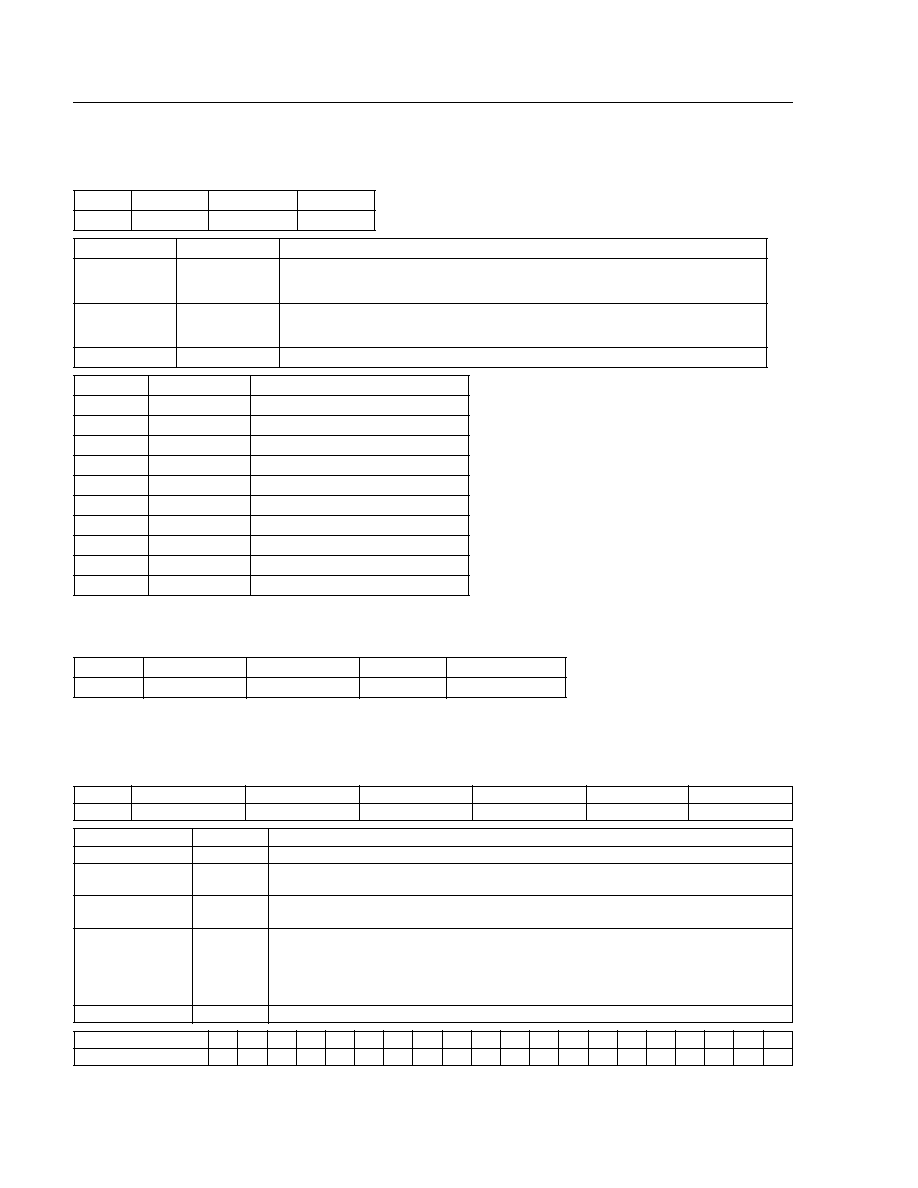
Preliminary Data Sheet
DSP1628 Digital Signal Processor
February 1997
62
Lucent Technologies Inc.
5 Software Architecture
(continued)
If the EXM pin is high and the INT1 is low upon reset, the mwait register is initialized to all 1s (15 wait-states for all
external memory). Otherwise, the mwait register is initialized to all 0s (0 wait-states) upon reset.
* The ebusy flag cannot be written by the user.
Table 39. alf Register
Bit
15
14
13--0
Field
AWAIT
LOWPR
FLAGS
Field
Value
Action
AWAIT
1
0
Power-saving standby mode or standard sleep enabled.
Normal operation.
LOWPR
1
0
The internal DPRAM is addressed beginning at 0x0000 in X space.
The internal DPRAM is addressed beginning at 0xc000 in X space.
FLAGS
--
See table below.
Bit
Flag
Use
13--9
Reserved
--
8
ebusy*
ECCP BUSY
7
nmns1
NOT-MINUS-ONE from BMU
6
mns1
MINUS-ONE from BMU
5
evenp
EVEN PARITY from BMU
4
oddp
ODD PARITY from BMU
3
somef
SOME FALSE from BIO
2
somet
SOME TRUE from BIO
1
allf
ALL FALSE from BIO
0
allt
ALL TRUE from BIO
Table 40. mwait Register
Bit
15--12
11--8
7--4
3--0
Field
EROM[3:0]
ERAMHI[3:0]
IO[3:0]
ERAMLO[3:0]
Table 41. DSP1628 32-Bit JTAG ID Register
Bit
31
30
29--28
27--19
18--12
11--0
Field
RESERVED
SECURE
CLOCK
ROMCODE
PART ID
0x03B
Field
Value
Mask-Programmable Features
RESERVED
0
--
SECURE
0
1
Nonsecure ROM option.
Secure ROM option.
CLOCK
01
11
Small-signal input clock option.
CMOS level input clock option.
ROMCODE
--
Users ROMCODE ID:
The ROMCODE ID is the 9-bit binary value of the following expression:
(20 x value for first letter) + (value of second letter), where the values of the letters
are in the following table. For example, ROMCODE GK is (20 x 6) + (9) = 129
or 0 1000 0001.
PART ID
0x2A
DSP1628
ROMCODE Letter
A
B
C
D
E
F
G
H
J
K
L
M
N
P
R
S
T
U
W
Y
Value
0
1
2
3
4
5
6
7
8
9
10
11
12
13
14
15
16
17
18
19
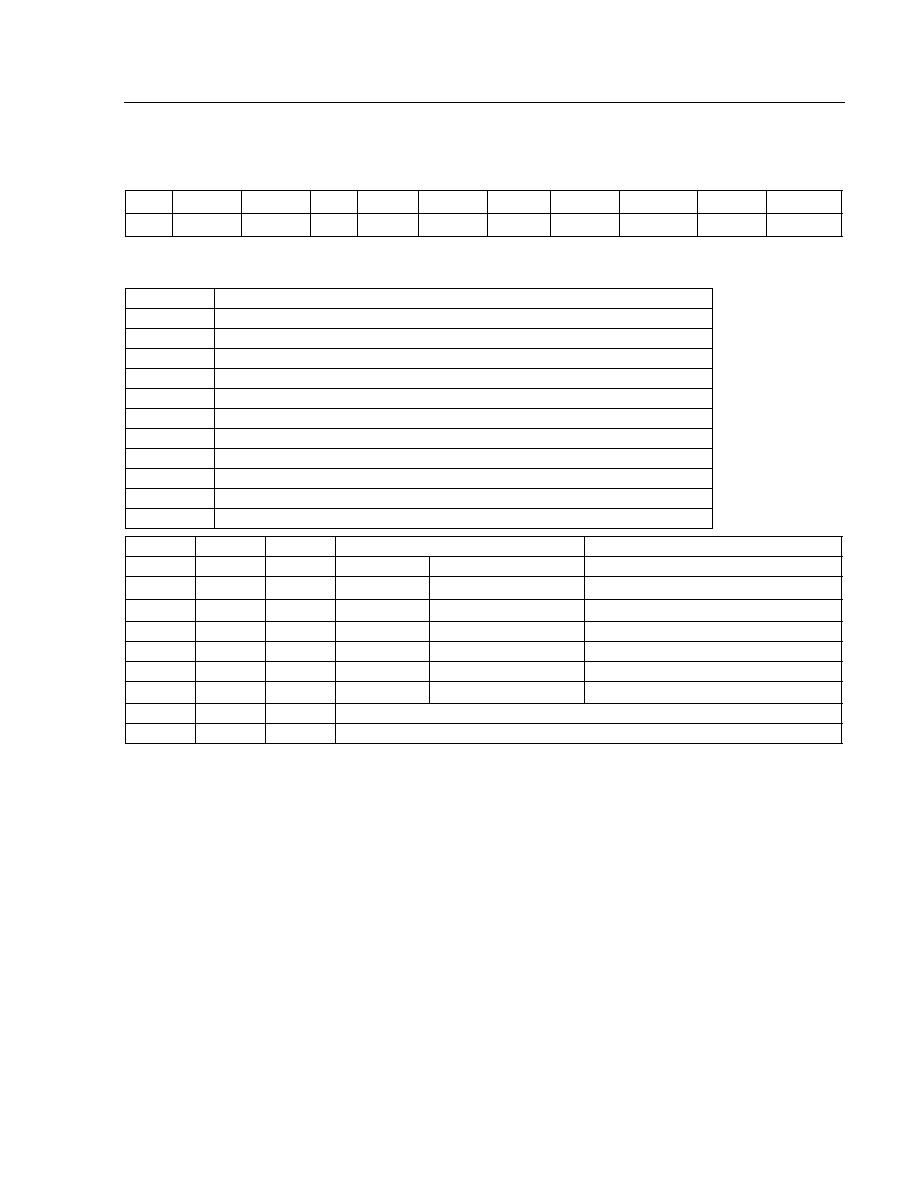
Preliminary Data Sheet
February 1997
DSP1628 Digital Signal Processor
Lucent Technologies Inc.
63
5 Software Architecture
(continued)
* The field definitions for the ioc register are different from the DSP1610.
1. The phase of CKI is synchronized by the rising edge of RSTB.
2. When SLOWCKI is enabled in the powerc register, these options reflect the low-speed internal ring oscillator.
3. The wait-stated clock reflects the internal instruction cycle and may be stretched based on the mwait register setting (see Table 40).
During sequenced external memory accesses, it completes one cycle.
4. The sequenced wait-stated clock completes two cycles during a sequenced external memory access and may be stretched based
on the mwait register setting (see Table 40).
Table 42. ioc Register*
Bit
15
14
13
12
11
10
9
8--7
6--4
3--0
Field Reserved EXTROM CKO2
EBIOH
WEROM
ESIO2
SIOLBC
CKO[1:0]
Reserved DENB[3:0]
ioc Fields
ioc Field
Description
EXTROM
If 1, sets AB15 low during external memory accesses when WEROM = 1.
CKO2
CKO configuration (see below).
EBIOH
If 1, enables high half of BIO, IOBIT[4:7], and disables VEC[3:0] from pins.
WEROM
If 1, allows writing into external program (X) memory.
ESIO2
If 1, enables SIO2 and low half of BIO, and disables PHIF from pins.
SIOLBC
If 1, DO1 and DO2 looped back to DI1 and DI2.
CKO[1:0]
CKO configuration (see below).
DENB3
If 1, delay EROM.
DENB2
If 1, delay ERAMHI.
DENB1
If 1, delay IO.
DENB0
If 1, delay ERAMLO.
CKO2
CKO1
CKO0
CKO Output
Description
--
--
--
1X
PLL
--
0
0
0
CKI
CKI x M/(2N)
Free-running clock.
1, 2
0
0
1
CKI/(1 + W)
CKI x (M/(2N)) / [1 + W] Wait-stated clock.
1--3
0
1
0
1
1
Held high.
0
1
1
0
0
Held low.
1
0
0
CKI
CKI
Output of CKI buffer.
1
0
1
CKI/(1 + W)
CKI x (M/(2N)) / [1 + W] Sequenced, wait-stated clock.
1--4
1
1
0
Reserved
1
1
1
Reserved

Preliminary Data Sheet
DSP1628 Digital Signal Processor
February 1997
64
Lucent Technologies Inc.
5 Software Architecture
(continued)
Table 43. powerc Register
Note: The reserved (rsrvd) bits should always be written with zeros to make the program compatible with future chip versions.
The powerc register configures various power management modes.
Bit
15
14
13
12
11
10
9--8
7
6
5
4
3--1
0
Field
XTLOFF
SLOWCKI
NOCK
INT0EN
rsrvd
INT1EN
rsrvd SIO1DIS
SIO2DIS PHIFDIS TIMERDIS rsrvd
ECCPDIS
powerc fields
Field
Description
XTLOFF
1 = power down small-signal clock input.
SLOWCKI
1 = select ring oscillator clock (internal slow clock).
NOCK
1 = disable internal processor clock.
INT0EN
1 = INT0 clears NOCK field.
INT1EN
1 = INT1 clears NOCK field.
SIO1DIS
1 = disable SIO1.
SIO2DIS
1 = disable SIO2.
PHIFDIS
1 = disable PHIF.
TIMERDIS
1 = disable timer.
ECCPDIS
1 = disable ECCP.

Preliminary Data Sheet
February 1997
DSP1628 Digital Signal Processor
Lucent Technologies Inc.
65
5 Software Architecture
(continued)
Table 44. Register Settings After Reset
A
∑
indicates that this bit is unknown on powerup reset and unaffected on subsequent reset. An S indicates that this
bit shadows the PC. P indicates the value on an input pin, i.e., the bit in the register reflects the value on the corre-
sponding input pin.
If EXM is high and INT1 is low when RSTB goes high, mwait will contain all ones instead of all zeros.
Register
Bits 15--0
Register
Bits 15--0
r0
∑∑∑∑∑∑∑∑∑∑∑∑∑∑∑∑
inc
0000000000000000
r1
∑∑∑∑∑∑∑∑∑∑∑∑∑∑∑∑
ins
0000010000000110
r2
∑∑∑∑∑∑∑∑∑∑∑∑∑∑∑∑
sdx2
∑∑∑∑∑∑∑∑∑∑∑∑∑∑∑∑
r3
∑∑∑∑∑∑∑∑∑∑∑∑∑∑∑∑
saddx
∑∑∑∑∑∑∑∑∑∑∑∑∑∑∑∑
j
∑∑∑∑∑∑∑∑∑∑∑∑∑∑∑∑
cloop
000000000∑∑∑∑∑∑∑
k
∑∑∑∑∑∑∑∑∑∑∑∑∑∑∑∑
mwait
0000000000000000
rb
0000000000000000
saddx2
∑∑∑∑∑∑∑∑∑∑∑∑∑∑∑∑
re
0000000000000000
sioc2
∑∑∑∑∑∑0000000000
pt
∑∑∑∑∑∑∑∑∑∑∑∑∑∑∑∑
cbit
∑∑∑∑∑∑∑∑∑∑∑∑∑∑∑∑
pr
∑∑∑∑∑∑∑∑∑∑∑∑∑∑∑∑
sbit
00000000PPPPPPPP
pi
SSSSSSSSSSSSSSSS
ioc
0000000000000000
i
∑∑∑∑∑∑∑∑∑∑∑∑∑∑∑∑
jtag
∑∑∑∑∑∑∑∑∑∑∑∑∑∑∑∑
p
∑∑∑∑∑∑∑∑∑∑∑∑∑∑∑∑
eir
0000000000001111
pl
∑∑∑∑∑∑∑∑∑∑∑∑∑∑∑∑
a0
∑∑∑∑∑∑∑∑∑∑∑∑∑∑∑∑
pllc
0000000000000000
x
∑∑∑∑∑∑∑∑∑∑∑∑∑∑∑∑
a0l
∑∑∑∑∑∑∑∑∑∑∑∑∑∑∑∑
y
∑∑∑∑∑∑∑∑∑∑∑∑∑∑∑∑
a1
∑∑∑∑∑∑∑∑∑∑∑∑∑∑∑∑
yl
∑∑∑∑∑∑∑∑∑∑∑∑∑∑∑∑
a1l
∑∑∑∑∑∑∑∑∑∑∑∑∑∑∑∑
auc
0000000000000000
timerc
∑∑∑∑∑∑∑∑00000000
psw
∑∑∑∑00∑∑∑∑∑∑∑∑∑∑
timer0
0000000000000000
c0
∑∑∑∑∑∑∑∑∑∑∑∑∑∑∑∑
tdms2
∑∑∑∑∑∑0000000000
c1
∑∑∑∑∑∑∑∑∑∑∑∑∑∑∑
srta2
∑∑∑∑∑∑∑∑∑∑∑∑∑∑∑∑
c2
∑∑∑∑∑∑∑∑∑∑∑∑∑∑∑∑
powerc
0000000000000000
sioc
∑∑∑∑∑∑0000000000
edr
∑∑∑∑∑∑∑∑∑∑∑∑∑∑∑
srta
∑∑∑∑∑∑∑∑∑∑∑∑∑∑∑∑
ar0
∑∑∑∑∑∑∑∑∑∑∑∑∑∑∑∑
sdx
∑∑∑∑∑∑∑∑∑∑∑∑∑∑∑∑
ar1
∑∑∑∑∑∑∑∑∑∑∑∑∑∑∑∑
tdms
∑∑∑∑∑∑0000000000
ar2
∑∑∑∑∑∑∑∑∑∑∑∑∑∑∑∑
phifc
0000000000000000
ar3
∑∑∑∑∑∑∑∑∑∑∑∑∑∑∑∑
pdx0
0000000000000000
ear
0000000000000000
ybase
∑∑∑∑∑∑∑∑∑∑∑∑∑∑∑∑
alf
00000000∑∑∑∑∑∑∑∑
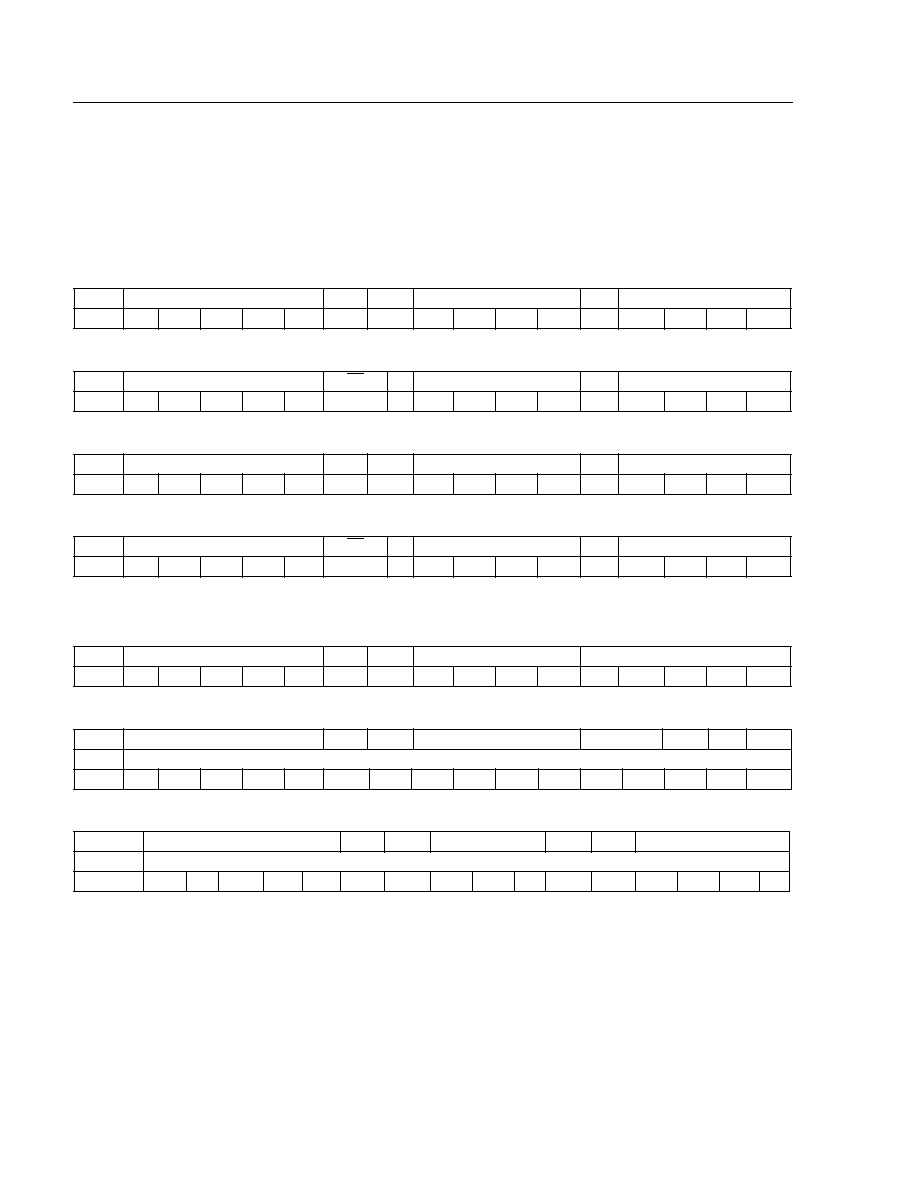
Preliminary Data Sheet
DSP1628 Digital Signal Processor
February 1997
66
Lucent Technologies Inc.
5 Software Architecture
(continued)
5.3 Instruction Set Formats
This section defines the hardware-level encoding of the DSP1628 device instructions.
Multiply/ALU Instructions
Special Function Instructions
Format 1: Multiply/ALU Read/Write Group
Field
T
D
S
F1
X
Y
Bit
15
14
13
12
11
10
9
8
7
6
5
4
3
2
1
0
Format 1a: Multiply/ALU Read/Write Group
Field
T
aT
S
F1
X
Y
Bit
15
14
13
12
11
10
9
8
7
6
5
4
3
2
1
0
Format 2: Multiply/ALU Read/Write Group
Field
T
D
S
F1
X
Y
Bit
15
14
13
12
11
10
9
8
7
6
5
4
3
2
1
0
Format 2a: Multiply/ALU Read/Write Group
Field
T
aT
S
F1
X
Y
Bit
15
14
13
12
11
10
9
8
7
6
5
4
3
2
1
0
Format 3: F2 ALU Special Functions
Field
T
D
S
F2
CON
Bit
15
14
13
12
11
10
9
8
7
6
5
4
3
2
1
0
Format 3a: F3 ALU Operations
Field
T
D
S
F3
SRC2
aT
0
1
Immediate Operand (IM16)
Bit
15
14
13
12
11
10
9
8
7
6
5
4
3
2
1
0
Format 3b: BMU Operations
Field
T
D
S
F4[3--1]
0
F4[0]
AR
Immediate Operand (IM16)
Bit
15
14
13
12
11
10
9
8
7
6
5
4
3
2
1
0

Preliminary Data Sheet
February 1997
DSP1628 Digital Signal Processor
Lucent Technologies Inc.
67
5 Software Architecture
(continued)
Control Instructions
Data Move Instructions
Cache Instructions
Format 4: Branch Direct Group
Field
T
JA
Bit
15
14
13
12
11
10
9
8
7
6
5
4
3
2
1
0
Format 5: Branch Indirect Group
Field
T
B
reserved
0
Bit
15
14
13
12
11
10
9
8
7
6
5
4
3
2
1
0
Format 6: Conditional Branch Qualifier/Software Interrupt (icall)
Note that a branch instruction immediately follows except for a software interrupt (icall).
Field
T
SI
reserved
CON
Bit
15
14
13
12
11
10
9
8
7
6
5
4
3
2
1
0
Format 7: Data Move Group
Field
T
aT
R
Y/Z
Bit
15
14
13
12
11
10
9
8
7
6
5
4
3
2
1
0
Format 8: Data Move (immediate operand -- 2 words)
Field
T
D
R
reserved
Immediate Operand (IM16)
Bit
15
14
13
12
11
10
9
8
7
6
5
4
3
2
1
0
Format 9: Short Immediate Group
Field
T
I
Short Immediate Operand (IM9)
Bit
15
14
13
12
11
10
9
8
7
6
5
4
3
2
1
0
Format 9a: Direct Addressing
Field
T
R/W
DR
1
OFFSET
Bit
15
14
13
12
11
10
9
8
7
6
5
4
3
2
1
0
Format 10: Do/Redo
Field
T
N
K
Bit
15
14
13
12
11
10
9
8
7
6
5
4
3
2
1
0

Preliminary Data Sheet
DSP1628 Digital Signal Processor
February 1997
68
Lucent Technologies Inc.
5 Software Architecture
(continued)
Field Descriptions
Table 45. T Field
Table 46. D Field
Table 47.
aT
Field
Table 48. S Field
Table 49. F1 Field
Table 50. X Field
Specifies the type of instruction.
T
Operation
Format
0000x
goto JA
4
00010
Short imm j, k, rb, re
9
00011
Short imm r0, r1, r2, r3
9
00100
Y = a1[l]
F1
1
00101
Z : aT[l]
F1
2a
00110
Y
F1
1
00111
aT[l] = Y
F1
1a
01000
Bit 0 = 0, aT = R
7
01000
Bit 0 = 1, aTl = R
7
01001
Bit 10 = 0, R = a0
7
01001
Bit 10 = 1, R = a0l
7
01010
R = IM16
8
01011
Bit 10 = 0, R = a1
7
01011
Bit 10 = 1, R = a1l
7
01100
Y = R
7
01101
Z : R
7
01110
do, redo
10
01111
R = Y
7
1000x
call JA
4
10010
ifc CON
F2
3
10011
if CON
F2
3
10100
Y = y[l]
F1
1
10101
Z : y[l]
F1
2
10110
x = Y
F1
1
10111
y[l] = Y
F1
1
11000
Bit 0 = 0, branch indirect
5
11000
Bit 0 = 1, F3 ALU
3a
11001
y = a0 x = X
F1
1
11010
Cond. branch qualifier
6
11011
y = a1 x = X
F1
1
11100
Y = a0[l]
F1
1
11101
Z : y x = X
F1
2
11110
Bit 5 = 0, F4 ALU (BMU)
3b
11110
Bit 5 = 1, direct addressing
9a
11111
y = Y x = X
F1
1
Specifies a destination accumulator.
D
Register
0
Accumulator 0
1
Accumulator 1
Specifies transfer accumulator.
aT
Register
0
Accumulator 1
1
Accumulator 0
Specifies a source accumulator.
S
Register
0
Accumulator 0
1
Accumulator 1
Specifies the multiply/ALU function.
F1
Operation
0000
aD = p
p = x * y
0001
aD = aS + p
p = x * y
0010
p = x *
y
0011
aD = aS ≠ p
p = x * y
0100
aD = p
0101
aD = aS + p
0110
nop
0111
aD = aS ≠ p
1000
aD = aS | y
1001
aD = aS ^ y
1010
aS & y
1011
aS ≠ y
1100
aD = y
1101
aD = aS + y
1110
aD = aS & y
1111
aD = aS ≠ y
Specifies the addressing of ROM data in two-operand
multiply/ALU instructions. Specifies the high or low half
of an accumulator or the y register in one-operand mul-
tiply/ALU instructions.
X
Operation
Two-Operand Multiply/ALU
0
*
pt++
1
*
pt++i
One-Operand Multiply/ALU
0
aTl, yl
1
aTh, yh

Preliminary Data Sheet
February 1997
DSP1628 Digital Signal Processor
Lucent Technologies Inc.
69
5 Software Architecture
(continued)
Table 51. Y Field
Table 52. Z Field
Table 53. F2 Field
Table 54. CON Field
Specifies the form of register indirect addressing with
postmodification.
Y
Operation
0000
*r0
0001
*r0++
0010
*r0--
0011
*r0++j
0100
*r1
0101
*r1++
0110
*r1--
0111
*r1++j
1000
*r2
1001
*r2++
1010
*r2--
1011
*r2++j
1100
*r3
1101
*r3++
1110
*r3--
1111
*r3++j
Specifies the form of register indirect compound ad-
dressing with postmodification.
Z
Operation
0000
*
r0zp
0001
*
r0pz
0010
*
r0m2
0011
*
r0jk
0100
*
r1zp
0101
*
r1pz
0110
*
r1m2
0111
*
r1jk
1000
*
r2zp
1001
*
r2pz
1010
*
r2m2
1011
*
r2jk
1100
*
r3zp
1101
*
r3pz
1110
*
r3m2
1111
*
r3jk
Specifies the special function to be performed.
F2
Operation
0000
aD = aS >> 1
0001
aD = aS << 1
0010
aD = aS >> 4
0011
aD = aS << 4
0100
aD = aS >> 8
0101
aD = aS << 8
0110
aD = aS >> 16
0111
aD = aS << 16
1000
aD = p
1001
aDh = aSh + 1
1010
aD = ~aS
1011
aD = rnd(aS)
1100
aD = y
1101
aD = aS + 1
1110
aD = aS
1111
aD = ≠ aS
Specifies the condition for special functions and condi-
tional control instructions.
CON
Condition
CON
Condition
00000
mi
01110
true
00001
pl
01111
false
00010
eq
10000
gt
00011
ne
10001
le
00100
lvs
10010
allt
00101
lvc
10011
allf
00110
mvs
10100
somet
00111
mvc
10101
somef
01000
heads
10110
oddp
01001
tails
10111
evenp
01010
c0ge
11000
mns1
01011
c0lt
11001
nmns1
01100
c1ge
11010
npint
01101
c1lt
11011
njint
11100
lock
11101
ebusy
Other
codes
Reserved
--
--
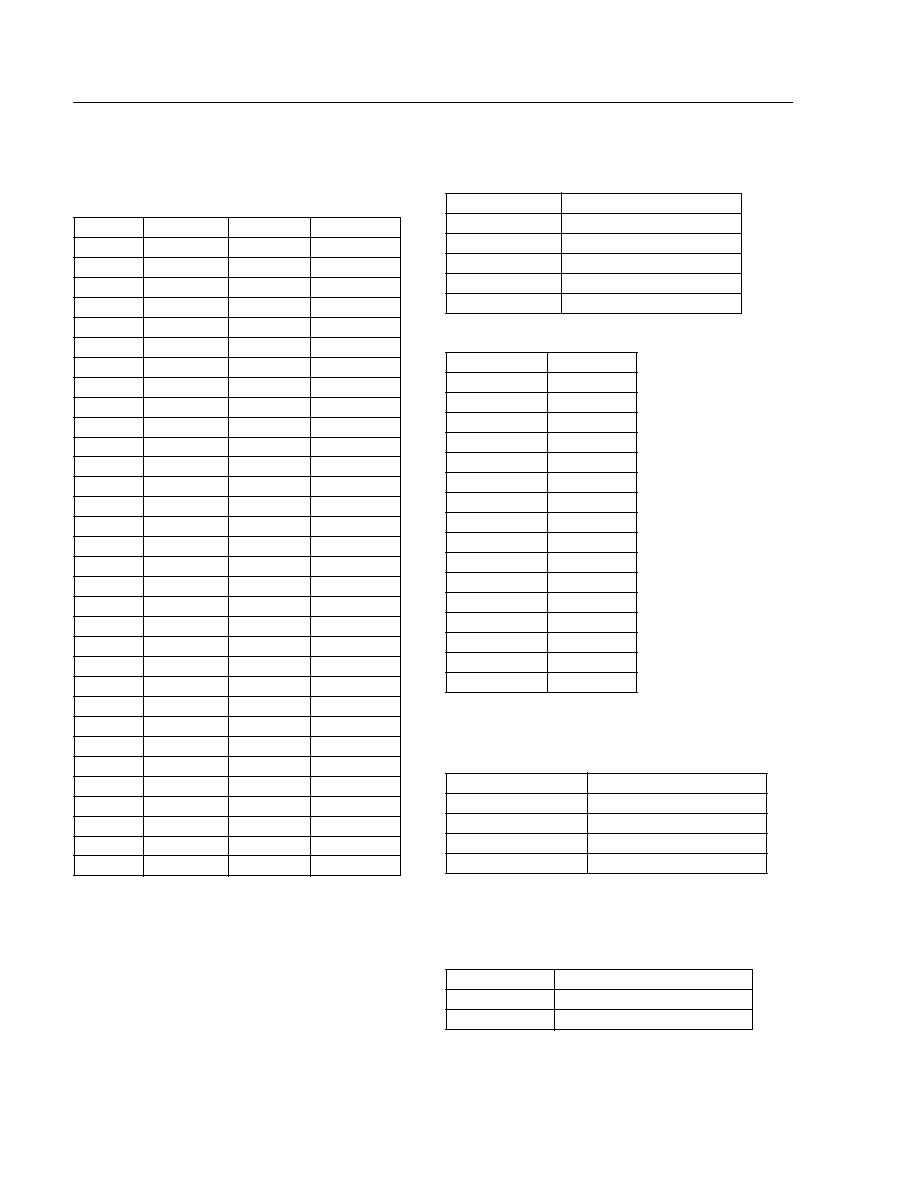
Preliminary Data Sheet
DSP1628 Digital Signal Processor
February 1997
70
Lucent Technologies Inc.
5 Software Architecture
(continued)
Table 55. R Field
Table 56. B Field
Table 58. I Field
Table 59. SI Field
Specifies the register for data move instructions.
R
Register
R
Register
000000
r0
100000
inc
000001
r1
100001
ins
000010
r2
100010
sdx2
000011
r3
100011
saddx
000100
j
100100
cloop
000101
k
100101
mwait
000110
rb
100110
saddx2
000111
re
100111
sioc2
001000
pt
101000
cbit
001001
pr
101001
sbit
001010
pi
101010
ioc
001011
i
101011
jtag
001100
p
101100
Reserved
001101
pl
101101
Reserved
001110
pllc
101110
Reserved
001111
Reserved
101111
eir
010000
x
110000
a0
010001
y
110001
a0l
010010
yl
110010
a1
010011
auc
110011
a1l
010100
psw
110100
timerc
010101
c0
110101
timer0
010110
c1
110110
tdms2
010111
c2
110111
srta2
011000
sioc
111000
powerc
011001
srta
111001
edr
011010
sdx
111010
ar0
011011
tdms
111011
ar1
011100
phifc
111100
ar2
011101
pdx0
111101
ar3
011110
Reserved
111110
ear
011111
ybase
111111
alf
Specifies the type of branch instruction (except software
interrupt).
B
Operation
000
return
001
ireturn
010
goto pt
011
call pt
1xx
Reserved
Table 57. DR Field
DR Value
Register
0000
r0
0001
r1
0010
r2
0011
r3
0100
a0
0101
a0l
0110
a1
0111
a1l
1000
y
1001
yl
1010
p
1011
pl
1100
x
1101
pt
1110
pr
1111
psw
Specifies a register for short immediate data move in-
structions.
I
Register
00
r0/j
01
r1/k
10
r2/rb
11
r3/re
Specifies when the conditional branch qualifier instruc-
tion should be interpreted as a software interrupt in-
struction.
SI
Operation
0
Not a software interrupt
1
Software interrupt
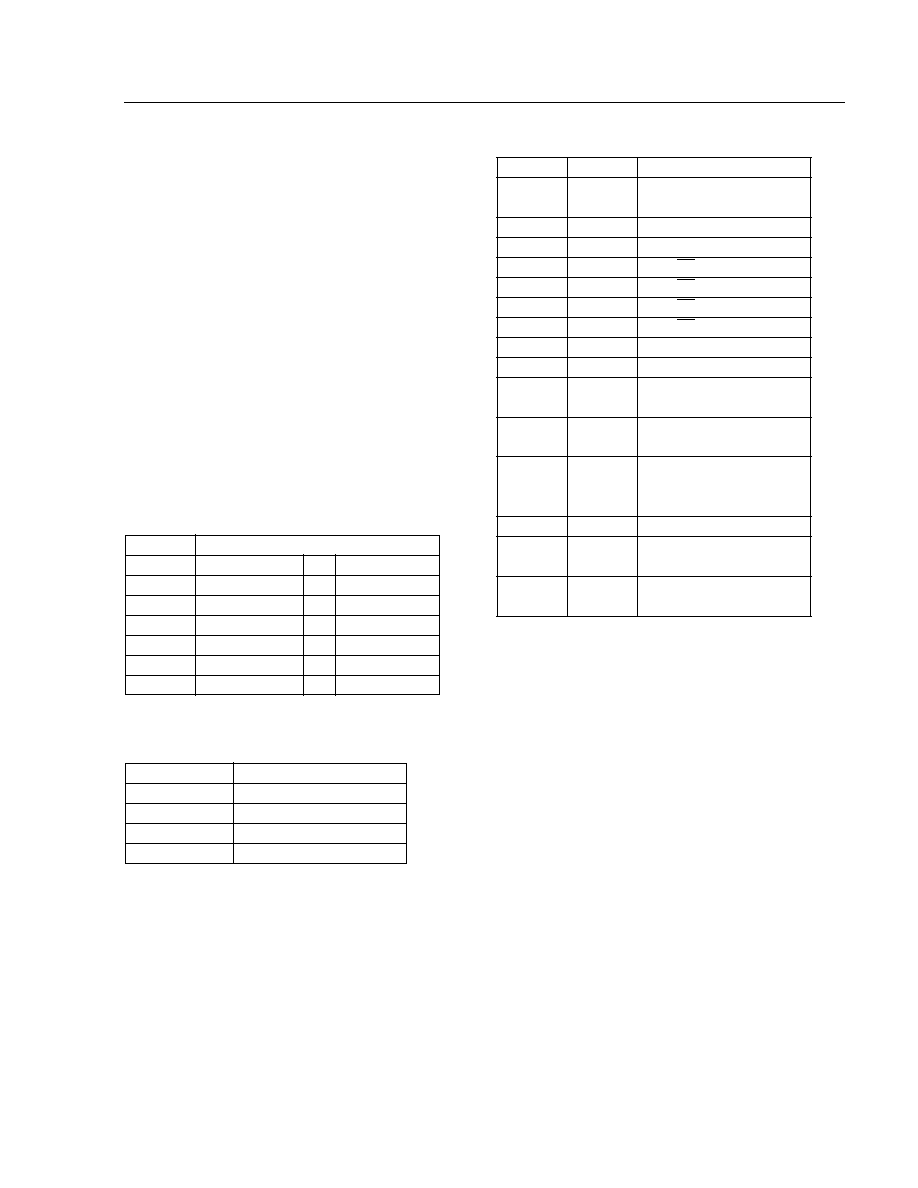
Preliminary Data Sheet
February 1997
DSP1628 Digital Signal Processor
Lucent Technologies Inc.
71
5 Software Architecture
(continued)
N Field
Number of instructions to be loaded into the cache. Zero
implies redo operation.
K Field
Number of times the N instructions in cache are to be
executed. Zero specifies use of value in cloop register.
JA Field
12-bit jump address.
R/W Field
A zero specifies a write, *(OFFSET) = DR.
A one specifies a read, DR = *(OFFSET).
Table 60. F3 Field
Table 61. SRC2 Field
Note: xx encodes the auxiliary register to be used; 00 (ar0),
01(ar1), 10 (ar2), or 11(ar3).
Specifies the operation in an F3 ALU instruction.
F3
Operation
1000
aD = aS[h, l]
|
{aT, IM16, p}
1001
aD = aS[h, l]
^
{aT, IM16, p}
1010
aS[h, l]
&
{aT, IM16, p}
1011
aS[h, l]
≠
{aT, IM16, p}
1101
aD = aS[h, l]
+
{aT, IM16, p}
1110
aD = aS[h, l]
&
{aT, IM16, p}
1111
aD = aS[h, l]
≠
{aT, IM16, p}
Specifies operands in an F3 ALU instruction.
SRC2
Operands
00
aSl, IM16
10
aSh, IM16
01
aS, aT
11
aS, p
Table 62. BMU Encodings
F4
AR
Operation
0000
00xx
aD = aS >> arM
0001
00xx
aD = aS << arM
0000
10xx
aD = aS >>> arM
0001
10xx
aD = aS <<< arM
1000
0000
aD = aS >> aS
1001
0000
aD = aS << aS
1000
1000
aD = aS >>> aS
1001
1000
aD = aS <<< aS
1100
0000
aD = aS >> IM16
1101
0000
aD = aS << IM16
1100
1000
aD = aS >>> IM16
1101
1000
aD = aS <<< IM16
0000
1100
aD = exp(aS)
0001
11xx
aD = norm(aS, arM)
1110
0000
aD = extracts(aS, IM16)
0010
00xx
aD = extracts(aS, arM)
1110
0100
aD = extractz(aS, IM16)
0010
01xx
aD = extractz(aS, arM)
1110
1000
aD = insert(aS, IM16)
1010
10xx
aD = insert(aS, arM)
0111
0000
aD = aS:aa0
0111
0001
aD = aS:aa1

Preliminary Data Sheet
DSP1628 Digital Signal Processor
February 1997
72
Lucent Technologies Inc.
6 Signal Descriptions
Figure 12. DSP1628 Pinout by Interface
EXTERNAL
MEMORY
INTERFACE
IO
ERAMHI
EROM
EXM
AB[15:0]
DB[15:0]
RWN
SYSTEM
INTERFACE
OR
CONTROL I/O
INTERFACE
OBE1
OLD1
OCK1
DO1
TDI
TDO
TCK
TMS
PODS OR OLD2
PSTAT OR DO2
PCSN OR OCK2
POBE OR OBE2
PBSEL OR SYNC2
PB2 OR DOEN2
PIBF OR IBF2
PIDS OR ILD2
PB0 OR ICK2
PB1 OR DI2
PB3 OR SADD2
PB[7:4] OR IOBIT[3:O]
DSP1628
RSTB
CKO
IACK
STOP
CKI2
VEC[3:0] OR IOBIT[4:7]
INT[1:0]
PARALLEL HOST
INTERFACE
OR
SERIAL INTERFACE #2
AND CONTROL I/O
INTERFACE
ILD1
DI1
TRAP
SERIAL
INTERFACE #1
ICK1
IBF1
SYNC1
ERAMLO
SADD1
DOEN1
JTAG TEST
INTERFACE
2
4
16
16
4
CKI
TRST
DSEL
5-4006 (C).h
Figure 12 shows the pinout for the DSP1628. The sig-
nals can be separated into five interfaces as shown.
These interfaces and the signals that comprise them
are described below.
6.1 System Interface
The system interface consists of the clock, interrupt,
and reset signals for the processor.
RSTB
Reset: Negative assertion. A high-to-low transition
causes the processor to enter the reset state. The auc,
powerc, sioc, sioc2, phifc, pdx0, tdms, tdms2, tim-
erc, timer0, sbit (upper byte), inc, ins (except OBE,
OBE2, and PODS status bits set), alf (upper 2 bits,
AWAIT and LOWPR), ioc, rb, and re registers are
cleared. The mwait register is initialized to all 0s (zero
wait-states) unless the EXM pin is high and the INT1 pin
is low. In that case, the mwait register is initialized to all
1s (15 wait-states).
Reset clears IACK, VEC[3:0]/IOBIT[4:7], IBF, and IBF2.
The DAU condition flags are not affected by reset.
IOBIT[7:0] are initialized as inputs. If any of the IOBIT
pins are switched to outputs (by writing sbit), their initial
value will be logic zero (see Figure 44, Register Settings
After Reset).
Upon negation of the signal, the processor begins exe-
cution at location 0x0000 in the active memory map
(see Section 4.4, Memory Maps and Wait-States).
CKI
Input Clock: A mask-programmable option selects one
of three possible input buffers for the CKI pin (see Sec-
tion 7, Mask-Programmable Options, and Table 1, Pin
Descriptions). The internal CKI from the output of the
selected input buffer can then drive the internal proces-
sor clock directly (1X) or drive the on-chip PLL (see
Section 4.13). The PLL allows the CKI input clock to be
at a lower frequency than the internal processor clock.

Preliminary Data Sheet
February 1997
DSP1628 Digital Signal Processor
Lucent Technologies Inc.
73
6 Signal Descriptions
(continued)
CKI2
Input Clock 2: Used with mask-programmable input
clock options which require an external small signal dif-
ferential across CKI and CKI2 (see Table 1, Pin De-
scriptions). When the CMOS option is selected, this pin
should be tied to V
SSA
.
STOP
Stop Input Clock: Negative assertion. A high-to-low
transition synchronously stops all of the internal proces-
sor clocks leaving the processor in a defined state. Re-
turning the pin high will synchronously restart the
processor clocks to continue program execution from
where it left off without any loss of state. This hardware
feature has the same effect as setting the NOCK bit in
the powerc register (see Table 43).
CKO
Clock Out: Buffered output clock with options pro-
grammable via the ioc register (see Table 42). The se-
lectable CKO options (see Tables 42 and 33) are as
follows:
s
A free-running output clock at the frequency of the
internal processor clock; runs at the internal ring os-
cillator frequency when SLOWCKI is enabled.
s
A wait-stated clock based on the internal instruction
cycle; runs at the internal ring oscillator frequency
when SLOWCKI is enabled.
s
A sequenced, wait-stated clock based on the EMI
sequencer cycle; runs at the internal ring oscillator
frequency when SLOWCKI is enabled.
s
A free-running output clock that runs at the CKI rate,
independent of the powerc register setting. This
option is only available with the small-signal clock
options. When the PLL is selected, the CKO fre-
quency equals the input CKI frequency regardless
of how the PLL is programmed.
s
A logic 0.
s
A logic 1.
INT[1:0]
Processor Interrupts 0 and 1: Positive assertion.
Hardware interrupt inputs to the DSP1628. Each is en-
abled via the inc register. When enabled and asserted,
each cause the processor to vector to the memory loca-
tion described in Table 4. INT1 is used in conjunction
with EXM to select the desired reset initialization of the
mwait register (see Table 40). When both INT0 and
RSTB are asserted, all output and bidirectional pins
(except TDO, which 3-states by JTAG control) are
put in a 3-state condition.
VEC[3:0]
Interrupt Output Vector: These four pins indicate
which interrupt is currently being serviced by the device.
Table 4 shows the code associated with each interrupt
condition. VEC[3:0] are multiplexed with IOBIT[4:7].
IACK
Interrupt Acknowledge: Positive assertion. IACK
signals when an interrupt is being serviced by the
DSP1628. IACK remains asserted while in an interrupt
service routine, and is cleared when the ireturn instruc-
tion is executed.
TRAP
Trap Signal: Positive assertion. When asserted, the
processor is put into the trap condition, which normally
causes a branch to the location 0x0046. The hardware
development system (HDS) can configure the trap pin
to cause an HDS trap, which causes a branch to loca-
tion 0x0003. Although normally an input, the pin can be
configured as an output by the HDS. As an output, the
pin can be used to signal an HDS breakpoint in a multi-
ple processor environment.

Preliminary Data Sheet
DSP1628 Digital Signal Processor
February 1997
74
Lucent Technologies Inc.
6 Signal Descriptions
(continued)
6.2 External Memory Interface
The external memory interface is used to interface the
DSP1628 to external memory and I/O devices. It sup-
ports read/write operations from/to program and data
memory spaces. The interface supports four external
memory segments. Each external memory segment
can have an independent number of software-program-
mable wait-states. One hardware address is decoded,
and an enable line is provided, to allow glueless I/O in-
terfacing.
AB[15:0]
External Memory Address Bus: Output only.
This 16-bit bus supplies the address for read or write
operations to the external memory or I/O. During exter-
nal memory accesses, AB[15:0] retain the value of the
last valid external access.
DB[15:0]
External Memory Data Bus: This 16-bit bidirectional
data bus is used for read or write operations to the ex-
ternal memory or I/O.
RWN
Read/Write Not: When a logic 1, the pin indicates that
the memory access is a read operation. When a logic 0,
the memory access is a write operation.
EXM
External Memory Select: Input only. This signal is
latched into the device on the rising edge of RSTB. The
value of EXM latched in determines whether the internal
ROM is addressable in the instruction/coefficient mem-
ory map. If EXM is low, internal ROM is addressable. If
EXM is high, only external ROM is addressable in the
instruction/coefficient memory map (see Table 5, In-
struction/Coefficient Memory Maps). EXM chooses be-
tween MAP1 or MAP2 and between MAP3 or MAP4.
EROM
External ROM Enable Signal: Negative assertion.
When asserted, the signal indicates an access to
external program memory (see Table 5, Instruction/
Coefficient Memory Maps). This signal's leading edge
can be delayed via the ioc register (see Table 42).
ERAMHI
External RAM High Enable Signal: Negative asser-
tion. When asserted, the signal indicates an access to
external data memory addresses 0x8000 through
0xFFFF (see Table 6, Data Memory Map). This signal's
leading edge can be delayed via the ioc register (see
Table 42).
ERAMLO
External RAM Low Enable Signal: Negative asser-
tion. When asserted, the signal indicates an access to
external data memory addresses 0x4100 through
0x7FFF (see Table 6, Data Memory Map). This signal's
leading edge can be delayed via the ioc register (see
Table 42).
IO
External I/O Enable Signal: Negative assertion. When
asserted, the signal indicates an access to external data
memory addresses 0x4000 through 0x40FF (see
Table , Data Memory Map). This memory segment is in-
tended for memory-mapped I/O. This signal's leading
edge can be delayed via the ioc register (see Table 42).

Preliminary Data Sheet
February 1997
DSP1628 Digital Signal Processor
Lucent Technologies Inc.
75
6 Signal Descriptions
(continued)
6.3 Serial Interface #1
The serial interface pins implement a full-featured syn-
chronous/asynchronous serial I/O channel. In addition,
several pins offer a glueless TDM interface for multipro-
cessing communication applications (see Figure 6, Mul-
tiprocessor Communications and Connections).
DI1
Data Input: Serial data is latched on the rising edge of
ICK1, either LSB or MSB first, according to the sioc reg-
ister MSB field (see Table 26).
ICK1
Input Clock: The clock for serial input data. In active
mode, ICK1 is an output; in passive mode, ICK1 is an
input, according to the sioc register ICK field (see
Table 26). Input has typically 0.7 V hysteresis.
ILD1
Input Load: The clock for loading the input buffer,
sdx[in], from the input shift register isr. A falling edge of
ILD1 indicates the beginning of a serial input word. In
active mode, ILD1 is an output; in passive mode, ILD1
is an input, according to the sioc register ILD field (see
Table 26). Input has typically 0.7 V hysteresis.
IBF1
Input Buffer Full: Positive assertion. IBF1 is asserted
when the input buffer, sdx[in], is filled. IBF1 is negated
by a read of the buffer, as in a0 = sdx. IBF1 is also ne-
gated by asserting RSTB.
DO1
Data Output: The serial data output from the output
shift register (osr), either LSB or MSB first (according to
the sioc register MSB field). DO1 changes on the rising
edges of OCK1. DO1 is 3-stated when DOEN1 is high.
DOEN1
Data Output Enable: Negative assertion. An input
when not in the multiprocessor mode. DO1 and SADD1
are enabled only if DOEN1 is low. DOEN1 is bidirection-
al when in the multiprocessor mode (tdms register
MODE field set). In the multiprocessor mode, DOEN1
indicates a valid time slot for a serial output.
OCK1
Output Clock: The clock for serial output data. In ac-
tive mode, OCK1 is an output; in passive mode, OCK1
is an input, according to the sioc register OCK field (see
Table 26). Input has typically 0.7 V hysteresis.
OLD1
Output Load: The clock for loading the output shift reg-
ister, osr, from the output buffer sdx[out]. A falling edge
of OLD1 indicates the beginning of a serial output word.
In active mode, OLD1 is an output; in passive, OLD1 is
an input, according to the sioc register OLD field (see
Table 26). Input has typically 0.7 V hysteresis.
OBE1
Output Buffer Empty: Positive assertion. OBE1 is as-
serted when the output buffer, sdx[out], is emptied
(moved to the output shift register for transmission).
It is cleared with a write to the buffer, as in sdx = a0.
OBE1 is also set by asserting RSTB.
SADD1
Serial Address: Negative assertion. A 16-bit serial bit
stream typically used for addressing during multipro-
cessor communication between multiple DSP16xx de-
vices. In multiprocessor mode, SADD1 is an output
when the tdms time slot dictates a serial transmission;
otherwise, it is an input. Both the source and destination
DSP can be identified in the transmission. SADD1 is al-
ways an output when not in multiprocessor mode and
can be used as a second 16-bit serial output. See the
DSP1611/17/18/27 Digital Signal Processor Informa-
tion Manual for additional information. SADD1 is 3-
stated when DOEN1 is high. When used on a bus,
SADD1 should be pulled high through a 5 k
resistor.
SYNC1
Multiprocessor Synchronization: Typically used in
the multiprocessor mode, a falling edge of SYNC1 indi-
cates the first word (time slot 0) of a TDM I/O stream
and causes the resynchronization of the active ILD1
and OLD1 generators. SYNC1 is an output when the
tdms register SYNC field is set (i.e., selects the master
DSP and uses time slot 0 for transmit). As an input,
SYNC1 must be tied low unless part of a TDM interface.
When used as an output, SYNC1 = [ILD1/OLD1]/8 or
16, depending on the setting of the SYNCSP field of the
tdms register. When configured as described above,
SYNC1 can be used to generate a slow clock for SIO
operations. Input has typically 0.7 V hysteresis.

Preliminary Data Sheet
DSP1628 Digital Signal Processor
February 1997
76
Lucent Technologies Inc.
6 Signal Descriptions
(continued)
6.4 Parallel Host Interface or Serial
Interface #2 and Control I/O Interface
This interface pin multiplexes a parallel host interface
with a second serial I/O interface and a 4-bit I/O inter-
face. The interface selection is made by writing the
ESIO2 bit in the ioc register (see Table 42 and
Section 4.1). The functions and signals for the second
SIO correspond exactly with those in SIO #1. Therefore,
the pin descriptions below discuss only PHIF and BIO
pin functionality.
PB[7:0]
Parallel I/O Data Bus: This 8-bit bidirectional bus is
used to input data to, or output data from, the PHIF.
Note that PB[3:0] are pin multiplexed with SIO2 func-
tionality, and PB[7:4] are pin multiplexed with BIO unit
pins IOBIT[3:0] (see Section 4.1).
PCSN
Peripheral Chip Select Not: Negative assertion.
PCSN is an input. While PCSN is low, the data strobes
PIDS and PODS are enabled. While PCSN is high, the
DSP1628 ignores any activity on PIDS and PODS.
PBSEL
Peripheral Byte Select: An input pin, configurable in
software. Selects the high or low byte of pdx0 available
for host accesses.
PSTAT
Peripheral Status Select: PSTAT is an input. When a
logic 0, the PHIF will output the pdx0[out] register on
the PB bus. When a logic 1, the PHIF will output the
contents of the PSTAT register on PB[7:0].
PIDS
Parallel Input Data Strobe: An input pin, software con-
figurable to support both
Intel and Motorola protocols.
In
Intel mode: Negative assertion. PIDS is pulled low by
an external device to indicate that data is available on
the PB bus. The DSP latches data on the PB bus on the
rising edge (low-to-high transition) of PIDS or PCSN,
whichever comes first.
In
Motorola mode: PIDS/PRWN functions as a read/
write strobe. The external device sets PIDS/PRWN to a
logic 0 to indicate that data is available on the PB bus
(write operation by the external device). A logic 1 on
PIDS/PRWN indicates an external read operation by
the external device.
PODS
Parallel Output Data Strobe: An input pin, software
configurable to support both
Intel and Motorola proto-
cols.
In
Intel mode: Negative assertion. When PODS is
pulled low by an external device, the DSP1628 places
the contents of the parallel output register, pdx0, onto
the PB bus.
In
Motorola mode: Software-configurable assertion
level. The external device uses PODS/PDS as its data
strobe for both read and write operations.
PIBF
Parallel Input Buffer Full: An output pin with positive
assertion; configurable in software. This flag is cleared
after reset, indicating an empty input buffer pdx0[in].
PIBF is set immediately after the rising edge of PIDS or
PCSN, indicating that data has been latched into the
pdx0[in] register. When the DSP1628 reads the con-
tents of this register, emptying the buffer, the flag is
cleared.
Configured in software, PIBF may become the logical
OR of the PIBF and POBE flags.
POBE
Parallel Output Buffer Empty: An output pin with pos-
itive assertion; configurable in software. This flag is set
after reset, indicating an empty output buffer pdx0[out].
POBE is set immediately after the rising edge of PODS
or PCSN, indicating that the data in pdx0[out] has been
driven onto the PB bus. When the DSP1628 writes to
pdx0[out], filling the buffer, this flag is cleared.
6.5 Control I/O Interface
This interface is used for status and control operations
provided by the bit I/O unit of the DSP1628. It is pin mul-
tiplexed with the PHIF and VEC[3:0] pins (see Section
4.1). Setting the ESIO2 and EBIOH bits in the ioc reg-
ister provides a full 8-bit BIO interface at the associated
pins.
IOBIT[7:0]
I/O Bits [7:0]: Each of these bits can be independently
configured as either an input or an output. As outputs,
they can be independently set, toggled, or cleared. As
inputs, they can be tested independently or in combina-
tions for various data patterns.

Preliminary Data Sheet
February 1997
DSP1628 Digital Signal Processor
Lucent Technologies Inc.
77
6 Signal Descriptions
(continued)
6.6 JTAG Test Interface
The JTAG test interface has features that allow pro-
grams and data to be downloaded into the DSP via four
pins. This provides extensive test and diagnostic capa-
bility. In addition, internal circuitry allows the device to
be controlled through the JTAG port to provide on-chip
in-circuit emulation. Lucent Technologies provides
hardware and software tools to interface to the on-chip
HDS via the JTAG port.
Note: The DSP1628 provides all JTAG/
IEEE 1149.1
standard test capabilities including boundary
scan. See the
DSP1611/17/18/27 Digital Signal
Processor Information Manual for additional in-
formation on the JTAG test interface.
TDI
Test Data Input: JTAG serial input signal. All serial-
scanned data and instructions are input on this pin. This
pin has an internal pull-up resistor.
TDO
Test Data Output: JTAG serial output signal. Serial-
scanned data and status bits are output on this pin.
TMS
Test Mode Select: JTAG mode control signal that,
when combined with TCK, controls the scan operations.
This pin has an internal pull-up resistor.
TCK
Test Clock: JTAG serial shift clock. This signal clocks
all data into the port through TDI, and out of the port
through TDO, and controls the port by latching the TMS
signal inside the state-machine controller.
TRST
Test Reset: Negative assertion. JTAG test reset. When
asserted low, asynchronously resets JTAG TAP con-
troller. In an application environment, this pin must be
asserted prior to or concurrent with RSTB. This pin has
an internal pull-up resistor.

Preliminary Data Sheet
DSP1628 Digital Signal Processor
February 1997
78
Lucent Technologies Inc.
7 Mask-Programmable Options
The DSP1628 contains a ROM that is mask-programmable. The selection of several programmable features is
made when a custom ROM is encoded. These features select the input clock options, the instruction/coefficient
memory map option, and the hardware emulation or ROM security option, as summarized in Table 63.
* 1628hds.v
#
(# indicates the current version number) is the relocatable HDS object code. It uses approximately 140 words
and must reside in the first 4 Kwords of ROM.
crc16.v
# is the cyclic redundancy check object code. It uses approximately 75 words and must reside in the first 4 Kwords
of ROM. See the
DSP1600 Support Tools Manual for detailed information.
7.1 Input Clock Options
For all input options, the input clock CKI can run at some fraction of the internal clock frequency by setting the PLL
multiplication factors appropriately (see Section 4.13, Clock Synthesis). When the PLL is bypassed, the input clock
CKI frequency is the internal clock frequency.
7.2 Memory Map Options
The DSP1628 offers a DSP1628x16 or a DSP1628x08 where the difference is in the memory maps. The
DSP1628x16 contains 16 Kwords of internal RAM (DPRAM). The DSP1628x08 supports the use of only 8 Kwords
of DPRAM. See Section 4.4 Memory Maps and Wait-States for further description.
7.3 ROM Security Options
The DSP1600 hardware development system (HDS) provides on-chip in-circuit emulation and requires that the re-
locatable HDS code be linked to the application code. This code's object file is called 1628hds.v
#, where # is a
unique version identifier. Refer to the DSP1628-ST software tools release for more specific information. If on-chip
in-circuit emulation is desired, a nonsecure ROM must be chosen. If ROM security is desired with the DSP1628, the
HDS cannot be used. To provide testing of the internal ROM contents on a secure ROM device, a cyclic redundancy
check (CRC) program is called by and linked with the user's source code. The CRC code resides in the first
4 Kwords of ROM.
See the
DSP1600 Support Tools Manual for more detailed information.
Table 63. DSP1628 ROM Options
Features
Options
Comments
Input Clock
CMOS Level
Small Signal
2.7 V
2.7 V
Memory Map
DSP1628x16
DSP1628x08
16 Kwords DPRAM
8 Kwords DPRAM
ROM Security
Nonsecure
Secure
Specify and link 1628hds.v
# *,
allows emulation.
Specify and link crc16.v
#
,
no emulation capability.

Preliminary Data Sheet
February 1997
DSP1628 Digital Signal Processor
Lucent Technologies Inc.
79
8 Device Characteristics
8.1 Absolute Maximum Ratings
Stresses in excess of the absolute maximum ratings can cause permanent damage to the device. These are abso-
lute stress ratings only. Functional operation of the device is not implied at these or any other conditions in excess
of those given in the operational sections of the data sheet. Exposure to absolute maximum ratings for extended
periods can adversely affect device reliability.
External leads can be bonded and soldered safely at temperatures of up to 300
∞
C..........(TBD for 144-pin PBGA)
Voltage Range on V
DD
with Respect to Ground Using Devices Designed for 3 V Operation ..........≠0.5 V to +4.6 V
Voltage Range on Any Pin ............................................................................................ .V
SS
≠ 0.5 V to V
DD
+ 0.5 V
Power Dissipation................................................................................................................................................ 1 W
Ambient Temperature Range ......................................................................................................... ≠40
∞
C to +85
∞
C
Storage Temperature Range
..................................................................................................................... ≠
65
∞
C to +150
∞
C
8.2 Handling Precautions
All MOS devices must be handled with certain precautions to avoid damage due to the accumulation of static
charge. Although input protection circuitry has been incorporated into the devices to minimize the effect of this static
buildup, proper precautions should be taken to avoid exposure to electrostatic discharge during handling and mount-
ing. Lucent Technologies employs a human-body model for ESD susceptibility testing. Since the failure voltage of
electronic devices is dependent on the current, voltage, and hence, the resistance and capacitance, it is important
that standard values be employed to establish a reference by which to compare test data. Values of 100 pF and
1500
are the most common and are the values used in the Lucent Technologies human-body model test circuit.
The breakdown voltage for the DSP1628 is greater than 2000 V.
8.3 Recommended Operating Conditions
The ratio of the instruction cycle rate to the input clock frequency is 1:1 without the PLL (referred to as 1X operation)
and M/(2N) with the PLL selected (see Section 4.13). Device speeds greater than 50 MIPS do not support 1X
operation; use the PLL.
Table 64. Recommended Operating Conditions
Maximum
Instruction Rate
(MIPS)
Device
Speed
Input Clock
Package
Supply Voltage
V
DD
(V)
Ambient Tem-
perature T
A
(
∞
C)
Min
Max
Min
Max
52
19.2 ns
CMOS, small-signal
PBGA
BQFP
or TQFP
2.7
3.3
≠40
85
80
12.5 ns
CMOS, small-signal
PBGA
BQFP
or TQFP
2.7
3.3
≠40
85

Preliminary Data Sheet
DSP1628 Digital Signal Processor
February 1997
80
Lucent Technologies Inc.
8 Device Characteristics
(continued)
8.4 Package Thermal Considerations
The recommended operating temperature specified above is based on the maximum power, package type, and
maximum junction temperature. The following equations describe the relationship between these parameters. If the
applications' maximum power is less than the worst-case value, this relationship determines a higher maximum am-
bient temperature or the maximum temperature measured at top dead center of the package.
T
A
= T
J
≠ P x
JA
T
TDC
= T
J
≠ P x
J-TDC
where T
A
is the still-air ambient temperature and T
TDC
is the temperature measured by a thermocouple at the top
dead center of the package.
Maximum Junction Temperature (T
J
) in 100-Pin BQFP ............................................................................ 100
∞
C
100-pin BQFP Maximum Thermal Resistance in Still-Air-Ambient (
JA
) ................................................ 55
∞
C/W
100-pin BQFP Maximum Thermal Resistance, Junction to Top Dead Center (
J-TDC
).......................... 12
∞
C/W
Maximum Junction Temperature (T
J
) in 100-Pin TQFP ............................................................................ 100
∞
C
100-pin TQFP Maximum Thermal Resistance in Still-Air-Ambient (
JA
) ................................................ 64
∞
C/W
100-pin TQFP Maximum Thermal Resistance, Junction to Top Dead Center (
J-TDC
) ............................ 6
∞
C/W
Maximum Junction Temperature (T
J
) in 144-Pin PBGA............................................................................ 100
∞
C
144-pin PBGA Maximum Thermal Resistance in Still-Air-Ambient (
JA
) .....................TBD (estimated 30
∞
C/W)
144-pin PBGA Maximum Thermal Resistance, Junction to Top Dead Center (
J-TDC
)................................ TBD
WARNING:
Due to package thermal constraints, proper precautions in the user's application should be
taken to avoid exceeding the maximum junction temperature of 100
∞
C. Otherwise, the device
will be affected adversely.
The applications' maximum power, the package type, and the maximum ambient temperature determine the maxi-
mum activity factors for the error correction coprocessor as well as for the DSP core and its peripherals. The follow-
ing equations describe the relationship between these parameters. If the applications' maximum power is less than
the worst-case value, this relationship permits higher activity factors. For these calculations, refer to Section 4.13,
Power Management and Section 9.1, Power Dissipation.
P = MIPS x [AF
ECCP
(P
ECCP
/MIPS) + AF
DSP
(P
DSP
/MIPS) + (1 ≠ AF
DSP
) (P
SLEEP
/MIPS)]
P x
JA
+ 85
∞
C <= 125
∞
C
where:
P
= Maximum power in mW
MIPS
= Device speed (internal clock speed
˜
10
6)
AF
ECCP
= Activity factor for error correction coprocessor (ECCP)
AF
DSP
= Activity factor for DSP core and peripherals
AF
SLEEP
= Activity factor for sleep mode operation = 1 ≠ AF
DSP
P
ECCP
= Power dissipation in mW for ECCP
P
DSP
= Power dissipation in mW for DSP core and peripherals
P
SLEEP
= Power dissipation in mW for sleep mode operation
For example, for a TQFP device operating at 50 MIPS in a 3 V application with 40% ECCP activity, 100% DSP ac-
tivity, and 0% sleep activity, the equation would look like this:
50 MIPS x [0.4 (35 mW/50 MIPS) + 1.0(125 mW/50 MIPS) + 0] = 139 mW
139 mW x 64
∞
C/W + 85
∞
C = 94
∞
C <= 100
∞
C
The above example demonstrates the maximum operating capability in the TQFP package.
Note: The power calculations listed are for internal power dissipation only. The external power dissipation due to
output pins switching must also be included.

Preliminary Data Sheet
DSP1628 Digital Signal Processor
February 1997
81
Lucent Technologies Inc.
9 Electrical Characteristics and Requirements
The following electrical characteristics are preliminary and are subject to change. Electrical characteristics refer to
the behavior of the device under specified conditions. Electrical requirements refer to conditions imposed on the
user for proper operation of the device. The parameters below are valid for the conditions described in Section 8.3,
Recommended Operating Conditions.
Note 1. The small-signal buffer must be used in single-ended mode where an ac waveform (sine or square) is applied to CKI and a dc voltage
approximately equal to the average value of CKI is applied to CKI2, as shown in the figure below. The maximum allowable ripple on CKI2
is 100 mV.
Note 2. Duty cycle for a sine wave is defined as the percentage of time during each clock cycle that the voltage on CKI exceeds the voltage on
CKI2.
Table 61. Electrical Characteristics and Requirements
Parameter
Symbol
Min
Max
Unit
Input Voltage:
Low
V
IL
≠0.3
0.3 * V
DD
V
High
V
IH
0.7 * V
DD
V
DD
+ 0.3
V
Input Current (except TMS, TDI):
Low (V
IL
= 0 V, V
DD
= 5.25 V)
I
IL
≠5
--
µ
A
High (V
IH
= 5.25 V, V
DD
= 5.25 V)
I
IH
--
5
µ
A
Input Current (TMS, TDI):
Low (V
IL
= 0 V, V
DD
= 5.25 V)
I
IL
≠100
--
µ
A
High (V
IH
= 5.25 V, V
DD
= 5.25 V)
I
IH
--
5
µ
A
Output Low Voltage:
Low (I
OL
= 2.0 mA)
V
OL
--
0.4
V
Low (I
OL
= 50
µ
A)
V
OL
--
0.2
V
Output High Voltage:
High (I
OH
= ≠2.0 mA)
V
OH
V
DD
≠ 0.7
--
V
High (I
OH
= ≠50
µ
A)
V
OH
V
DD
≠ 0.2
--
V
Output 3-State Current:
Low (V
DD
= 5.25 V, V
IL
= 0 V)
I
OZL
≠10
--
µ
A
High (V
DD
= 5.25 V, V
IH
= 5.25 V)
I
OZH
--
10
µ
A
Input Capacitance
C
I
--
5
pF
Table 62. Electrical Requirements for Mask-Programmable Input Clock Options
Parameter
Symbol
Min
Max
Unit
Note
CKI CMOS Level Input Voltage:
Low
VIL
≠0.3
0.3 * V
DD
V
--
High
VIH
0.7 * V
DD
V
DD
+ 0.3
V
--
Small-Signal Peak-to-Peak Voltage
Vpp
0.6
--
V
Note 1
(on CKI)
Small-Signal Input Duty Cycle
DCyc
45
55
%
Note 2
Small-Signal Input Voltage Range
Vin
0.2 * V
DD
0.6 * V
DD
V
--
(pins: CKI, CKI2)
Small-Signal Buffer Frequency Range
fss
--
35
MHz
--
CKI
CKI2

Preliminary Data Sheet
February 1997
DSP1628 Digital Signal Processor
Lucent Technologies Inc.
82
9 Electrical Characteristics and Requirements
(continued)
Note 1.
The M and N counter values in the
pllc
register must be set so that the VCO will operate in the appro-
priate range (see Table 63). Choose the lowest value of N and then the appropriate value of M for
f
INTERNAL CLOCK
=
f
CKI
x (M/(2N)) =
f
VCO
/2.
Note 2.
Lock-in time represents the time following assertion of the PLLEN bit of the
pllc
register during which
the PLL output clock is unstable. The DSP must operate from the 1X CKI input clock or from the slow
ring oscillator while the PLL is locking. Completion of the lock-in interval is indicated by assertion of the
LOCK flag.
Table 63. PLL Electrical Specifications, VCO Frequency Ranges
Parameter
Symbol
Min
Max
Unit
Note
VCO frequency range
(V
DD
= 3 V
±
10%)
f
VCO
50
160
MHz
1
Input Jitter at CKI
--
--
200
ps-rms
--
Table 64. PLL Electrical Specifications and pllc Register Settings
M
V
DD
pllc13
(ICP)
pllc12
Reserved
pllc[11:8]
(LF[3:0])
Typical Lock-in Time (
µ
s)
(See Note 2.)
23--24
2.7 V ≠ 3.3 V
1
0
1011
30
21--22
2.7 V ≠ 3.3 V
1
0
1010
30
19--20
2.7 V ≠ 3.3 V
1
0
1001
30
16--18
2.7 V ≠ 3.3 V
1
0
1000
30
12--15
2.7 V ≠ 3.3 V
1
0
0111
30
8--11
2.7 V ≠ 3.3 V
1
0
0110
30
2--7
2.7 V ≠ 3.3 V
1
0
0100
30

Preliminary Data Sheet
DSP1628 Digital Signal Processor
February 1997
83
Lucent Technologies Inc.
9 Electrical Characteristics and Requirements
(continued)
Figure 9. Plot of V
OH
vs. I
OH
Under Typical Operating Conditions
Figure 10. Plot of V
OL
vs. I
OL
Under Typical Operating Conditions
0
10
20
30
40
5
15
25
35
45
50
V
DD
V
DD
≠ 0.1
V
DD
≠ 0.2
V
DD
≠ 0.3
I
OH
(mA)
V
DD
≠ 0.4
V
OH
(V)
DEVICE
UNDER
TEST
I
OH
V
OH
5-4007 (C).a
DEVICE
UNDER
TEST
I
OL
V
OL
0.4
0.3
0.2
0.1
0
V
OL
(V)
0
5
10
15
20
25
30
35
40
45
50
I
OL
(mA)
5-4008 (C).b

Preliminary Data Sheet
February 1997
DSP1628 Digital Signal Processor
Lucent Technologies Inc.
84
9 Electrical Characteristics and Requirements
(continued)
9.1 Power Dissipation
Power dissipation is highly dependent on DSP program activity and the frequency of operation. The typical power
dissipation listed is for a selected application. The following electrical characteristics are preliminary and are subject
to change.
* T = CKI clock cycle for 1X input clock option or T = CKI clock cycle divided by M/(2N) for PLL clock option (see Section 4.12).
t
L
= PLL lock time (see Table 64).
Table 65. Power Dissipation and Wake-Up Latency
Operating Mode
(Unused inputs at V
DD
or V
SS)
Typical Power Dissipation (mW)
Wake-Up Latency
V
DD=
3 V
3 V
3 V
3 V
ECCP Operation
CKI = 40 MHz
P
ECCP
28.1
--
--
--
I/O Units ON, ECCP OFF
powerc[7:4,0] = 0x01
I/O Units OFF, ECCP OFF
powerc[7:4,0] = 0xF1
(PLL Not Used
During Wake State)
(PLL Used
During Wake State)
Normal Operation ioc = 0x0180
PLL Disabled
P
DSP
CKI & CKO = 40 MHz
CMOS
93.7
91.2
--
--
Small Signal
96.3
93.7
--
--
CKI & CKO = 0 MHz
CMOS
0.17
0.17
--
--
Small Signal
2.75
2.75
--
--
Normal Operation
ioc = 0x0180
PLL Enabled
pllc = 0xFC0E
CKI = 10 MHz CKO = 40 MHz
P
DSP
CMOS
96.7
94.2
--
--
Small Signal
99.3
96.7
--
--
Power Management Modes
CKO = 40 MHz
P
SLEEP
Standard Sleep, External Interrupt
alf[15] = 1, ioc = 0x0180
PLL Disabled During Sleep
CMOS
14.0
9.3
3T*
3T* + t
L
Small Signal
16.3
12.0
3T*
3T* + tL
Standard Sleep, External Interrupt
alf[15] = 1, ioc = 0x0180
PLL Enabled During Sleep
CMOS
16.5
11.2
--
3T*
Small Signal
18.9
14.0
--
3T*
Sleep with Slow Internal Clock
Small Signal Enabled
powerc[15:14] = 01,
alf[15] = 1, ioc = 0x0180
PLL Disabled During Sleep
CMOS
0.7
0.5
5.0
µ
s
5.0
µ
s + t
L
Small Signal
3.7
3.5
5.0
µ
s
5.0
µ
s + t
L
Sleep with Slow Internal Clock
Small Signal Enabled
powerc[15:14] = 01,
alf[15] = 1, ioc = 0x0180
PLL Enabled During Sleep
CMOS
3.3
2.9
--
5.0
µ
s
Small Signal
6.1
5.5
--
5.0
µ
s
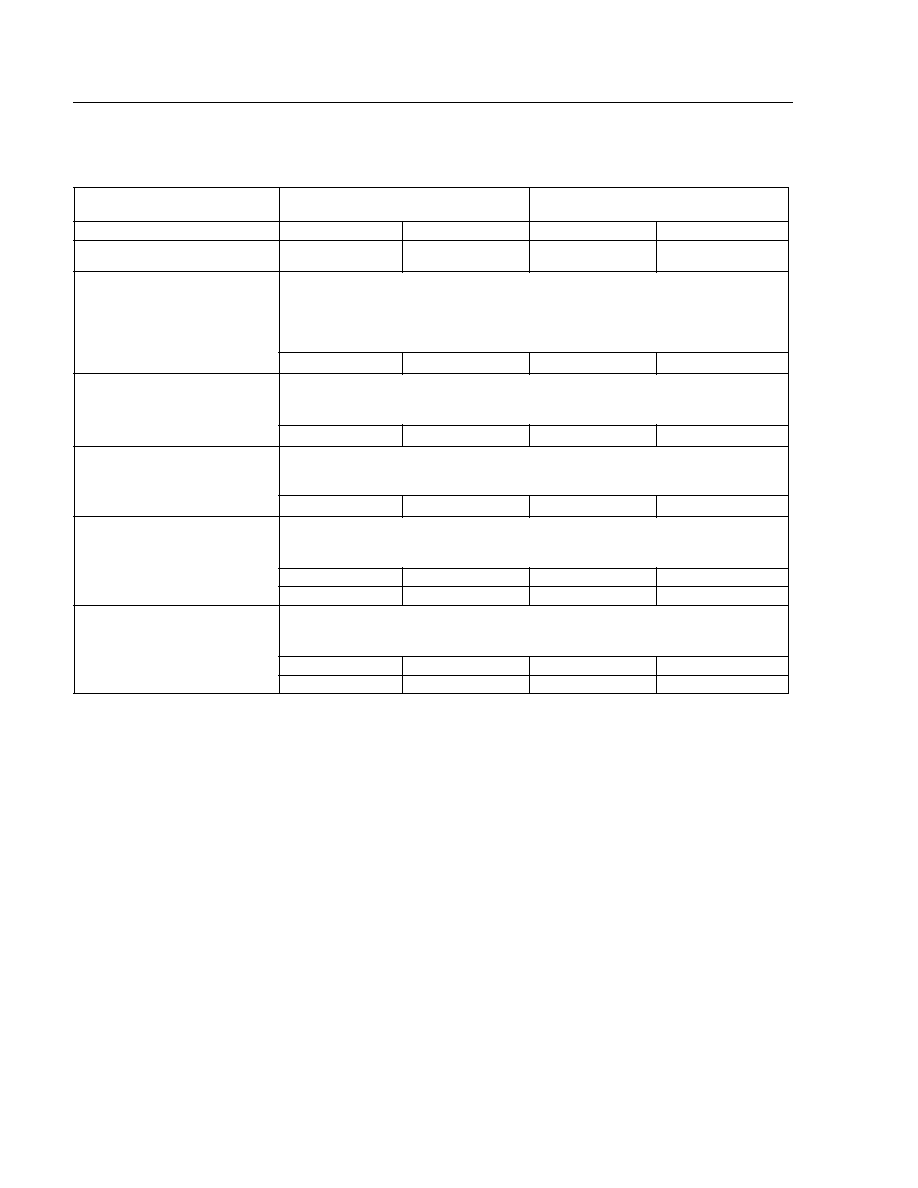
Preliminary Data Sheet
DSP1628 Digital Signal Processor
February 1997
85
Lucent Technologies Inc.
9 Electrical Characteristics and Requirements
(continued)
* T = CKI clock cycle for 1X input clock option or T = CKI clock cycle divided by M/(2N) for PLL clock option (see Section 4.12).
t
L
= PLL lock time (see Table 64).
The power dissipation listed is for internal power dissipation only. Total power dissipation can be calculated on the
basis of the application by adding C x V
DD
2
x f for each output, where C is the additional load capacitance and f is
the output frequency.
Power dissipation due to the input buffers is highly dependent on the input voltage level. At full CMOS levels, es-
sentially no dc current is drawn. However, for levels between the power supply rails, especially at or near the thresh-
old of V
DD
/2, high currents can flow. Although input and I/O buffers may be left untied (since the input voltage levels
of the input and I/O buffers are designed to remain at full CMOS levels when not driven by the DSP), it is still rec-
ommended that unused input and I/O pins be tied to V
SS
or V
DD
through a 10 k
resistor to avoid application am-
biguities. Further, if I/O pins are tied high or low, they should be pulled fully to V
SS
or V
DD
.
WARNING: The device needs to be clocked for at least six CKI cycles during reset after powerup. Other-
wise, high currents may flow.
Table 65. Power Dissipation and Wake-Up Latency
(continued)
Operating Mode
(Unused inputs at V
DD
or V
SS)
Typical Power Dissipation (mW)
Wake-Up Latency
V
DD=
3 V
3 V
3 V
3 V
I/O Units ON, ECCP OFF
powerc[7:4,0] = 0x01
I/O Units OFF, ECCP OFF
powerc[7:4,0] = 0xF1
(PLL Not Used
During Wake State)
(PLL Used
During Wake State)
Sleep with Slow Internal Clock
Small Signal Disabled
powerc[15:14] = 11,
alf[15] = 1, ioc = 0x0180
PLL Disabled During Sleep
Small Signal
0.40
0.30
20
µ
s
20
µ
s + t
L
Software Stop
powerc[15:12] = 0011
PLL Disabled During STOP
CMOS
0.060
0.060
3T*
3T* + t
L
Software Stop
powerc[15:12] = 1111
PLL Disabled During STOP
Small Signal
0.060
0.060
20
µ
s
20
µ
s + t
L
Hardware Stop (STOP = V
SS
)
powerc[15:12] = 0000
PLL Disabled During STOP
CMOS
0.060
0.060
3T*
--
Small Signal
1.20
1.20
3T*
--
Hardware Stop (STOP = V
SS
)
powerc[15:12] = 0000
PLL Enabled During STOP
CMOS
2.5
2.5
3T*
3T*
Small Signal
3.6
3.6
3T*
3T*

Preliminary Data Sheet
February 1997
DSP1628 Digital Signal Processor
Lucent Technologies Inc.
86
10 Timing Characteristics for 2.7 V Operation
The following timing characteristics and requirements are preliminary information and are subject to change. Timing
characteristics refer to the behavior of the device under specified conditions. Timing requirements refer to conditions
imposed on the user for proper operation of the device. All timing data is valid for the following conditions:
T
A
= ≠40
∞
C to +85
∞
C (See Section 8.3.)
V
DD
= 3 V
±
10%, V
SS
= 0 V (See Section 8.3.)
Capacitance load on outputs (C
L
) = 50 pF, except for CKO, where C
L
= 20 pF
Output characteristics can be derated as a function of load capacitance (C
L
).
All outputs: 0.03 ns/pF
dt/dC
L
0.07 ns/pF for 10
C
L
100 pF
at V
IH
for rising edge and at V
IL
for falling edge
For example, if the actual load capacitance is 30 pF instead of 50 pF, the derating for a rising edge is (30 ≠ 50) pF
x 0.06 ns/pF = 1.2 ns less than the specified rise time or delay that includes a rise time.
Test conditions for inputs:
s
Rise and fall times of 4 ns or less
s
Timing reference levels for delays = V
IH
, V
IL
Test conditions for outputs (unless noted otherwise):
s
C
LOAD
= 50 pF; except for CKO, where C
LOAD
= 20 pF
s
Timing reference levels for delays = V
IH
, V
IL
s
3-state delays measured to the high-impedance state of the output driver
For the timing diagrams, see Table 62 for input clock requirements.
Unless otherwise noted, CKO in the timing diagrams is the free-running CKO.
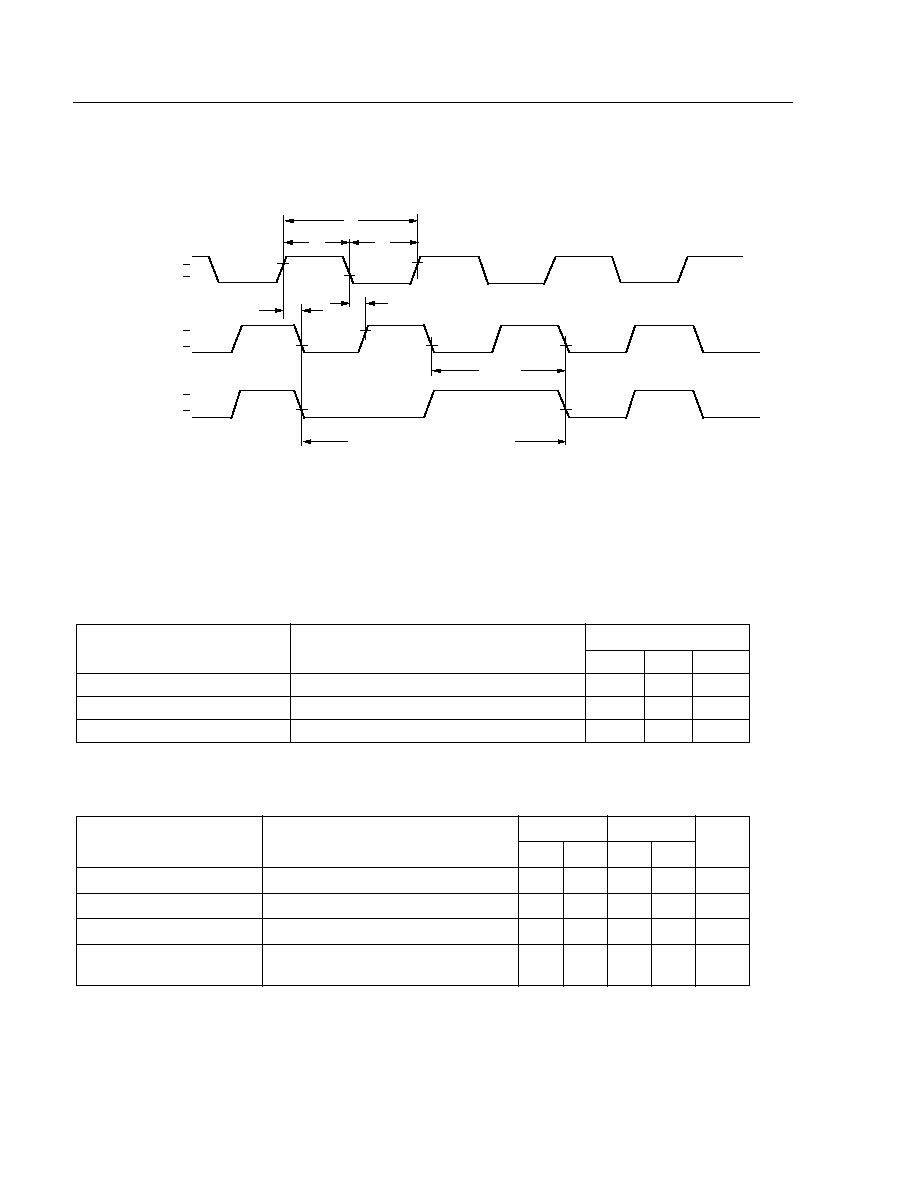
Preliminary Data Sheet
DSP1628 Digital Signal Processor
February 1997
87
Lucent Technologies Inc.
10 Timing Characteristics for 2.7 V Operation
(continued)
10.1 DSP Clock Generation
* See Table 62 for input clock electrical requirements.
Free-running clock.
Wait-stated clock (see Table 38).
ß W = number of wait-states.
Figure 11. I/O Clock Timing Diagram
* Device speeds greater than 50 MIPS do not support 1X operation. Use the PLL.
Device is fully static, t1 is tested at 100 ns for 1X input clock option, and memory hold time is tested at 0.1 s.
* T = internal clock period, set by CKI or by CKI and the PLL parameters.
Table 66. Timing Requirements for Input Clock
Abbreviated Reference
Parameter
19.2 ns and 12.5 ns
*
Min
Max
Unit
t1
Clock In Period (high to high)
20
--
ns
t2
Clock In Low Time (low to high)
10
--
ns
t3
Clock In High Time (high to low)
10
--
ns
Table 67. Timing Characteristics for Input Clock and Output Clock
Abbreviated Reference
Parameter
19.2 ns
12.5 ns
Unit
Min
Max
Min
Max
t4
Clock Out High Delay
--
14
--
10
ns
t5
Clock Out Low Delay (high to low)
--
14
--
10
ns
t6
Clock Out Period (low to low)
T*
--
T*
--
ns
t6a
Clock Out Period with SLOWCKI Bit
Set in powerc Register (low to low)
0.74
3.8
0.74
3.8
µ
s
t4
t6, t6a
t1
t2
1X CKI*
V
IH
V
IL
V
OH
V
OL
V
OH
V
OL
t5
CKO
EXTERNAL MEMORY CYCLE
W = 1
ß
CKO
t3
5-4009 (C).a

Preliminary Data Sheet
February 1997
DSP1628 Digital Signal Processor
Lucent Technologies Inc.
88
10 Timing Characteristics for 2.7 V Operation
(continued)
10.2 Reset Circuit
The DSP1628 has two external reset pins: RSTB and TRST. At initial powerup, or if the supply voltage falls below
V
DD
MIN* and a device reset is required, both TRST and RSTB must be asserted to initialize the device. Figure 12
shows two separate events:
1. Chip reset at initial powerup.
2. Chip reset following a drop in power supply.
Note:
The TRST pin must be asserted even if the JTAG controller is not used by the application.
* See Table 60, Recommended Operating Conditions.
* When both INT0 and RSTB are asserted, all output and bidirectional pins (except TDO, which 3-states by JTAG control) are put in a
3-state condition. With RSTB asserted and INT0 not asserted, EROM, ERAMHI, ERAMLO, IO, and RWN outputs remain high, and CKO
remains a free-running clock.
See Table 62 for input clock electrical requirements.
Figure 12. Powerup Reset and Chip Reset Timing Diagram
Note:
The device needs to be clocked for at least six CKI cycles during reset after powerup. Otherwise,
high currents may flow.
Table 68. Timing Requirements for Powerup Reset and Chip Reset
Abbreviated Reference
Parameter
Min
Max
Unit
t8
RSTB and TRST Reset Pulse (low to high)
6T
--
ns
t9
V
DD
Ramp
--
10
ms
t146
V
DD
MIN to RSTB Low
CMOS
Small-signal
2T
20
--
--
ns
µ
s
t153
RSTB (low to high)
--
54
ns
Table 69. Timing Characteristics for Powerup Reset and Chip Reset
Abbreviated Reference
Parameter
Min
Max
Unit
t10
RSTB Disable Time (low to 3-state)
--
100
ns
t11
RSTB Enable Time (high to valid)
--
100
ns
V
DD
RAMP
RSTB,
TRST
OUTPUT
PINS *
CKI
t11
V
OH
V
OL
V
IH
V
IL
t9
t146
t10
0.4 V
V
DD
MIN
t11
V
DD
MIN
0.4 V
t10
t9
t146
t153
t8
t153
t8
5-4010 (C).a
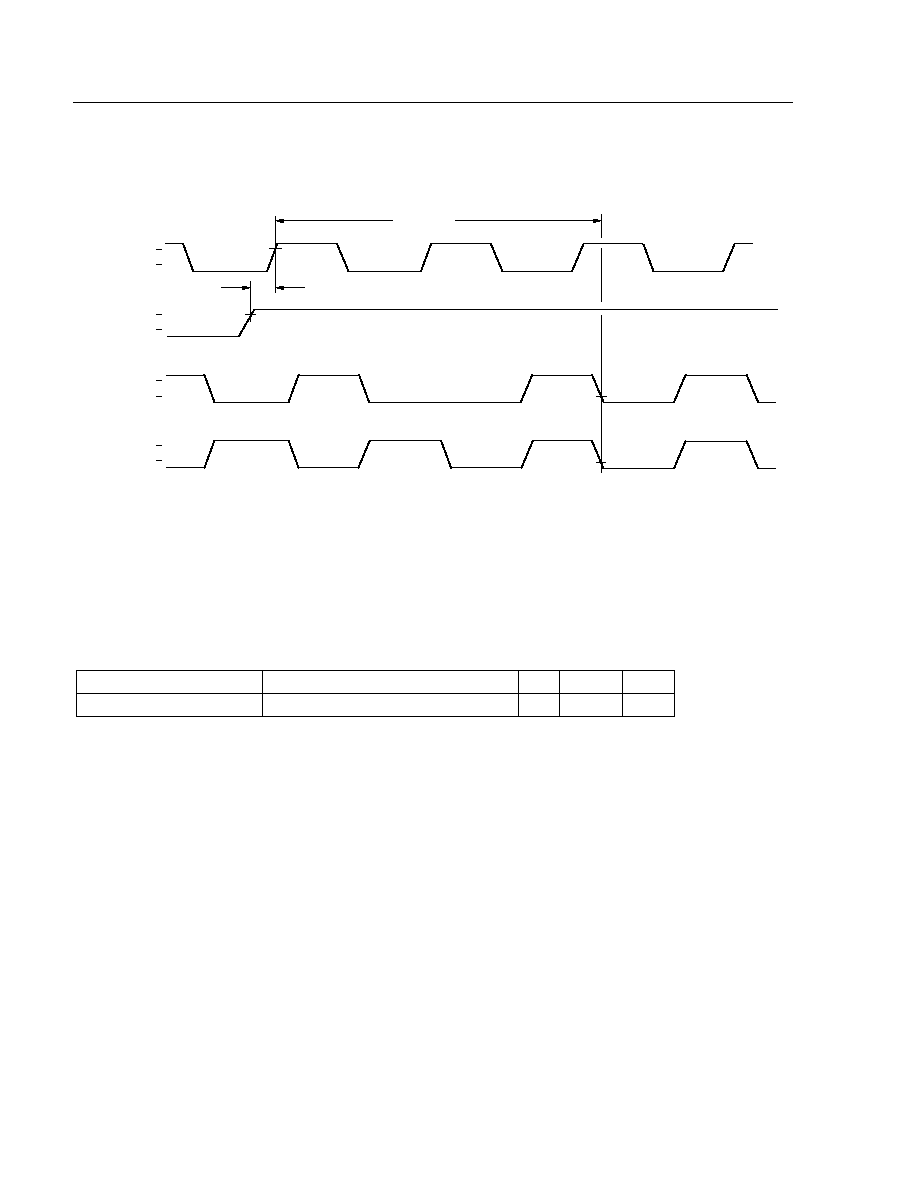
Preliminary Data Sheet
DSP1628 Digital Signal Processor
February 1997
89
Lucent Technologies Inc.
10 Timing Characteristics for 2.7 V Operation
(continued)
10.3 Reset Synchronization
* See Table 62 for input clock electrical requirements.
Note 1: CKO
1
and CKO
2
are two possible CKO states before reset. CKO is free-running.
Note 2: If the rising edge of RSTB (low to high) is captured instead by the falling edge of CKO (high to low), CKO and CKI will be in-phase
at t5 + 2 x t6.
Figure 13. Reset Synchronization Timing
Table 70. Timing Requirements for Reset Synchronization Timing
Abbreviated Reference
Parameter
Min
Max
Unit
t126
Reset Setup (high to high)
3
T/2 ≠ 1
ns
CKI*
V
IH
V
IL
RSTB
t126
t5 + 2 x t6
CKO
2
CKO
1
V
IH
V
IL
V
OH
V
OL
V
OH
V
OL
5-4011 (C).a

Preliminary Data Sheet
February 1997
DSP1628 Digital Signal Processor
Lucent Technologies Inc.
90
10 Timing Characteristics for 2.7 V Operation
(continued)
10.4 JTAG I/O Specifications
Figure 14. JTAG Timing Diagram
Table 71. Timing Requirements for JTAG Input/Output
Abbreviated Reference
Parameter
Min
Max
Unit
t12
TCK Period (high to high)
50
--
ns
t13
TCK High Time (high to low)
22.5
--
ns
t14
TCK Low Time (low to high)
22.5
--
ns
t155
TCK Rise Transition Time (low to high)
0.6
--
V/ns
t156
TCK Fall Transition Time (high to low)
0.6
--
V/ns
t15
TMS Setup Time (valid to high)
7.5
--
ns
t16
TMS Hold Time (high to invalid)
2
--
ns
t17
TDI Setup Time (valid to high)
7.5
--
ns
t18
TDI Hold Time (high to invalid)
2
--
ns
Table 72. Timing Characteristics for JTAG Input/Output
Abbreviated Reference
Parameter
Min
Max
Unit
t19
TDO Delay (low to valid)
--
19
ns
t20
TDO Hold (low to invalid)
0
--
ns
t12
t14
t13
t15
t16
t17
t18
t19
t20
TCK
TMS
TDI
TDO
V
IH
V
IL
V
IH
V
IL
V
IH
V
IL
V
OH
V
OL
t155
t156
5-4017 (C)

Preliminary Data Sheet
DSP1628 Digital Signal Processor
February 1997
91
Lucent Technologies Inc.
10 Timing Characteristics for 2.7 V Operation
(continued)
10.5 Interrupt
* CKO is free-running.
IACK assertion is guaranteed to be enclosed by VEC[3:0] assertion.
Figure 15. Interrupt Timing Diagram
Table 73. Timing Requirements for Interrupt
Table 74. Timing Characteristics for Interrupt
Note: Interrupt is asserted during an interruptible instruction and no other pending interrupts.
Abbreviated Reference
Parameter
Min
Max
Unit
t21
Interrupt Setup (high to low)
19
--
ns
t22
INT Assertion Time (high to low)
2T
--
ns
Note: Interrupt is asserted during an interruptible instruction and no other pending interrupts.
Abbreviated Reference
Parameter
Min
Max
Unit
t23
IACK Assertion Time (low to high)
--
T/2 + 10
ns
t24
VEC Assertion Time (low to high)
--
12.5
ns
t25
IACK Invalid Time (low to low)
--
10
ns
t26
VEC Invalid Time (low to low)
--
12.5
ns
CKO*
t21
V
OH
V
OL
V
IH
V
IL
t22
IACK
V
OH
V
OL
VEC[3:0]
V
OH
V
OL
t23
t24
t25
t26
5-4018 (C).
INT[1:0]
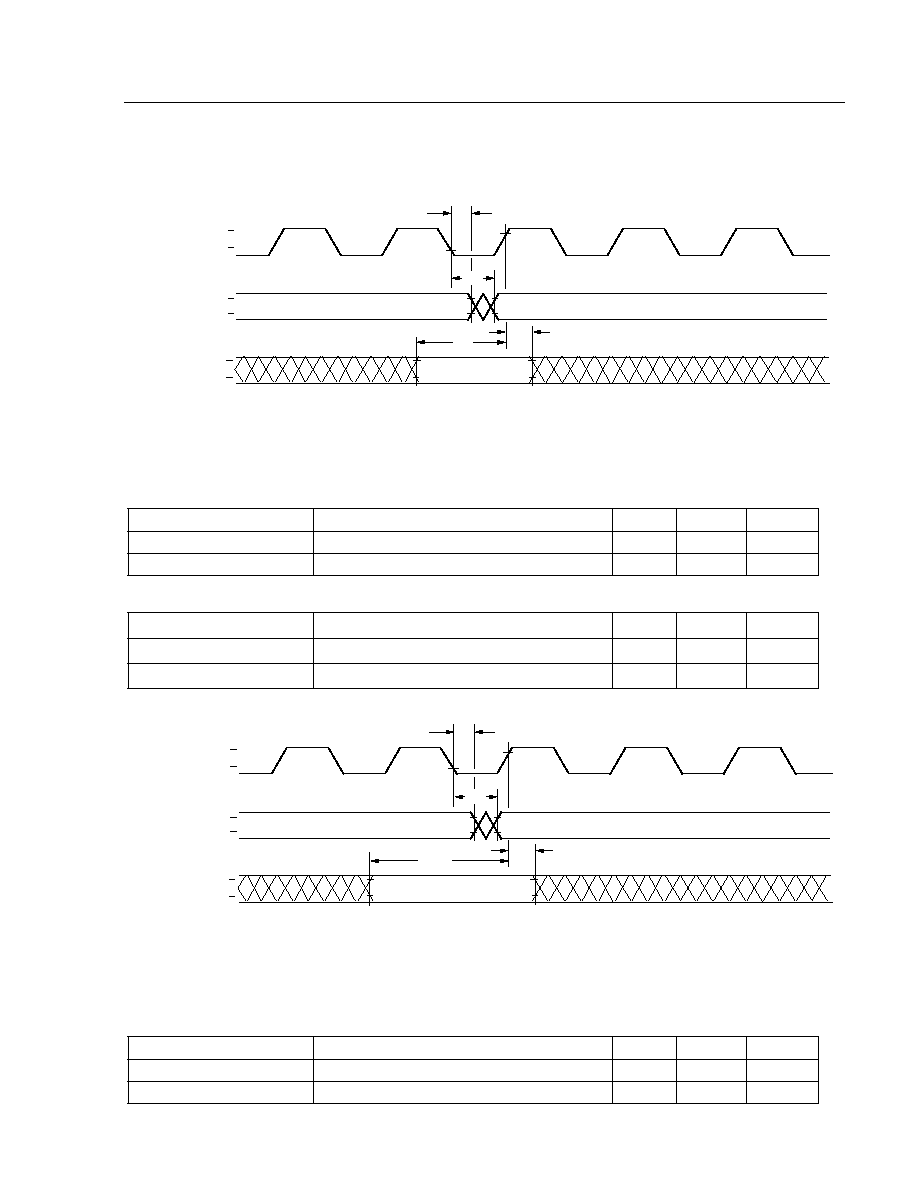
Preliminary Data Sheet
February 1997
DSP1628 Digital Signal Processor
Lucent Technologies Inc.
92
10 Timing Characteristics for 2.7 V Operation
(continued)
10.6 Bit Input/Output (BIO)
Figure 16. Write Outputs Followed by Read Inputs (cbit = Immediate; a1 = sbit)
Figure 17. Write Outputs and Test Inputs (cbit = Immediate)
Table 75. Timing Requirements for BIO Input Read
Abbreviated Reference
Parameter
Min
Max
Unit
t27
IOBIT Input Setup Time (valid to high)
15
--
ns
t28
IOBIT Input Hold Time (high to invalid)
0
--
ns
Table 76. Timing Characteristics for BIO Output
Abbreviated Reference
Parameter
Min
Max
Unit
t29
IOBIT Output Valid Time (low to valid)
--
9
ns
t144
IOBIT Output Hold Time (low to invalid)
1
--
ns
Table 77. Timing Requirements for BIO Input Test
Abbreviated Reference
Parameter
Min
Max
Unit
t141
IOBIT Input Setup Time (valid to low)
15
--
ns
t142
IOBIT Input Hold Time (low to invalid)
0
--
ns
CKO
IOBIT
(INPUT)
t28
t27
VALID OUTPUT
V
IH
V
IL
V
OH
V
OL
V
OH
V
OL
DATA INPUT
t29
t144
IOBIT
(OUTPUT)
5-4019 (C).a
CKO
IOBIT
(INPUT)
t142
t141
VALID OUTPUT
V
IH
V
IL
V
OH
V
OL
V
OH
V
OL
TEST INPUT
t29
t144
IOBIT
(OUTPUT)
5-4019 (C).b
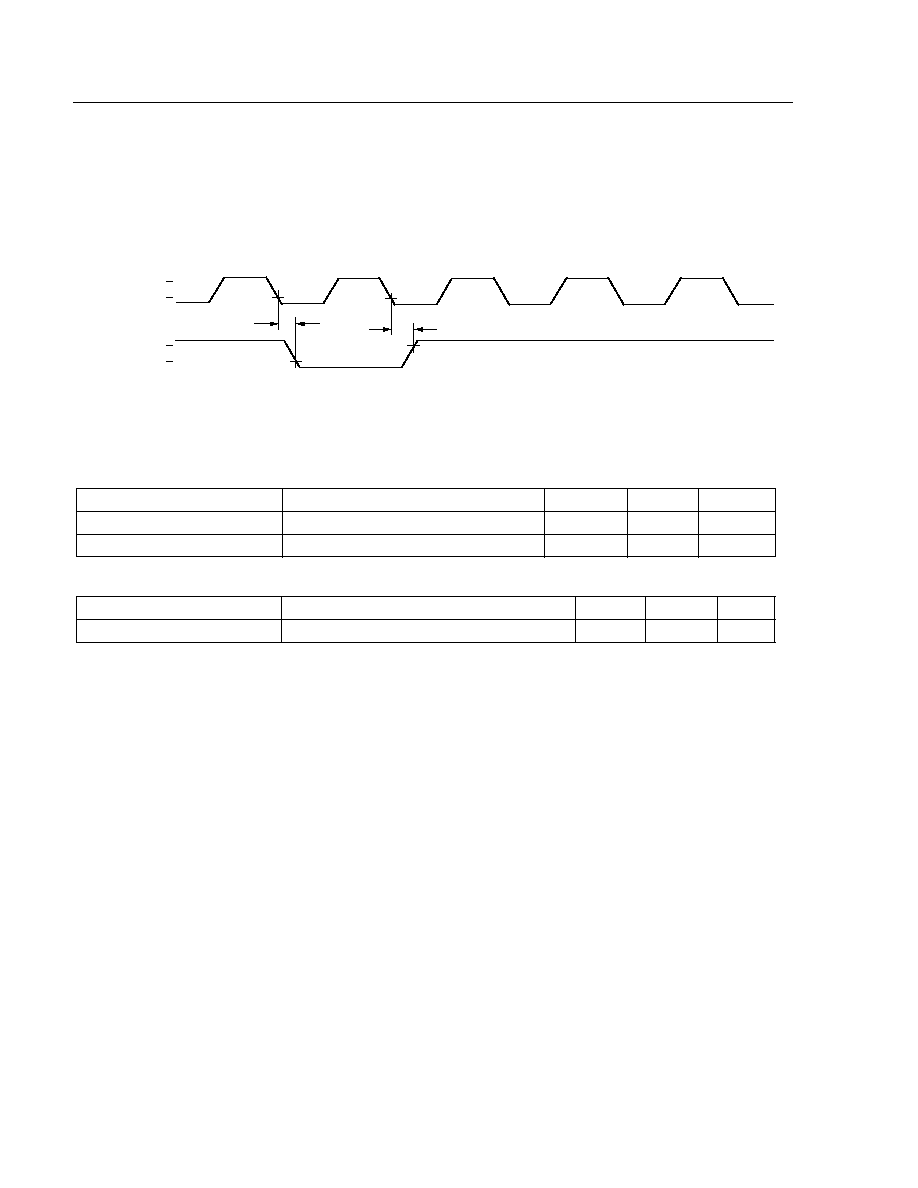
Preliminary Data Sheet
DSP1628 Digital Signal Processor
February 1997
93
Lucent Technologies Inc.
10 Timing Characteristics for 2.7 V Operation
(continued)
10.7 External Memory Interface
The following timing diagrams, characteristics, and requirements do not apply to interactions with delayed external
memory enables unless so stated. See the
DSP1611/17/18/27 Digital Signal Processor Information Manual for a
detailed description of the external memory interface including other functional diagrams.
* W = number of wait-states.
Figure 18. Enable Transition Timing
Table 78. Timing Characteristics for External Memory Enables (EROM, ERAMHI, IO, ERAMLO)
Abbreviated Reference
Parameter
Min
Max
Unit
t33
CKO to ENABLE Active (low to low)
0
5
ns
t34
CKO to ENABLE Inactive (low to high)
≠1
4.5
ns
Table 79. Timing Characteristics for Delayed External Memory Enables (ioc = 0x000F)
Abbreviated Reference
Parameter
Min
Max
Unit
t33
CKO to Delayed ENABLE Active (low to low)
T/2
T/2 + 7
ns
CKO
ENABLE
t34
t33
W* = 0
V
OH
V
OL
V
OH
V
OL
5-4020 (C).b
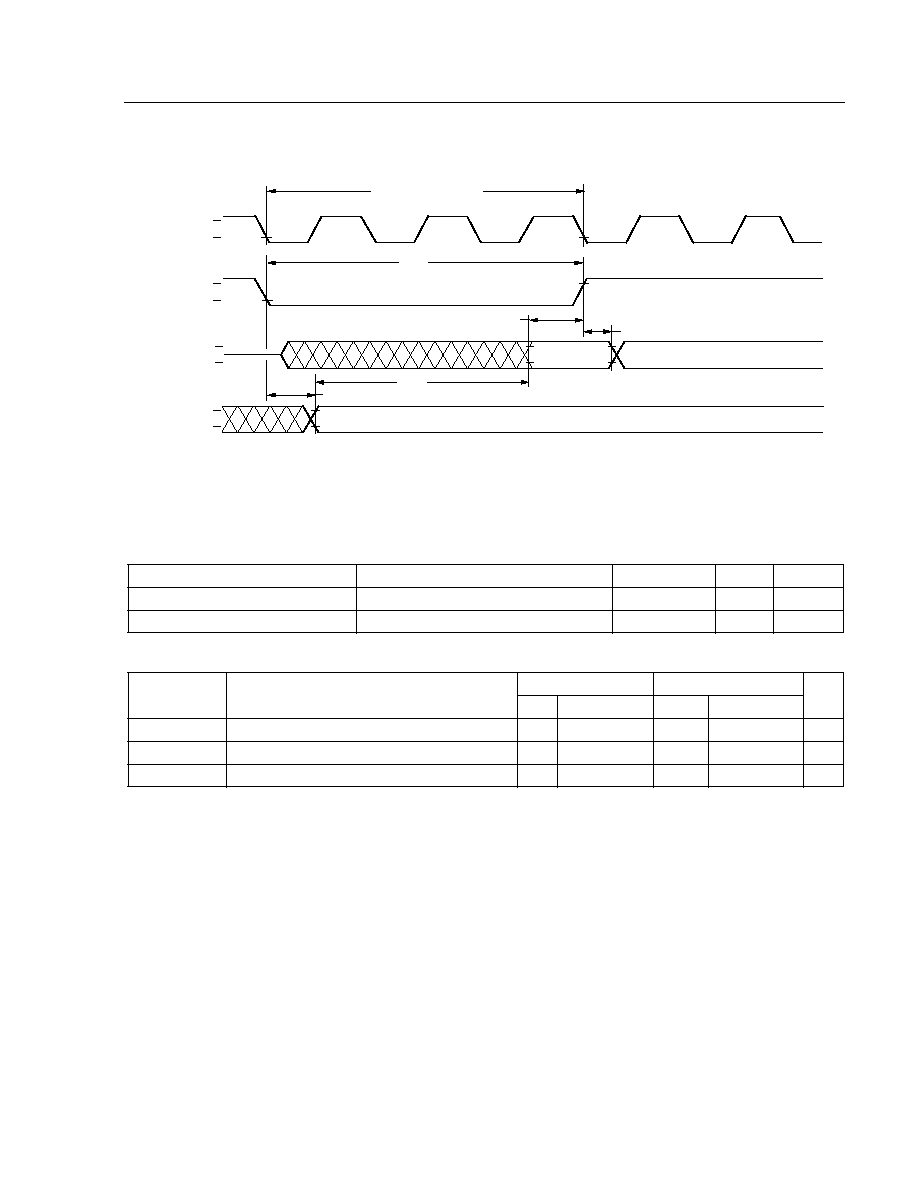
Preliminary Data Sheet
February 1997
DSP1628 Digital Signal Processor
Lucent Technologies Inc.
94
10 Timing Characteristics for 2.7 V Operation
(continued)
* W = number of wait-states.
Figure 19. External Memory Data Read Timing Diagram
Table 80. Timing Characteristics for External Memory Access
Abbreviated Reference
Parameter
Min
Max
Unit
t127
Enable Width (low to high)
T(1 + W) ≠ 1.5
--
ns
t128
Address Valid (enable low to valid)
--
2.5
ns
Table 81. Timing Requirements for External Memory Read (EROM, ERAMHI, IO, ERAMLO)
Abbreviated
Reference
Parameter
19.2 ns
12.5 ns
Unit
Min
Max
Min
Max
t129
Read Data Setup (valid to enable high)
15
--
13
--
ns
t130
Read Data Hold (enable high to hold)
0
--
0
--
ns
t150
External Memory Access Time (valid to valid)
--
T(1 + W) ≠ 15
--
T(1 + W) ≠ 14
ns
V
IH
V
IL
DB
CKO
AB
V
OH
V
OL
t128
READ ADDRESS
ENABLE
V
OH
V
OL
V
OH
V
OL
(MWAIT = 0x2222)
W* = 2
t127
t129
t130
READ DATA
t150
5-4021 (C).a
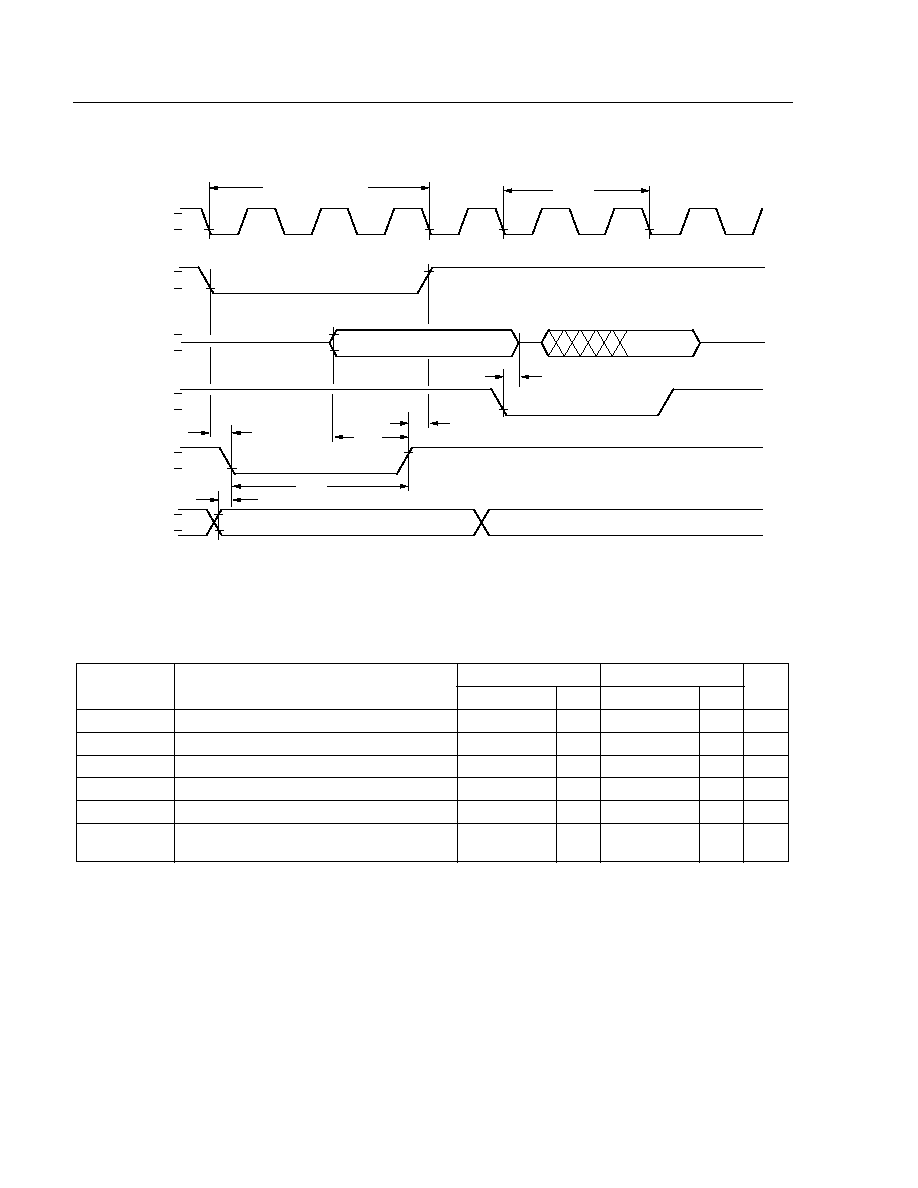
Preliminary Data Sheet
DSP1628 Digital Signal Processor
February 1997
95
Lucent Technologies Inc.
10 Timing Characteristics for 2.7 V Operation
(continued)
* W = number of wait-states.
Figure 20. External Memory Data Write Timing Diagram
Table 82. Timing Characteristics for External Memory Data Write (All Enables)
Abbreviated
Reference
Parameter
19.2 ns
12.5 ns
Unit
Min
Max
Min
Max
t131
Write Overlap (enable low to 3-state)
--
0
--
0
ns
t132
RWN Advance (RWN high to enable high)
0
--
0
--
ns
t133
RWN Delay (enable low to RWN low)
0
--
0
--
ns
t134
Write Data Setup (data valid to RWN high)
T(1 + W)/2 ≠ 4
--
T(1 + W)/2 ≠ 3
--
ns
t135
RWN Width (low to high)
T(1 + W) ≠ 5
--
T(1 + W) ≠ 4
--
ns
t136
Write Address Setup (address valid to RWN
low)
0
--
0
--
ns
ERAMLO
EROM
CKO
AB
RWN
DB
WRITE ADDRESS
READ ADDRESS
V
OH
V
OL
V
OH
V
OL
V
OH
V
OL
V
OH
V
OL
V
OH
V
OL
WRITE DATA
READ
W* = 1
t131
t132
t134
t133
t135
t136
(MWAIT = 0x1002)
W* = 2
V
OH
V
OL
5-4022 (C).a
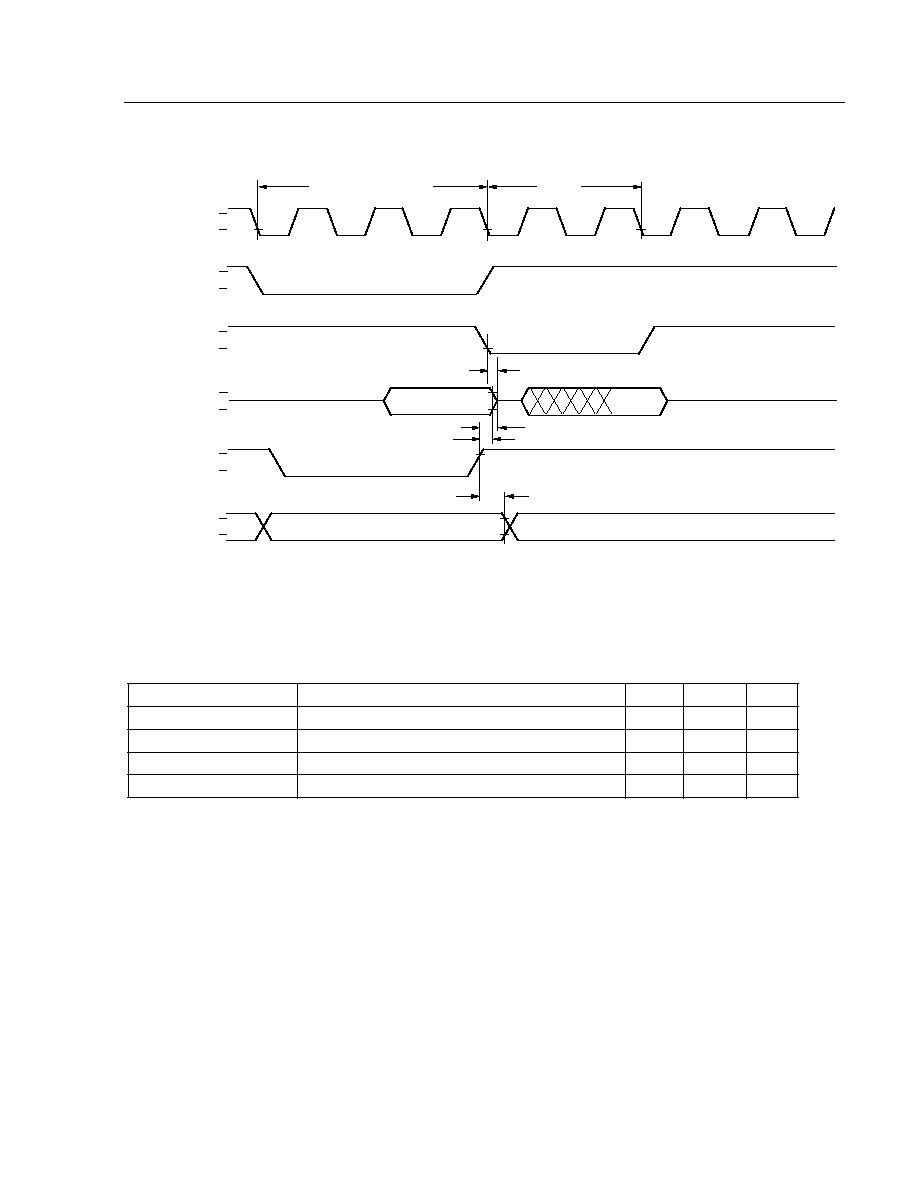
Preliminary Data Sheet
February 1997
DSP1628 Digital Signal Processor
Lucent Technologies Inc.
96
10 Timing Characteristics for 2.7 V Operation
(continued)
* W = number of wait-states.
Figure 21. Write Cycle Followed by Read Cycle
Table 83. Timing Characteristics for Write Cycle Followed by Read Cycle
Abbreviated Reference
Parameter
Min
Max
Unit
t131
Write Overlap (enable low to 3-state)
--
0
ns
t137
Write Data 3-state (RWN high to 3-state)
--
2
ns
t138
Write Data Hold (RWN high to data hold)
0
--
ns
t139
Write Address Hold (RWN high to address hold)
0
--
ns
ERAMLO
CKO
AB
RWN
WRITE ADDRESS
READ ADDRESS
V
OH
V
OL
V
OH
V
OL
V
OH
V
OL
V
OH
V
OL
W* = 1
t137
(MWAIT = 0x1002)
W* = 2
EROM
V
OH
V
OL
DB
WRITE
READ
V
OH
V
OL
t138
t139
t131
5-4023 (C).a

Preliminary Data Sheet
DSP1628 Digital Signal Processor
February 1997
97
Lucent Technologies Inc.
10 Timing Characteristics for 2.7 V Operation
(continued)
10.8 PHIF Specifications
For the PHIF, read means read by the external user (output by the DSP); write is similarly defined. The 8-bit reads/
writes are identical to one-half of a 16-bit access.
Figure 22. PHIF
Intel Mode Signaling (Read and Write) Timing Diagram
* This timing diagram for the PHIF port shows accesses using the PCSN signal to initiate and complete a transaction. The transactions can also
be initiated and completed with the PIDS and PODS signals. An output transaction (read) is initiated by PCSN or PODS going low, whichever
comes last. For example, the timing requirements referenced to PCSN going low, t45 and t49, should be referenced to PODS going low, if
PODS goes low after PCSN. An output transaction is completed by PCSN or PODS going high, whichever comes first. An input transaction is
initiated by PCSN or PIDS going low, whichever comes last. An input transaction is completed by PCSN or PIDS going high, whichever comes
first. All requirements referenced to PCSN apply to PIDS or PODS, if PIDS or PODS is the controlling signal.
Table 84. Timing Requirements for PHIF
Intel Mode Signaling
Abbreviated Reference
Parameter
Min
Max
Unit
t41
PODS to PCSN Setup (low to low)
0
--
ns
t42
PCSN to PODS Hold (high to high)
0
--
ns
t43
PIDS to PCSN Setup (low to low)
0
--
ns
t44
PCSN to PIDS Hold (high to high)
0
--
ns
t45*
PSTAT to PCSN Setup (valid to low)
4
--
ns
t46*
PCSN to PSTAT Hold (high to invalid)
0
--
ns
t47*
PBSEL to PCSN Setup (valid to low)
6
--
ns
t48*
PCSN to PBSEL Hold (high to invalid)
0
--
ns
t51*
PB Write to PCSN Setup (valid to high)
10
--
ns
t52*
PCSN to PB Write Hold (high to invalid)
4
--
ns
Table 85. Timing Characteristics for PHIF
Intel Mode Signaling
Abbreviated Reference
Parameter
Min
Max
Unit
t49*
PCSN to PB Read (low to valid)
--
12
ns
t50*
PCSN to PB Read Hold (high to invalid)
0
--
ns
t154
PCSN to PB Read 3-state (high to 3-state)
--
8
ns
PCSN
V
IH
V
IL
t41
t42
t43
t45
t46
t49
t50
16-bit READ
16-bit WRITE
PODS
PIDS
PBSEL
PSTAT
PB[7:0]
t47
t51
t52
t48
t44
V
IH
V
IL
V
IH
V
IL
V
IH
V
IL
V
IH
V
IL
t154
5-4036 (C)
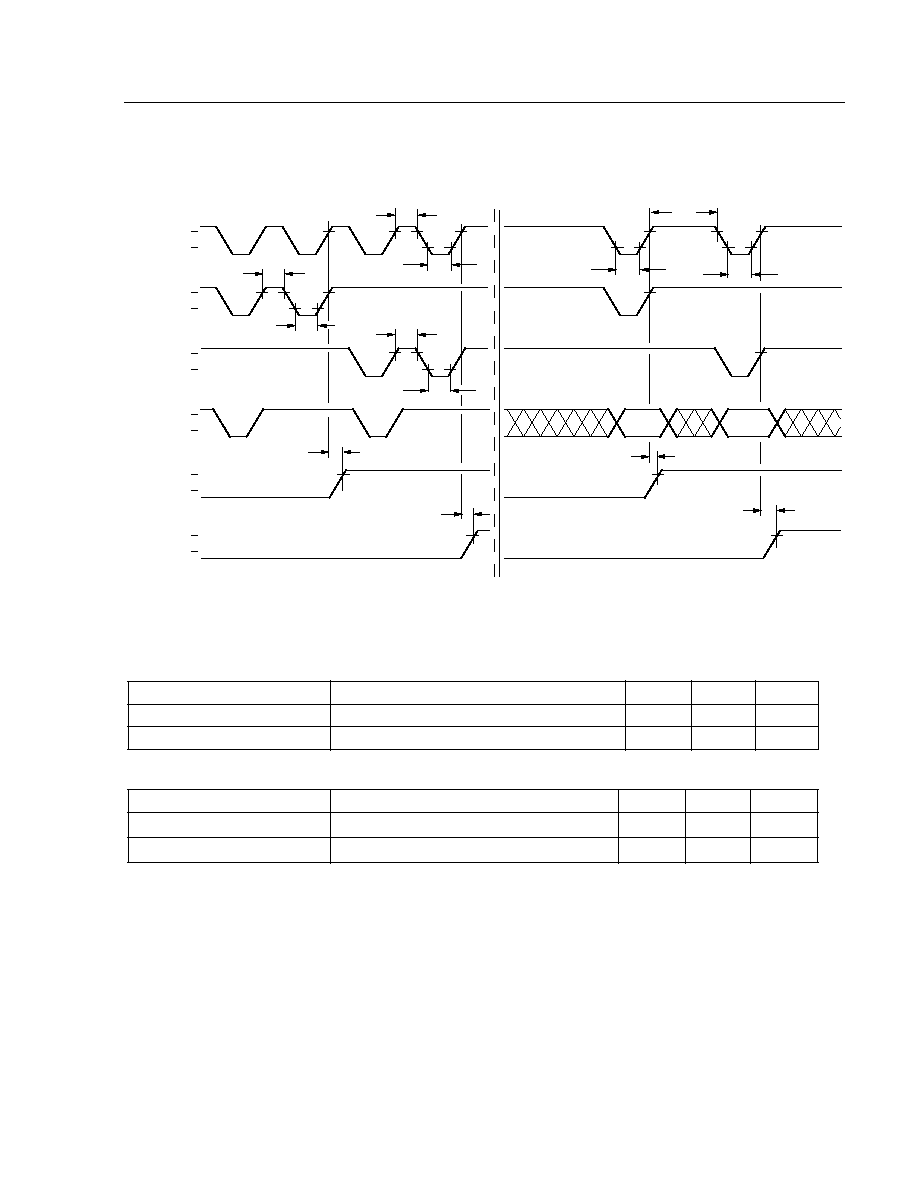
Preliminary Data Sheet
February 1997
DSP1628 Digital Signal Processor
Lucent Technologies Inc.
98
10 Timing Characteristics for 2.7 V Operation
(continued)
Figure 23. PHIF
Intel Mode Signaling (Pulse Period and Flags) Timing Diagram
* t53 should be referenced to the rising edge of PCSN or PODS, whichever comes first.
t54 should be referenced to the rising edge of
PCSN or PIDS, whichever comes first.
POBE and PIBF may be programmed to be the opposite logic levels shown in the diagram (positive assertion levels shown). t53 and
t54 apply to the inverted levels as well as those shown.
Table 86. Timing Requirements for PHIF
Intel Mode Signaling
Abbreviated Reference
Parameter
Min
Max
Unit
t55
PCSN/PODS/PIDS Pulse Width (high to low)
20.5
--
ns
t56
PCSN/PODS/PIDS Pulse Width (low to high)
20.5
--
ns
Table 87. Timing Characteristics for PHIF
Intel Mode Signaling
Abbreviated Reference
Parameter
Min
Max
Unit
t53*
PCSN/PODS to POBE
(high to high)
--
17
ns
t54*
PCSN/PIDS to PIBF
(high to high)
--
17
ns
PODS
PIDS
V
IH
V
IL
V
IH
V
IL
V
IH
V
IL
t55
t56
t55
t56
t55
t56
PCSN
t53
t54
16-bit READ
8-bit WRITE
PBSEL
POBE
PIBF
t54
V
OH
V
OL
V
OH
V
OL
V
OH
V
OL
t56
t56
t55
t53
8-bit READ
16-bit WRITE
5-4037 (C).a
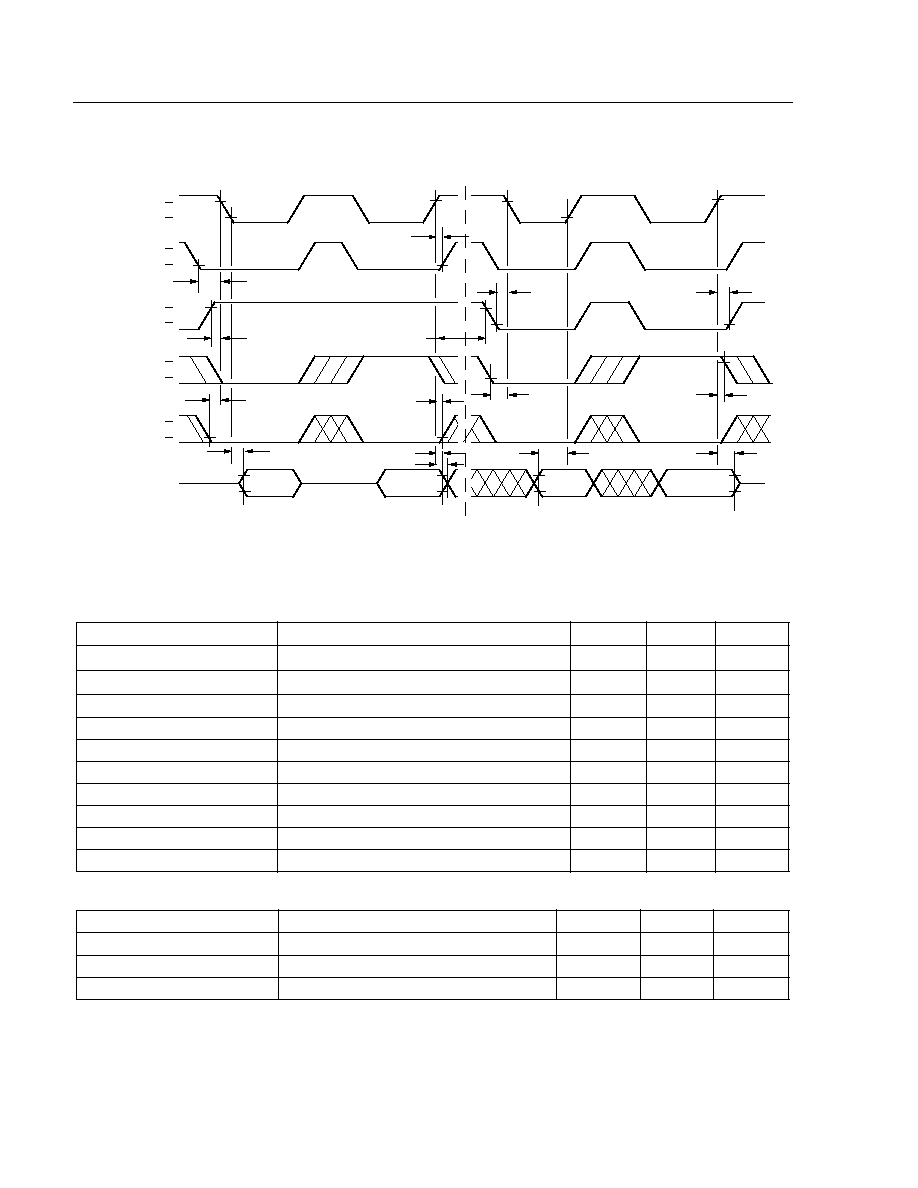
Preliminary Data Sheet
DSP1628 Digital Signal Processor
February 1997
99
Lucent Technologies Inc.
10 Timing Characteristics for 2.7 V Operation
(continued)
Figure 24. PHIF
Motorola Mode Signaling (Read and Write) Timing Diagram
* This timing diagram for the PHIF port shows accesses using the PCSN signal to initiate and complete a transaction. The transactions can also
be initiated and completed with the PDS signal. An input/output transaction is initiated by PCSN or PDS going low, whichever comes last. For
example, the timing requirements referenced to PCSN going low, t45 and t49, should be referenced to PDS going low, if PDS goes low after
PCSN. An input/output transaction is completed by PCSN or PDS going high, whichever comes first. All requirements referenced to PCSN
should be referenced to PDS, if PDS is the controlling signal. PRWN should never be used to initiate or complete a transaction.
PDS is programmable to be active-high or active-low. It is shown active-low in Figures 24 and 25. POBE and PIBF may be programmed to be
the opposite logic levels shown in the diagram. t53 and t54 apply to the inverted levels as well as those shown.
Table 88. Timing Requirements for PHIF
Motorola Mode Signaling
Abbreviated Reference
Parameter
Min
Max
Unit
t41
PDS
to PCSN Setup (valid to low)
0
--
ns
t42
PCSN to PDS
Hold (high to invalid)
0
--
ns
t43
PRWN to PCSN Setup (valid to low)
4
--
ns
t44
PCSN to PRWN Hold (high to invalid)
0
--
ns
t45*
PSTAT to PCSN Setup (valid to low)
4
--
ns
t46*
PCSN to PSTAT Hold (high to invalid)
0
--
ns
t47*
PBSEL to PCSN Setup (valid to low)
6
--
ns
t48*
PCSN to PBSEL Hold (high to invalid)
0
--
ns
t51*
PB Write to PCSN Setup (valid to high)
10
--
ns
t52*
PCSN to PB Write Hold (high to invalid)
4
--
ns
Table 89. Timing Characteristics for PHIF
Motorola Mode Signaling
Abbreviated Reference
Parameter
Min
Max
Unit
t49*
PCSN to PB Read (low to valid)
--
12
ns
t50*
PCSN to PB Read Hold (high to invalid)
0
--
ns
t154
PCSN to PB Read 3-state (high to 3-state)
--
8
ns
PCSN
PDS
PRWN
PBSEL
PSTAT
PB[7:0]
t41
t42
t43
t44
t45
t46
t47
t48
t52
t51
t50
t49
16-bit READ
16-bit WRITE
t43
t44
V
IH
V
IL
V
IH
V
IL
V
IH
V
IL
V
IH
V
IL
V
IH
V
IL
t154
5-4038 (C).a

Preliminary Data Sheet
February 1997
DSP1628 Digital Signal Processor
Lucent Technologies Inc.
100
10 Timing Characteristics for 2.7 V Operation
(continued)
Figure 25. PHIF
Motorola Mode Signaling (Pulse Period and Flags) Timing Diagram
* An input/output transaction is initiated by PCSN or PDS going low, whichever comes last. For example, t53 and t54 should be referenced
to PDS going low, if PDS goes low after PCSN. An input/output transaction is completed by PCSN or PDS going high, whichever comes first.
All requirements referenced to PCSN should be referenced to PDS, if PDS is the controlling signal. PRWN should never be used to initiate or
complete a transaction.
PDS is programmable to be active-high or active-low. It is shown active-low in Figures 24 and 25. POBE and PIBF may be programmed to
be the opposite logic levels shown in the diagram. t53 and t54 apply to the inverted levels as well as those shown.
Table 90. Timing Characteristics for PHIF
Motorola Mode Signaling
Abbreviated Reference
Parameter
Min
Max
Unit
t53*
PCSN/PDS
to POBE
(high to high)
--
17
ns
t54*
PCSN/PDS
to PIBF
(high to high)
--
17
ns
Table 91. Timing Requirements for PHIF
Motorola Mode Signaling
Abbreviated Reference
Parameter
Min
Max
Unit
t55
PCSN/PDS/PRWN Pulse Width (high to low)
20
--
ns
t56
PCSN/PDS/PRWN Pulse Width (low to high)
20
--
ns
PODS
PIDS
V
IH
V
IL
V
IH
V
IL
V
IH
V
IL
t55
t56
t55
t56
t55
t56
PCSN
t53
t54
16-bit READ
8-bit WRITE
PBSEL
POBE
PIBF
t54
V
OH
V
OL
V
OH
V
OL
V
OH
V
OL
t56
t56
t55
t53
8-bit READ
16-bit WRITE
5-4039 (C).a
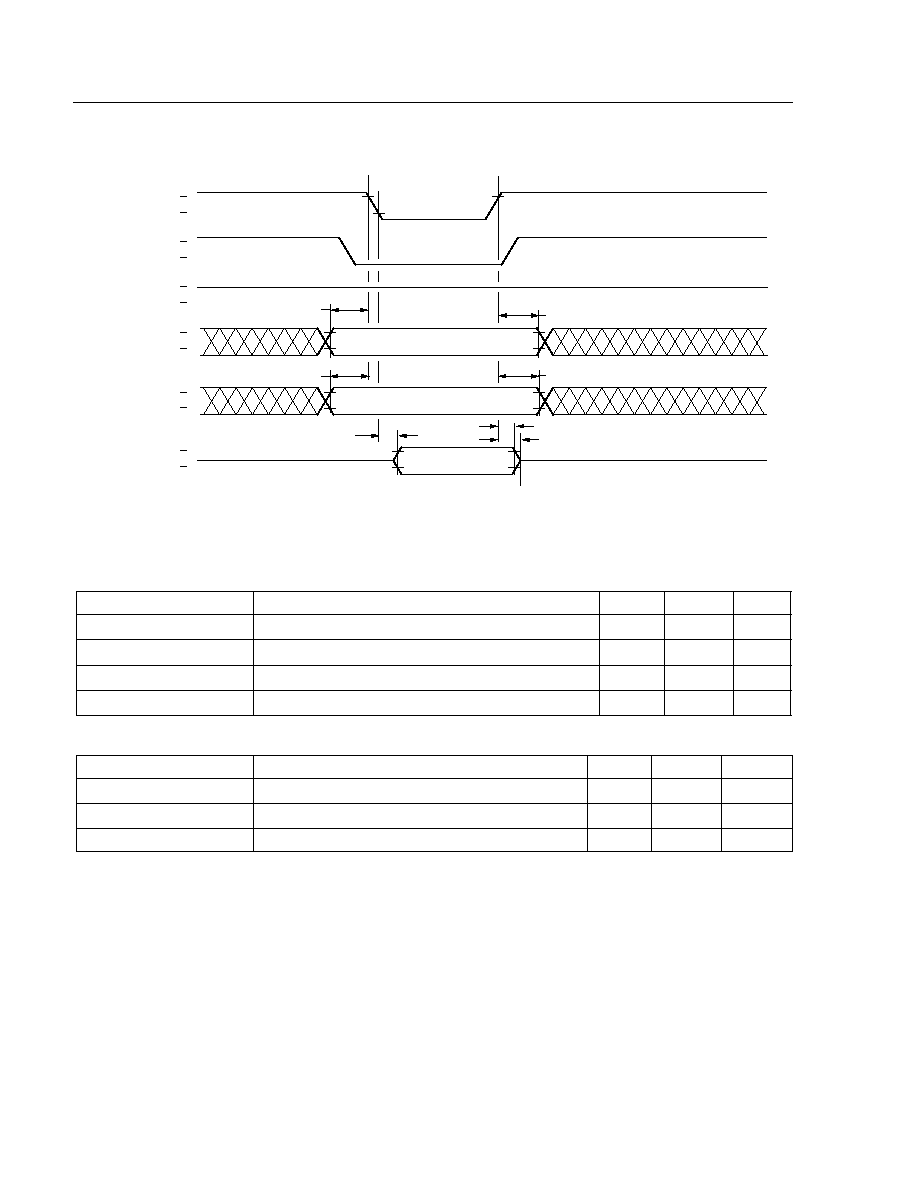
Preliminary Data Sheet
DSP1628 Digital Signal Processor
February 1997
101
Lucent Technologies Inc.
10 Timing Characteristics for 2.7 V Operation
(continued)
*
Motorola mode signal name.
Figure 26. PHIF
Intel or Motorola Mode Signaling (Status Register Read) Timing Diagram
t45, t47, and t49 are referenced to the falling edge of PCSN or PODS(PDS), whichever occurs last.
t46, t48, t154, and t50 are referenced to the rising edge of PCSN or PODS(PDS), whichever occurs first.
Table 92. Timing Requirements for
Intel and Motorola Mode Signaling (Status Register Read)
Abbreviated Reference
Parameter
Min
Max
Unit
t45
PSTAT to PCSN Setup (valid to low)
4
--
ns
t46
PCSN to PSTAT Hold (high to invalid)
0
--
ns
t47
PBSEL to PCSN Setup (valid to low)
6
--
ns
t48
PCSN to PBSEL Hold (high to invalid)
0
--
ns
Table 93. Timing Characteristics for
Intel and Motorola Mode Signaling (Status Register Read)
Abbreviated Reference
Parameter
Min
Max
Unit
t49
PCSN to PB Read (low to valid)
--
12
ns
t50
PCSN to PB Read Hold (high to invalid)
0
--
ns
t154
PCSN to PB 3-state (high to 3-state)
--
8
ns
PCSN
PODS(PDS*)
PIDS(PRWN*)
PBSEL
PSTAT
PB[7:0]
t47
t48
t45
t46
t49
t50
V
IH
V
IL
V
OH
V
OL
V
IH
V
IL
V
IH
V
IL
V
IH
V
IL
V
IH
V
IL
t154
5-4040 (C).a
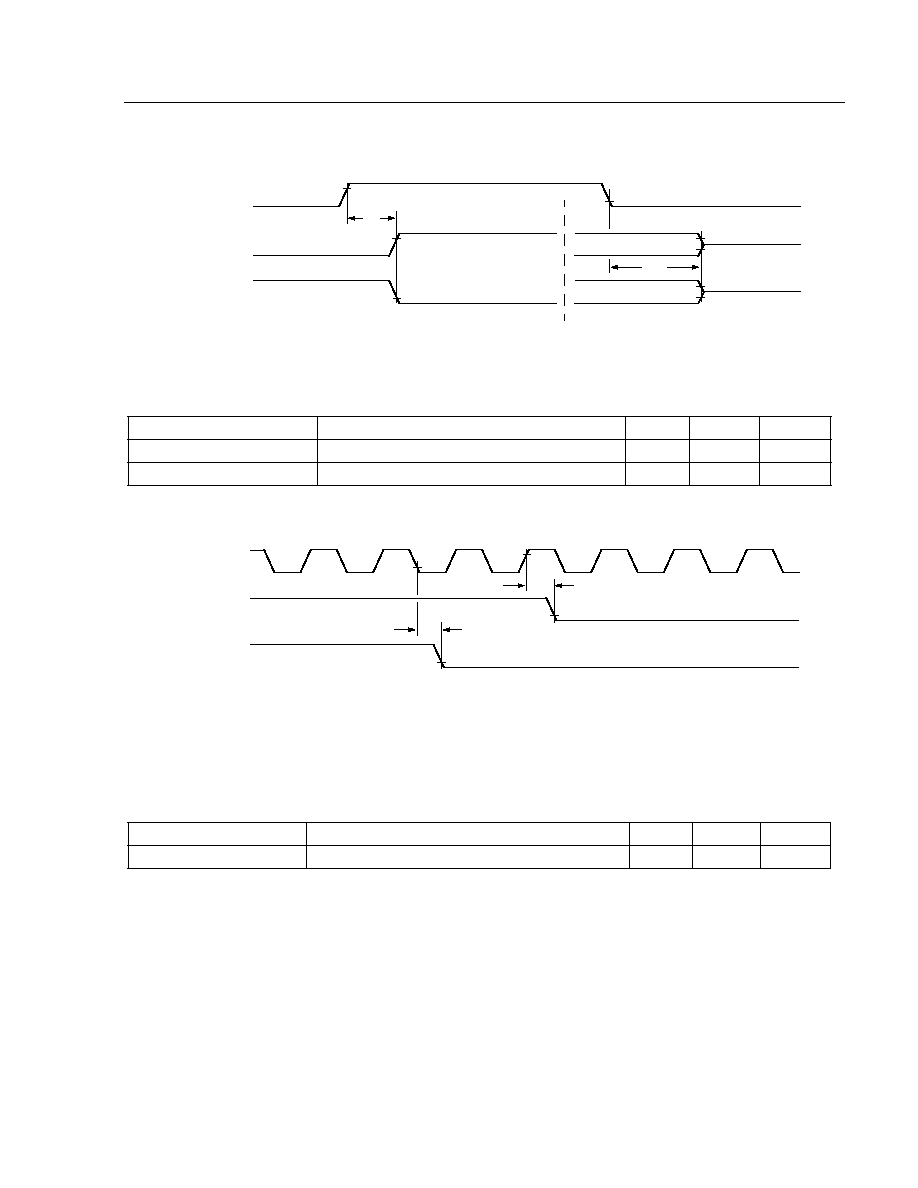
Preliminary Data Sheet
February 1997
DSP1628 Digital Signal Processor
Lucent Technologies Inc.
102
10 Timing Characteristics for 2.7 V Operation
(continued)
Figure 27. PHIF, PIBF, and POBE Reset Timing Diagram
* After reset, POBE and PIBF always go to the levels shown, indicating output buffer empty and input buffer empty. The DSP program,
however, may later invert the definition of the logic levels for POBE and PIBF. t57 and t58 continue to apply.
POBE and PIBF can be programmed to be active-high or active-low. They are shown active-high. The timing characteristic for
active-low is the same as for active-high
.
Figure 28. PHIF, PIBF, and POBE Disable Timing Diagram
Table 94. PHIF Timing Characteristics for PHIF, PIBF, and POBE Reset
Abbreviated Reference
Parameter
Min
Max
Unit
t57
RSTB Disable to POBE/PIBF* (high to valid)
--
25
ns
t58
RSTB Enable to POBE/PIBF* (low to invalid)
3
25
ns
Table 95. PHIF Timing Characteristics for POBE and PIBF Disable
Abbreviated Reference
Parameter
Min
Max
Unit
t59
CKO to POBE/PIBF* Disable (high/low to disable)
--
20
ns
RSTB
V
IH
≠
t58
t57
V
IL
≠
POBE
V
OH
≠
V
OL
≠
PIBF
V
OH
≠
V
OL
≠
5-4775 (F)
CKO
V
IH
≠
V
IL
≠
t59
t59
POBE
V
OH
≠
V
OL
≠
PIBF
V
OH
≠
V
OL
≠
5-4776 (F)
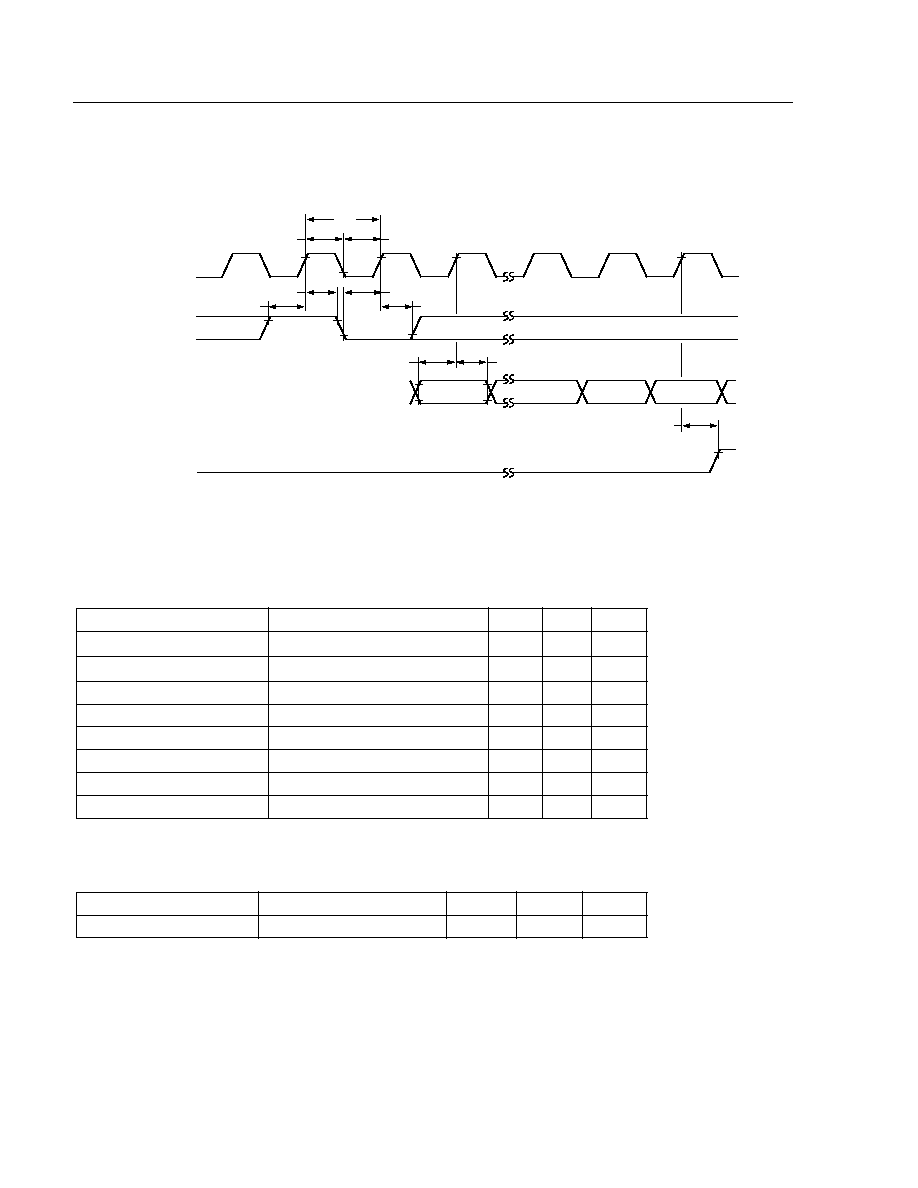
Preliminary Data Sheet
DSP1628 Digital Signal Processor
February 1997
103
Lucent Technologies Inc.
10 Timing Characteristics for 2.7 V Operation
(continued)
10.9 Serial I/O Specifications
* N = 16 or 8 bits.
Figure 29. SIO Passive Mode Input Timing Diagram
For multiprocessor mode, see note in Section 10.10.
Device is fully static; t70 is tested at 200 ns.
Table 96. Timing Requirements for Serial Inputs
Abbreviated Reference
Parameter
Min
Max
Unit
t70
Clock Period (high to high)
40
--
ns
t71
Clock Low Time (low to high)
18
--
ns
t72
Clock High Time (high to low)
18
--
ns
t73
Load High Setup (high to high)
8
--
ns
t74
Load Low Setup (low to high)
8
--
ns
t75
Load High Hold (high to invalid)
0
--
ns
t77
Data Setup (valid to high)
7
--
ns
t78
Data Hold (high to invalid)
0
--
ns
Table 97. Timing Characteristics for Serial Outputs
Abbreviated Reference
Parameter
Min
Max
Unit
t79
IBF Delay (high to high)
--
35
ns
IBF
V
OH
≠
V
OL
≠
DI
V
IH
≠
V
IL
≠
ILD
V
IH
≠
V
IL
≠
ICK
V
IH
≠
V
IL
≠
BN ≠ 1*
B0
t77
t78
B0
B1
t79
t72
t71
t70
t75
t74
t75
t73
5-4777 (F)
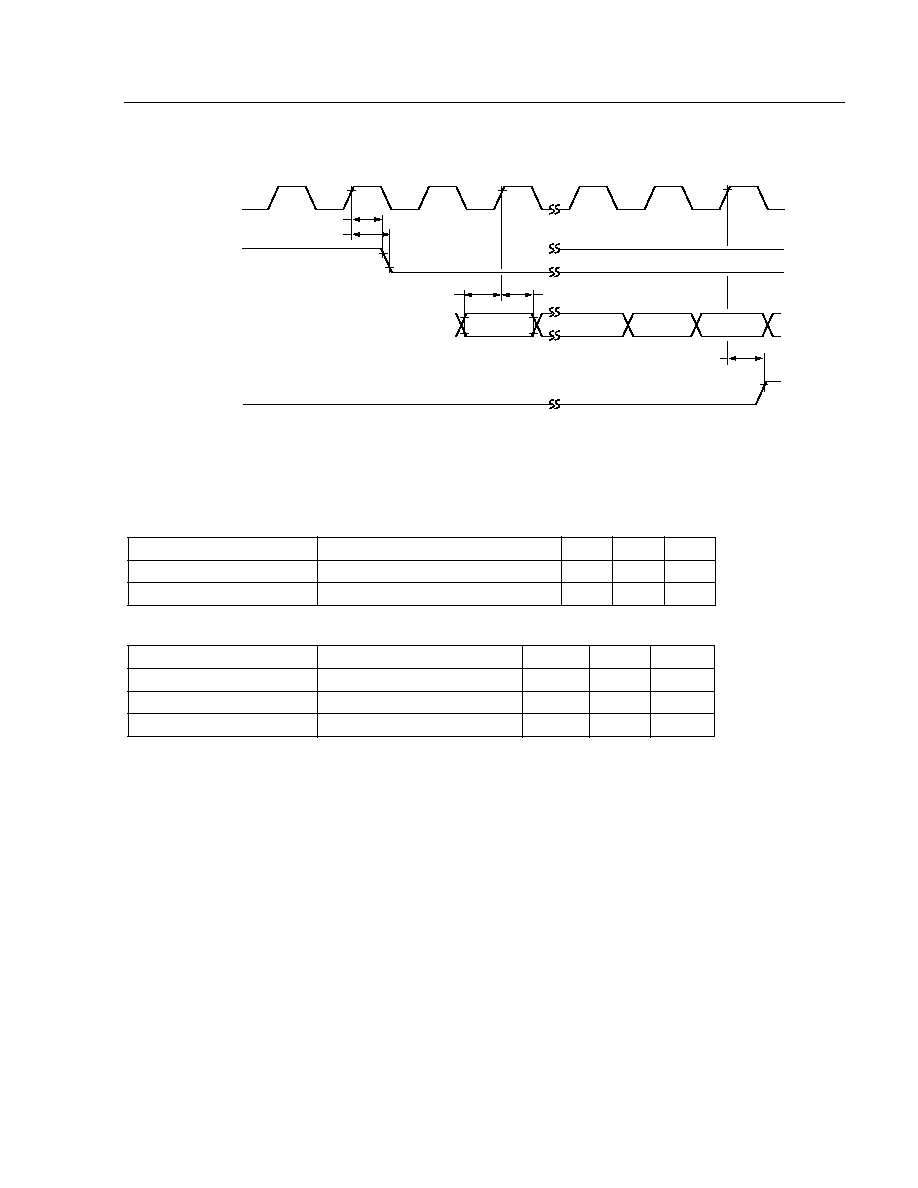
Preliminary Data Sheet
February 1997
DSP1628 Digital Signal Processor
Lucent Technologies Inc.
104
10 Timing Characteristics for 2.7 V Operation
(continued)
* ILD goes high during bit 6 (of 0:15), N = 8 or 16.
Figure 30. SIO Active Mode Input Timing Diagram
Table 98. Timing Requirements for Serial Inputs
Abbreviated Reference
Parameter
Min
Max
Unit
t77
Data Setup (valid to high)
7
--
ns
t78
Data Hold (high to invalid)
0
--
ns
Table 99. Timing Characteristics for Serial Outputs
Abbreviated Reference
Parameter
Min
Max
Unit
t76a
ILD Delay (high to low)
--
35
ns
t101
ILD Hold (high to invalid)
3
--
ns
t79
IBF Delay (high to high)
--
35
ns
IBF
V
OH
≠
V
OL
≠
DI
V
IH
≠
V
IL
≠
ILD
V
OH
≠
V
OL
≠
ICK
V
OH
≠
V
OL
≠
BN ≠ 1
B0
t77
t78
B0
B1
t79
t101
t76a
*
5-4778 (F)

Preliminary Data Sheet
DSP1628 Digital Signal Processor
February 1997
105
Lucent Technologies Inc.
10 Timing Characteristics for 2.7 V Operation
(continued)
* See sioc register, MSB field, to determine if B0 is the MSB or LSB. See sioc register, ILEN field, to determine if the DO word length
is 8 bits or 16 bits.
Figure 31. SIO Passive Mode Output Timing Diagram
For multiprocessor mode, see note in Section 10.10.
Device is fully static; t80 is tested at 200 ns.
Table 100. Timing Requirements for Serial Inputs
Abbreviated Reference
Parameter
Min
Max
Unit
t80
Clock Period (high to high)
40
--
ns
t81
Clock Low Time (low to high)
18
--
ns
t82
Clock High Time (high to low)
18
--
ns
t83
Load High Setup (high to high)
8
--
ns
t84
Load Low Setup (low to high)
8
--
ns
t85
Load Hold (high to invalid)
0
--
ns
Table 101. Timing Characteristics for Serial Outputs
Abbreviated Reference
Parameter
Min
Max
Unit
t87
Data Delay (high to valid)
--
35
ns
t88
Enable Data Delay (low to active)
--
35
ns
t89
Disable Data Delay (high to 3-state)
--
35
ns
t90
Data Hold (high to invalid)
3
--
ns
t92
Address Delay (high to valid)
--
35
ns
t93
Address Hold (high to invalid)
3
--
ns
t94
Enable Delay (low to active)
--
35
ns
t95
Disable Delay (high to 3-state)
--
35
ns
t96
OBE Delay (high to high)
--
35
ns
DOEN
V
IH
≠
V
IL
≠
SADD
V
OH
≠
V
OL
≠
OLD
V
IH
≠
V
IL
≠
OCK
V
IH
≠
V
IL
≠
t85
t80
t81
t82
t84
t83
t85
t88
B0
B1
B7
BN ≠ 1
t90
t90
t87
t94
AD0
AD1
AD7
t93
t93
t92
AS7
t89
t95
OBE
V
OH
≠
V
OL
≠
DO*
V
OH
≠
V
OL
≠
t96
5-4796 (F)
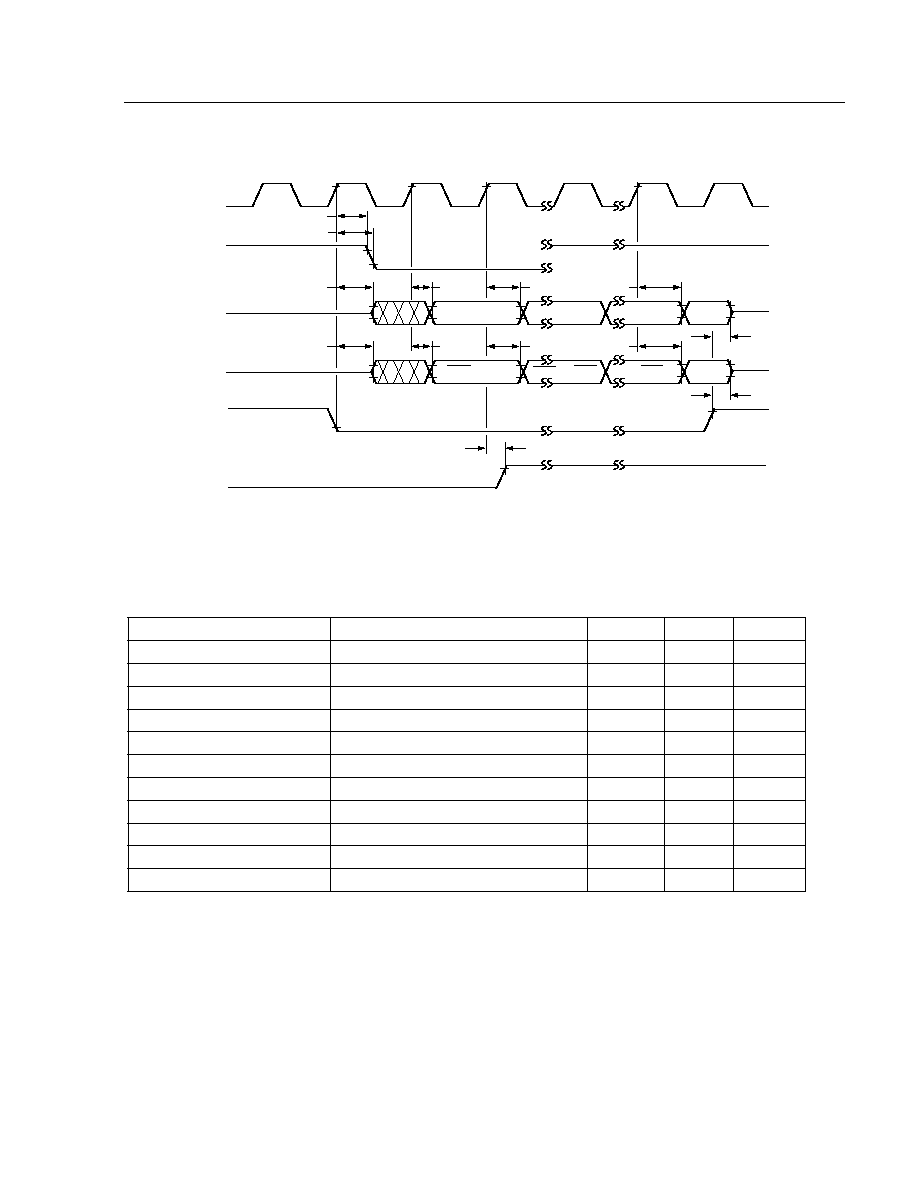
Preliminary Data Sheet
February 1997
DSP1628 Digital Signal Processor
Lucent Technologies Inc.
106
10 Timing Characteristics for 2.7 V Operation
(continued)
* OLD goes high at the end of bit 6 of 0:15.
Figure 32. SIO Active Mode Output Timing Diagram
Table 102. Timing Characteristics for Serial Output
Abbreviated Reference
Parameter
Min
Max
Unit
t86a
OLD Delay (high to low)
--
35
ns
t102
OLD Hold (high to invalid)
3
--
ns
t87
Data Delay (high to valid)
--
35
ns
t88
Enable Data Delay (low to active)
--
35
ns
t89
Disable Data Delay (high to 3-state)
--
35
ns
t90
Data Hold (high to invalid)
3
--
ns
t92
Address Delay (high to valid)
--
35
ns
t93
Address Hold (high to invalid)
3
--
ns
t94
Enable Delay (low to active)
--
35
ns
t95
Disable Delay (high to 3-state)
--
35
ns
t96
OBE Delay (high to high)
--
35
ns
DOEN
V
IH
≠
V
IL
≠
SADD
V
OH
≠
V
OL
≠
OLD
V
OH
≠
V
OL
≠
OCK
V
OH
≠
V
OL
≠
t102
t86a
t88
B0
B1
B7
BN ≠ 1
t90
t90
t87
t94
AD0
AD1
AD7
t93
t93
t92
AS7
t89
t95
OBE
V
OH
≠
V
OL
≠
DO
V
OH
≠
V
OL
≠
t96
*
5-4797 (F)

Preliminary Data Sheet
DSP1628 Digital Signal Processor
February 1997
107
Lucent Technologies Inc.
10 Timing Characteristics for 2.7 V Operation
(continued)
* See sioc register, LD field.
Figure 33. Serial I/O Active Mode Clock Timing
Table 103. Timing Characteristics for Signal Generation
Abbreviated Reference
Parameter
Min
Max
Unit
t97
ICK Delay (high to high)
--
18
ns
t98
ICK Delay (high to low)
--
18
ns
t99
OCK Delay (high to high)
--
18
ns
t100
OCK Delay (high to low)
--
18
ns
t76a
ILD Delay (high to low)
--
35
ns
t76b
ILD Delay (high to high)
--
35
ns
t101
ILD Hold (high to invalid)
3
--
ns
t86a
OLD Delay (high to low)
--
35
ns
t86b
OLD Delay (high to high)
--
35
ns
t102
OLD Hold (high to invalid)
3
--
ns
t103
SYNC Delay (high to low)
--
35
ns
t104
SYNC Delay (high to high)
--
35
ns
t105
SYNC Hold (high to invalid)
3
--
ns
ICK
V
OH
≠
V
OL
≠
CKO
V
OH
≠
V
OL
≠
t97
OCK
V
OH
≠
V
OL
≠
ICK/OCK*
V
OH
≠
ILD
V
OH
≠
V
OL
≠
OLD
V
OH
≠
V
OL
≠
SYNC
V
OH
≠
V
OL
≠
t99
t98
t100
t101
t76a
t101
t76b
t102
t86a
t102
t86b
t105
t103
t105
t104
5-4798 (F)
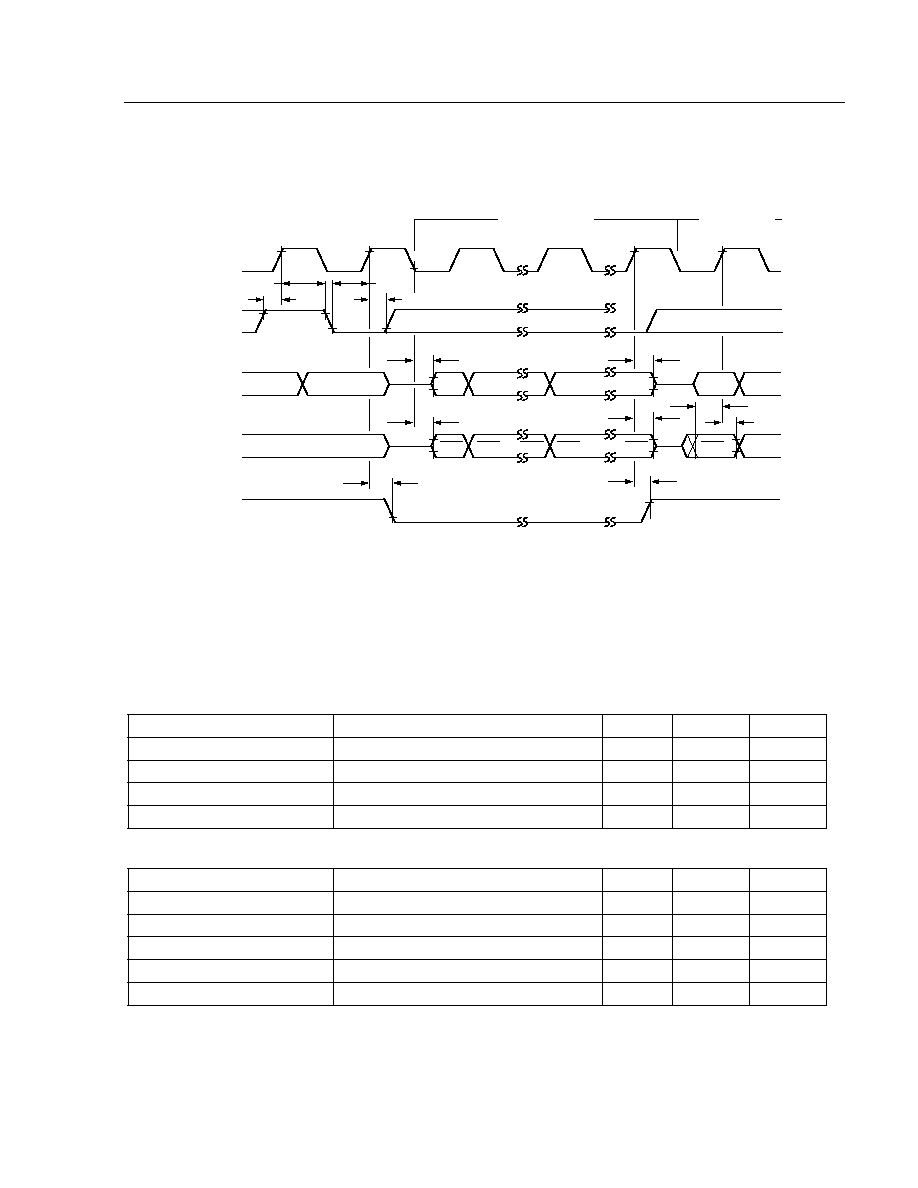
Preliminary Data Sheet
February 1997
DSP1628 Digital Signal Processor
Lucent Technologies Inc.
108
10 Timing Characteristics for 2.7 V Operation
(continued)
10.10 Multiprocessor Communication
* Negative edge initiates time slot 0.
Figure 34. SIO Multiprocessor Timing Diagram
Note:
All serial I/O timing requirements and characteristics still apply, but the minimum clock period in passive
multiprocessor mode, assuming 50% duty cycle, is calculated as (t77 + t116) x 2.
* With capacitance load on ICK, OCK, DO, SYNC, and SADD = 100 pF, add 4 ns to t116--t122.
Table 104. Timing Requirements for SIO Multiprocessor Communication
Abbreviated Reference
Parameter
Min
Max
Unit
t112
Sync Setup (high/low to high)
35
--
ns
t113
Sync Hold (high to high/low)
0
--
ns
t114
Address Setup (valid to high)
12
--
ns
t115
Address Hold (high to invalid)
0
--
ns
Table 105. Timing Characteristics for SIO Multiprocessor Communication
Abbreviated Reference
*
Parameter
Min
Max
Unit
t116
Data Delay (bit 0 only) (low to valid)
--
35
ns
t117
Data Disable Delay (high to 3-state)
--
30
ns
t120
DOEN Valid Delay (high to valid)
--
25
ns
t121
Address Delay (bit 0 only) (low to valid)
--
35
ns
t122
Address Disable Delay (high to 3-state)
--
30
ns
OCK/ICK
B0
B15
B8
B7
B1
B0
B15
SYNC
V
IH
≠
V
IL
≠
DO/D1
V
OH
≠
V
OL
≠
DOEN
V
OH
≠
V
OL
≠
t112
t113
t112
t113
TIME SLOT 1
TIME SLOT 2
t117
t116
AD0
AS7
AS0
AD7
AD1
AD0
SADD
t122
t121
t114
t115
t120
t120
*
5-4799 (F)
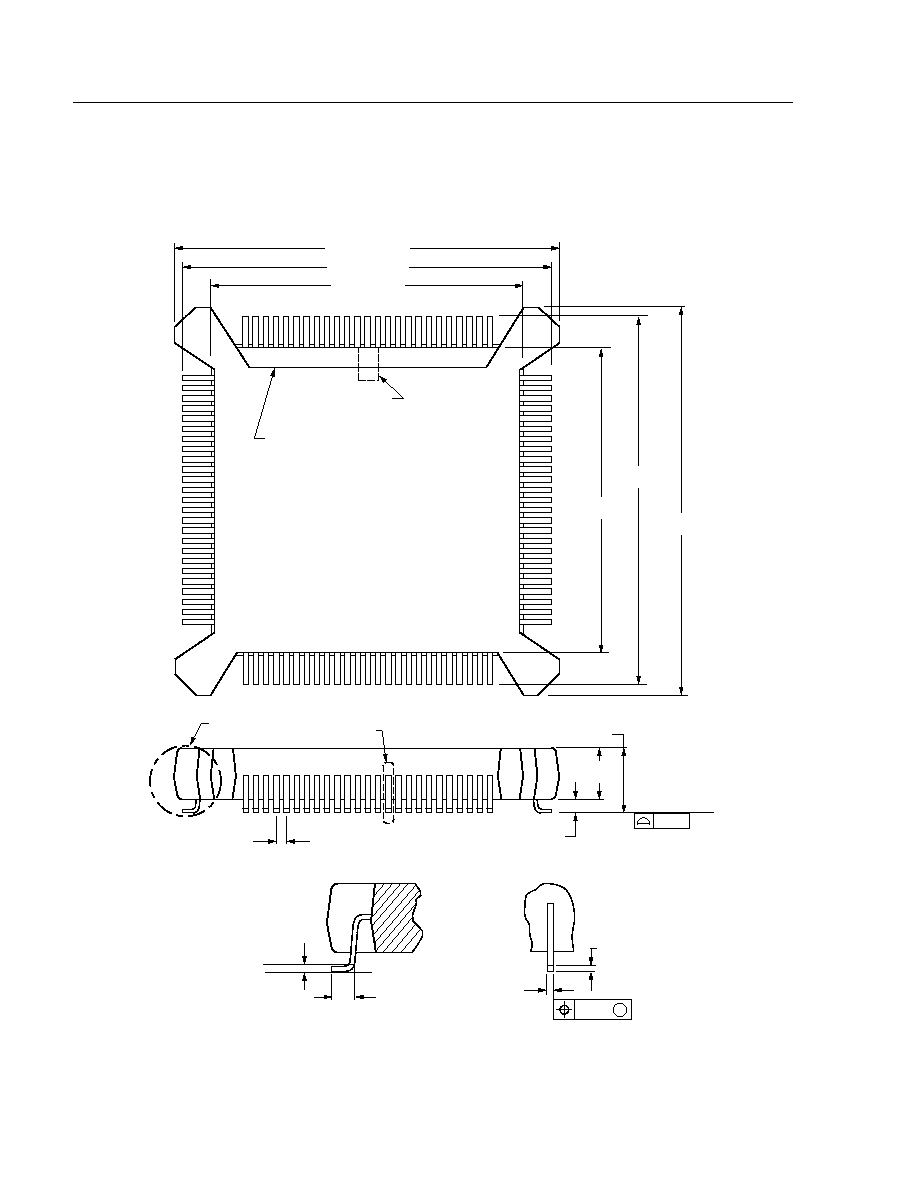
Preliminary Data Sheet
DSP1628 Digital Signal Processor
February 1997
109
Lucent Technologies Inc.
11 Outline Diagrams
11.1 100-Pin BQFP (Bumpered Quad Flat Pack)
All dimensions are in millimeters.
5-1970.r10
PIN #1
IDENTIFIER
ZONE
89
1
13
14
38
39
63
64
88
19.050
±
0.405
22.350
±
0.255
22.860
±
0.305
22.350
±
0.255
19.050
±
0.405
22.860
±
0.305
EDGE CHAMFER
DETAIL A
4.570 MAX
DETAIL B
0.760
±
0.255
0.635 TYP
0.10
SEATING PLANE
3.555
±
0.255
DETAIL A
0.255
0.91/1.17
GAGE PLANE
SEATING PLANE
DETAIL B
0.280
±
0.075
0.150
M
0.175
±
0.025
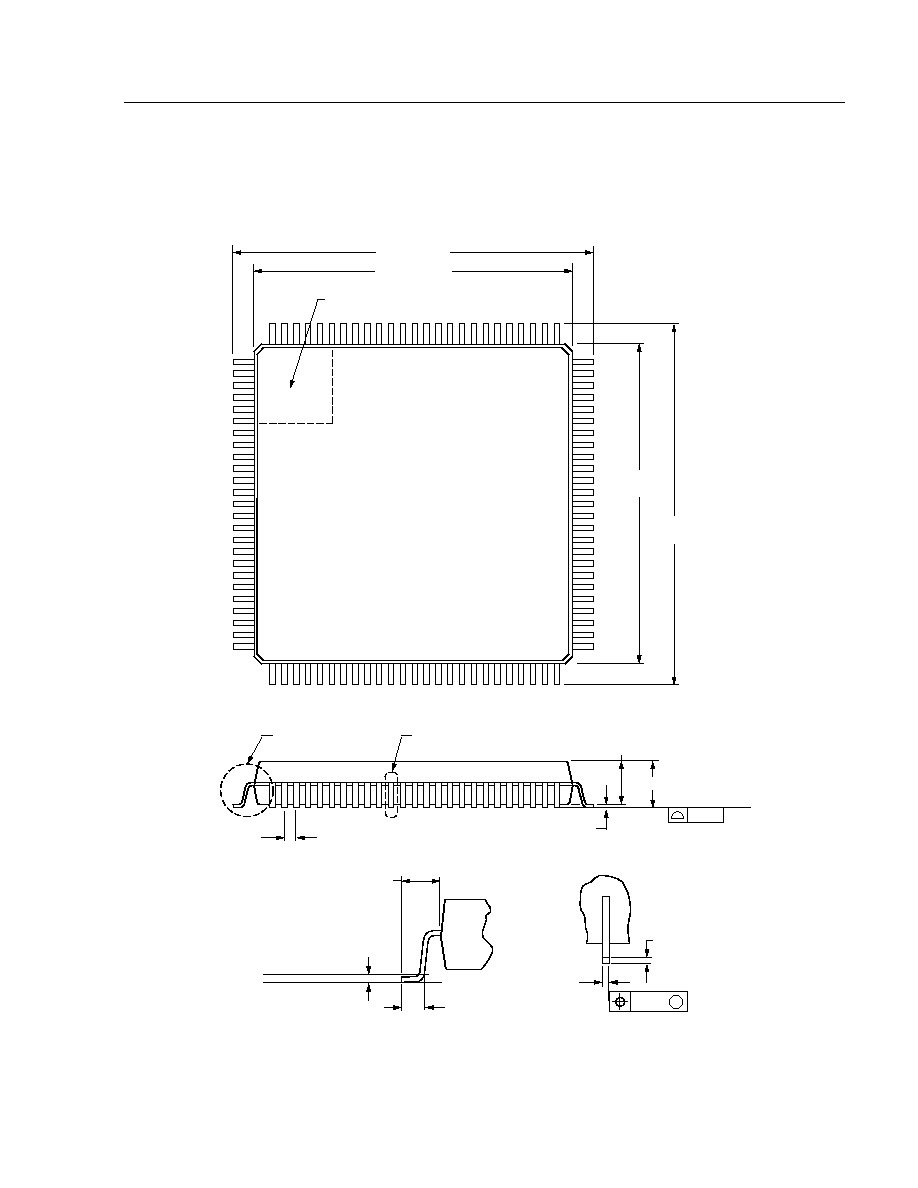
Preliminary Data Sheet
February 1997
DSP1628 Digital Signal Processor
Lucent Technologies Inc.
110
11 Outline Diagrams
(continued)
11.2 100-Pin TQFP (Thin Quad Flat Pack)
All dimensions are in millimeters.
5-2146.r14
0.50 TYP
1.60 MAX
SEATING PLANE
0.08
1.40
±
0.05
0.05/0.15
DETAIL A
DETAIL B
14.00
±
0.20
16.00
±
0.20
76
100
1
25
26
50
51
75
14.00
±
0.20
16.00
±
0.20
PIN #1 IDENTIFIER ZONE
DETAIL A
0.45/0.75
GAGE PLANE
SEATING PLANE
1.00 REF
0.25
DETAIL B
0.19/0.27
0.08
M
0.106/0.200
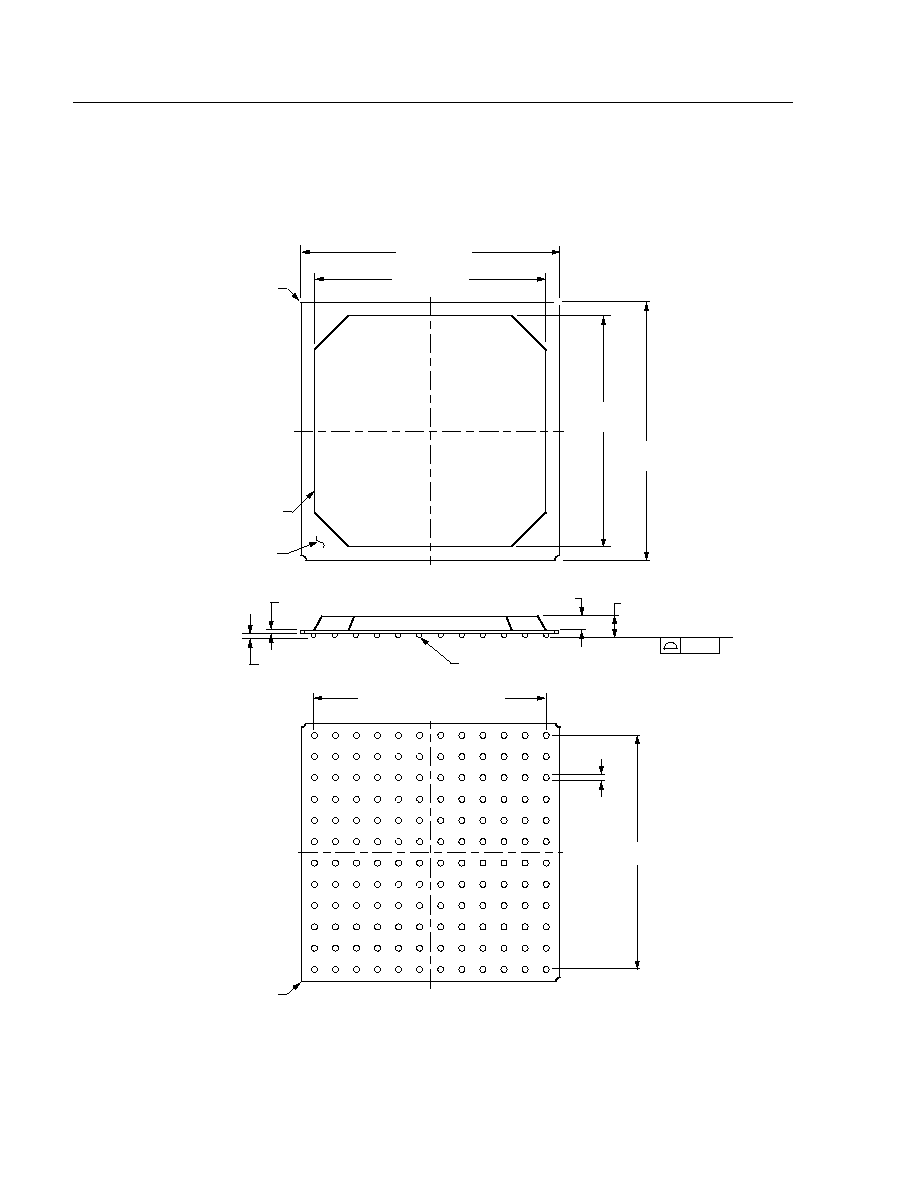
Preliminary Data Sheet
DSP1628 Digital Signal Processor
February 1997
111
Lucent Technologies Inc.
11 Outline Diagrams
(continued)
11.3 144-Pin PBGA (Plastic Ball Grid Array)
All dimensions are in millimeters.
5-5205 (C)
0.36
±
0.04
0.80
±
0.05
1.56 + 0.19
≠ 0.21
SEATING PLANE
SOLDER BALL
0.40
±
0.10
0.20
PWB
MOLD
COMPOUND
PIN A1
CORNER
13.00
±
0.20
13.00
±
0.20
11.50
+0.70
≠0.00
11.50
+0.70
≠0.00
A
B
C
D
E
F
G
H
J
K
L
M
1
2
3
4
5
6
7
8
9
10
11
12
11 SPACES @ 1.00 = 11.00
PIN A1
CORNER
11 SPACES @
1.00 = 11.00
0.50
±
0.10
TOP VIEW
SIDE VIEW
BOTTOM VIEW

For additional information, contact your Microelectronics Group Account Manager or the following:
INTERNET: http://www.lucent.com/micro
U.S.A.: Microelectronics Group, Lucent Technologies Inc., 555 Union Boulevard, Room 30L-15P-BA, Allentown, PA 18103
1-800-372-2447, FAX 610-712-4106 (In CANADA: 1-800-553-2448, FAX 610-712-4106), e-mail docmaster@micro.lucent.com
ASIA PACIFIC:
Microelectronics Group, Lucent Technologies Singapore Pte. Ltd., 77 Science Park Drive, #03-18 Cintech III, Singapore 118256
Tel. (65) 778 8833, FAX (65) 777 7495
JAPAN: Microelectronics Group, Lucent Technologies Japan Ltd., 7-18, Higashi-Gotanda 2-chome, Shinagawa-ku, Tokyo 141, Japan
Tel. (81) 3 5421 1600, FAX (81) 3 5421 1700
For data requests in Europe:
MICROELECTRONICS GROUP DATALINE: Tel. (44) 1734 324 299, FAX (44) 1734 328 148
For technical inquiries in Europe:
CENTRAL EUROPE: (49) 89 95086 0 (Munich), NORTHERN EUROPE: (44) 1344 865 900 (Bracknell UK),
FRANCE: (33) 1 41 45 77 00 (Paris), SOUTHERN EUROPE: (39) 2 6601 1800 (Milan) or (34) 1 807 1700 (Madrid)
Lucent Technologies Inc. reserves the right to make changes to the product(s) or information contained herein without notice. No liability is assumed as a result of their use or application. No
rights under any patent accompany the sale of any such product(s) or information.
Copyright © 1997 Lucent Technologies Inc.
All Rights Reserved
Printed in U.S.A.
February 1997
DS97-040WDSP
Printed On
Recycled Paper

















































































































